Overhead Crane Types: All Types of Overhead Cranes for Sale in China
Your Trusted Overhead Crane Manufacturer & Supplier
Overhead Crane Types: All Types of Overhead Cranes for Sale in China
1 ton - 320 ton cost-effective Chinese types of overhead cranes
Before choosing the specific overhead crane for your application, it is crucial to understand the various types of overhead cranes that are available as well as the features and benefits of each type. You can choose the crane types, working duty class, space requirements, and financial constraints that will work best for you once you have the necessary information.
In this blog, we'll go over the benefits and applications of the five main types of overhead cranes, as well as the available configurations.
5 Main Types of Electric Overhead Cranes
Here are the 5 basic types of overhead cranes :
Light Lifting Equipment:Light lifting equipment - The types of lifting equipment, mainly consisted of Electric hoist, chain hoist, electric chain hoist, miniature hoist, etc.. The light hoisting equipment is designed with the features of light and compact structure, light weight, small size, and strong versatility of parts, etc.
- Manuel chain hoist
- Electric chain hoist
- Electric wire rope hoist
- Monorail hoist and crane systems
- Portable cranes
- Bridge Cranes
Overhead Bridge Crane
Overhead bridge crane - The bridge crane is the most common used material handling equipment. It is erected on the track mounted on the crane runways supported or partially supported by the inner building structure. They are widely used in workshops and warehouses, for loading and unloading works and heavy loads or object handling works indoors and outdoors. They are also called overhead travelling bridge crane, overhead crane, and eot crane, and overhead gantry crane, etc.
- - Single Girder and Double Girder Bridge Cranes
- - Top Running and Underhung Bridge Cranes
Gantry Cranes
Gantry crane - The gantry cranes are similar with bridge crane, with self supporting legs running on the rails, embedded on the ground, instead of on the runway beams supported by building structure. It is generally called gantry crane or Goliath crane in the factory.
- - Single girder gantry crane
- - Double girder gantry crane
Rotating jib crane
Jib type crane - The types of cranes covers portal cranes, fixed slewing cranes, shore-to-shore container bridge cranes, etc.
- Wall travelling crane
- Wall mounted crane
- Floor mounted pillar jib crane
- Workstation Cranes
Workstation Crane
A workstation crane is a type of overhead crane that is designed for light-duty applications and is typically used in a smaller work area, such as a manufacturing cell or assembly station. These cranes are often used to move materials or products from one workstation to another, and they are typically operated manually.
There are several types of workstation cranes, including:
- Freestanding workstation cranes
- Ceiling-mounted workstation cranes
- Kbk crane
Your Trusted Overhead Crane Manufacturer & Supplier
Light lifting equipment: Types of Manual Hoist and Electric Hoists
Manual and Electric Chain Hoist and Electric Wire Rope hoists
Manual chain hoist
It is also called chain block, manual hoist, hand hoist, or hand operated hoist, etc.
It is a manual lifting machine that is easy to use and easy to carry. It is suitable for short-distance lifting and transportation of small equipment and goods. The lifting capacity of manual chain hoist generally does not exceed 100 ton. The shell of the chain hoist is made of high-quality alloy steel, which is strong and wear-resistant, and has high safety performance.
Famous brands of chain hoists -Korea (DK) black bear, Japan (SPEED) Erye, Japanese (KITO) Ghost Head,Japan (TOYO) Toyo,Japan (EAGLE) Eagle,etc.
Manual chain hoists, also known as hand chain hoists, are a type of material handling equipment that are operated manually by pulling a chain to lift and move heavy loads. There are several types of manual chain hoists, including:
- Hook Mounted Manual Chain Hoist: This type of manual chain hoist is mounted on a hook and can be attached to a trolley or other lifting device.
- Trolley Mounted Manual Chain Hoist: This type of manual chain hoist is mounted to a trolley that moves along a beam or track, allowing the hoist to move horizontally as well as vertically.
- Low Headroom Manual Chain Hoist: This type of manual chain hoist is designed for use in areas with limited headroom, where a traditional hoist would not fit.
- Geared Manual Chain Hoist: This type of manual chain hoist is designed for use in applications where precise load control is required. It features a gear system that allows for slow and controlled lifting and lowering of loads.
- Lever Manual Chain Hoist: This type of manual chain hoist is operated by pulling a lever to lift and move loads. It is typically used in applications where the operator needs to maintain control over the load at all times.
- Explosion-proof manual chain hoists are designed for use in hazardous environments where there is a risk of explosion due to the presence of flammable gases or vapors. These hoists are constructed with special materials and features that prevent sparks from being generated during operation, reducing the risk of ignition.
- Stainless steel chain hoists are designed for use in applications where corrosion resistance is important, such as in food processing or marine environments. These hoists are constructed with stainless steel components that are resistant to rust and other forms of corrosion.

Hand chain hoist

Hand push chain hoist
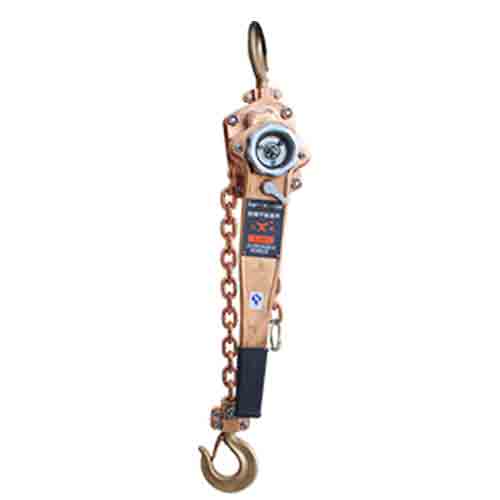
Lever chain hoists

Low headroom chain hoist
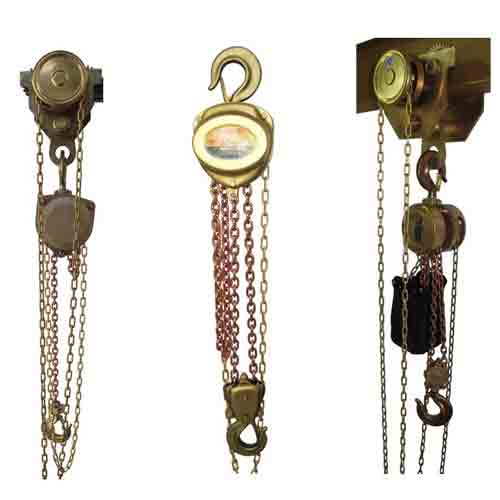
Explosion proof
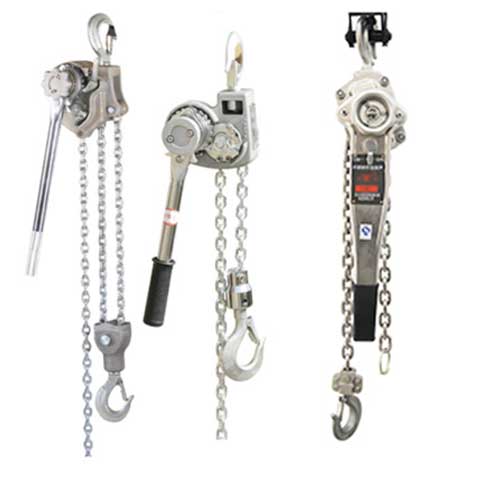
Stainless steel chain hoist
Manual chain hoists are typically used in applications where electricity is not available or where a power source is not practical. They offer several advantages, including:
- Good performance and easy maintenance. They are cost-effective and require minimal maintenance.
- They are easy to operate and require minimal training.
- In line with national standards, safe and reliable, durable.
- Strong toughness, small size, light weight, easy to carry
- Small hand pulling force and high mechanical strength
- Advanced structure and beautiful appearance
- Lifting goods in areas without power supply
- They can be used in a variety of settings, including construction sites, warehouses, and assembly lines.
- However, manual chain hoists also have some limitations, including:
- They have lower lifting capacities than electric or hydraulic hoists.
- They may require more physical effort to operate than other types of hoists.
- They may not be suitable for applications where high speeds or long travel distances are required.
Electric chain hoists
An electric chain hoist is a type of material handling equipment that is used to lift and move heavy loads. It consists of a motorized chain that runs through a hoist unit, which is suspended from a trolley that moves along a beam or track. Electric chain hoists are commonly used in manufacturing and industrial settings.
There are several types of electric chain hoists, including:
- Hook Mounted Electric Chain Hoist: This type of electric chain hoist is mounted on a hook and can be attached to a trolley or other lifting device.
- Trolley Mounted Electric Chain Hoist: This type of electric chain hoist is mounted to a trolley that moves along a beam or track, allowing the hoist to move horizontally as well as vertically.
- Low Headroom Electric Chain Hoist: This type of electric chain hoist is designed for use in areas with limited headroom, where a traditional hoist would not fit.
- Explosion-proof electric chain hoists are designed for use in hazardous environments where there is a risk of explosion due to the presence of flammable gases or vapors. These hoists are constructed with special materials and features that prevent sparks from being generated during operation, reducing the risk of ignition.
- European-style electric chain hoists, also known as low headroom hoists, are designed for use in areas with limited headroom. These hoists feature a compact design that allows them to be installed in areas with low ceilings or other obstructions. They are typically used in manufacturing and industrial settings where space is at a premium.

Electric trolley electric chain hoist

Manual trolley electric chain hoist
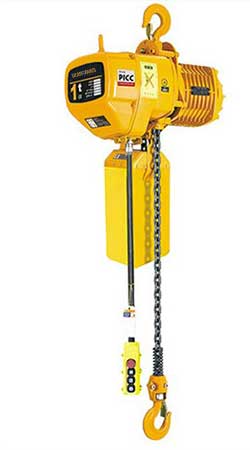
Hook mounted electric chain hoist

Low headroom electric chain hoist
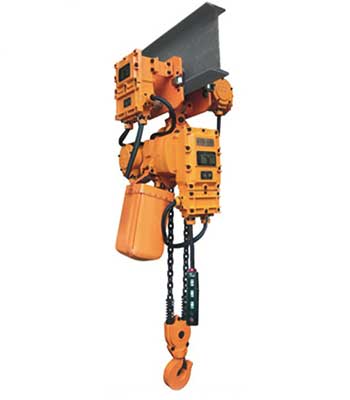
Explosion proof electric chain hoist
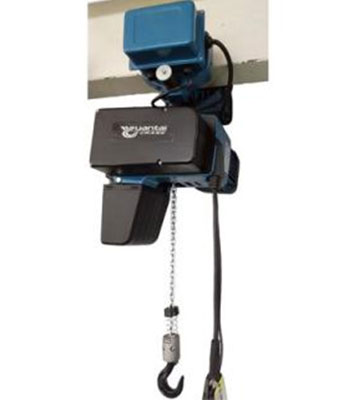
European style electric chain hoist
Features of electric chain hoists include:
- They are available in a range of lifting capacities, from a few hundred pounds to several tons.
- They are easy to operate and require minimal training.
- They can be used in a variety of applications, including assembly lines, warehouses, and construction sites.
- They can be customized to fit specific applications.
Advantages of electric chain hoists include:
- They are cost-effective and require less maintenance than other types of hoists.
- They are easy to install and can be used in a variety of settings.
- They are relatively quiet and produce less vibration than other types of hoists.
- Limitations of electric chain hoists include:
- They have lower lifting capacities than other types of hoists, such as wire rope hoists.
- They may not be suitable for applications where high speeds or long travel distances are required.
- They may require additional support structures to be installed in the building
Electric wire rope hoists
Electric wire rope hoists are a type of material handling equipment that are used to lift and move heavy loads. They consist of a motorized drum that rotates a steel cable or wire rope, which is attached to a hoist unit that moves up and down to lift and lower the load. Electric wire rope hoists are commonly used in manufacturing and industrial settings.
Main series of electric wire rope hoists
The different types of electric wire rope hoists:
- CD1—ordinary single-speed electric hoist: This type of hoist has a single lifting speed and is suitable for applications where precise load control is not required. It is commonly used in manufacturing and industrial settings.
- MD1—ordinary two-speed electric hoist: This type of hoist has two lifting speeds and is suitable for applications where precise load control is required. It is commonly used in manufacturing and industrial settings.
- YH—metallurgical electric hoist: This type of hoist is designed for use in metallurgical applications, such as steel mills or foundries. It is constructed with specialized materials that can withstand high temperatures and harsh environments.
- BCD—Explosion-proof electric hoist: This type of hoist is designed for use in hazardous environments where there is a risk of explosion due to the presence of flammable gases or vapors. It is constructed with special materials and features that prevent sparks from being generated during operation, reducing the risk of ignition.
- GD(CD)—Low Headroom Single Speed Electric Hoist: This type of hoist is designed for use in areas with limited headroom, where a traditional hoist would not fit. It has a compact design that allows it to be installed in areas with low ceilings or other obstructions.
- GSD(MD)—low headroom two-speed electric hoist: This type of hoist is similar to the GD(CD) hoist, but has two lifting speeds and is suitable for applications where precise load control is required.
All of these types of electric wire rope hoists offer several advantages, including:
- They are available in a range of lifting capacities to meet specific application requirements.
- They offer precise load control and can be used to move materials in a variety of directions.
- They can be operated remotely, which increases operator safety and allows for greater flexibility in operation.
- However, each type of hoist also has its own unique features and limitations, which should be considered when selecting the appropriate hoist for a particular application.
Marking explanation:
Take a metallurgical electric hoists for example. If the required specifications are as following:
- The rated lifting capacity is 5 ton.
- The lifting height is 12m, and
- the working duty of metallurgical use trolley travelling electric wire rope hoist is M6.
The electric hoist with above specifications shall be marked as: YH 5t-12m M6
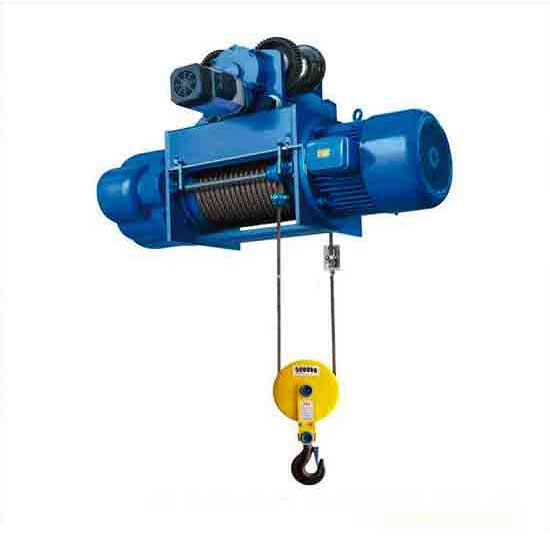
Cd/md
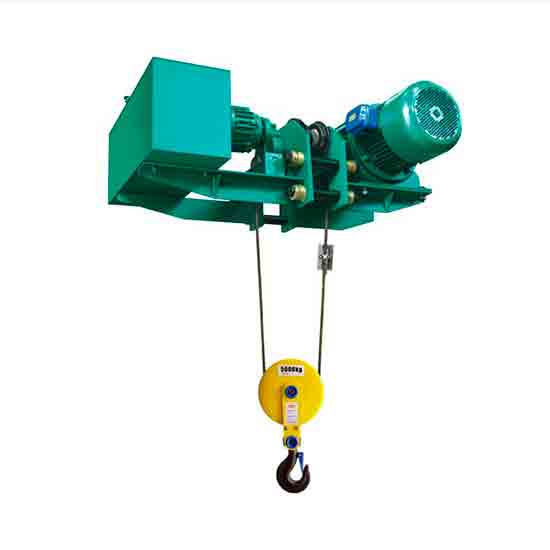
Low headroom

Explosion proof
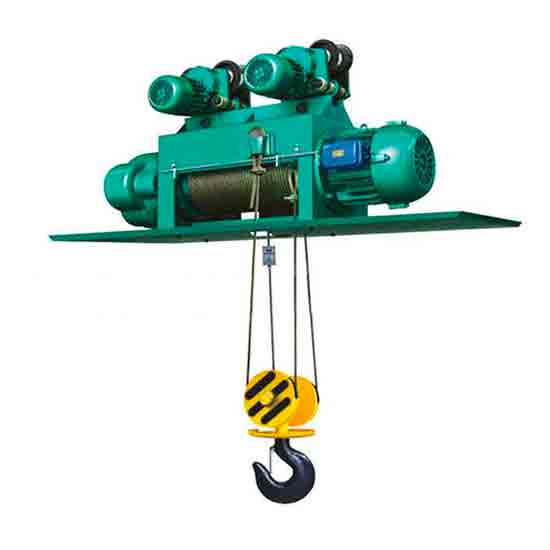
Metallurgical

Fixed wire rope hoist
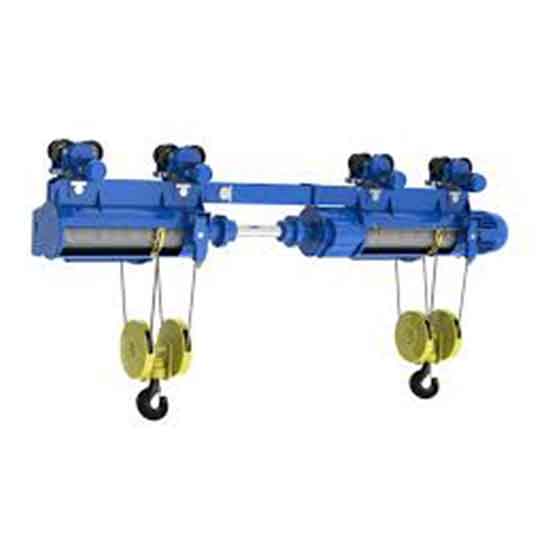
Double hook
Monorail Hoists and Monorail Crane System
Monorail hoists and monorail cranes are types of material handling equipment that are commonly used in manufacturing and industrial settings.
A monorail hoist is a type of hoist that runs on a single rail or beam, while a monorail crane consists of a single girder bridge that runs on a single rail or beam.Molds and dimensions of I beams-P15 14.2kg/m , P18 17.2kg/m, P22 21.2kg/m, P24 23.2kg/m , P30 28.2kg/m ,P38 37kg/m ,P43 42.3kg/m,QU70 51kg/m , QU80 61.3kg/m, QU100 84.3kg/m , QU120 113kg/m .
There are several types of monorail cranes, including:
- Underhung Monorail Crane: This type of monorail crane is suspended from the building structure and runs on a single rail or beam.
- Top Running Monorail Crane: This type of monorail crane runs on a single rail or beam that is supported by columns or other structures.
- Single Girder Monorail Crane: This type of monorail crane consists of a single girder bridge that runs on a single rail or beam.
Features of monorail cranes include:
- They require less space than traditional overhead cranes.
- They can be customized to fit specific applications.
- They can be used to move materials in a straight line or along a curved path.
- Advantages of monorail cranes include:
- They are cost-effective and require less maintenance than traditional overhead cranes.
- They can be used in areas with limited space.
- They can be used to move materials in a variety of directions.
- Limitations of monorail cranes include:
- They have lower lifting capacities than traditional overhead cranes.
- They may not be suitable for applications that require high-speed or long-travel movements.
- They may require additional support structures to be installed in the building.
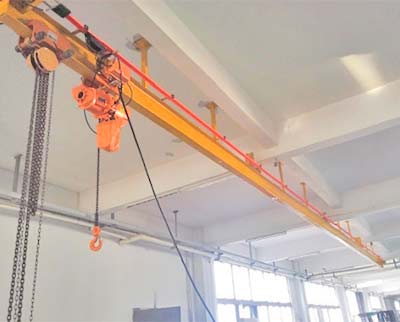
Ceiling mounted monorail cranes with H beam
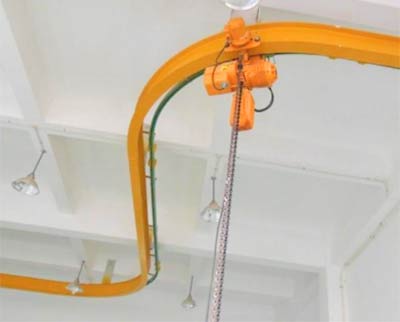
Ceiling mounted monorail crane with curved beam
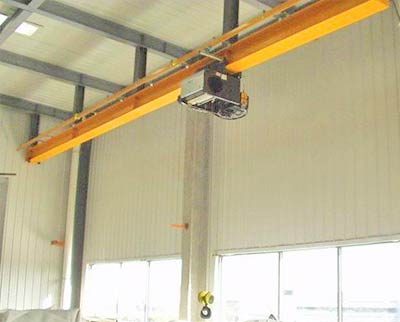
Straight monorail crane with european style hoist
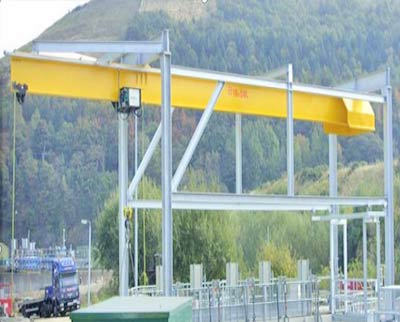
Freestanding monorail cranes
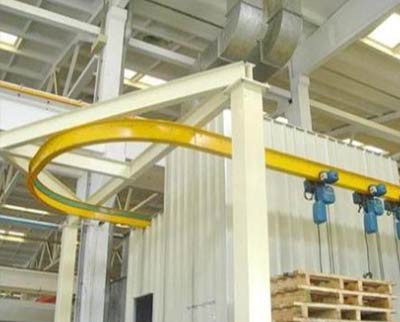
U shape monorail rail
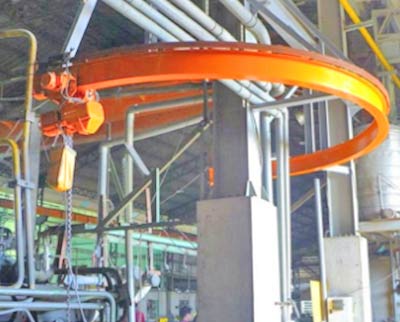
Curved monorail rail
Your Trusted Overhead Crane Manufacturer & Supplier
Bridge Cranes
Single / Double Girder & Top Running / Underhung Crane
Bridge cranes, also known as overhead cranes, are a type of material handling equipment that are commonly used in industrial and manufacturing settings. They consist of a bridge or beam that spans the width of a building, and one or more hoists that move along the bridge to lift and move heavy loads.
Main types of bridge cranes
Bridge cranes can be classified into different classifications based on different standards. In the following, main types of overhead crane types are presented for your reference.
1. According to overhead crane structure: There are single-girder bridge crane type, double-girder bridge crane type, multi-girder bridge crane such as four girder crane for casting industry, double trolley bridge type, and multi hoist and trolley bridge crane type, etc.
2. According to the pick-up device/ below-hook-devices: They can be classified hook bridge crane, grab bridge crane, electromagnetic bridge crane, container bridge crane, etc.
3. According to the purpose or applications: There are general bridge crane, metallurgical bridge crane, explosion-proof bridge crane and so on.
Single girder & Double Girder Bridge Cranes
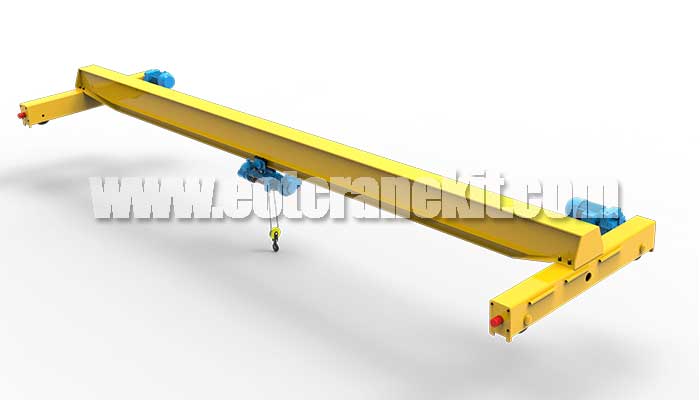
Single girder bridge cranes
Single Girder Cranes - The crane consists of a single bridge girder supported on two end trucks. It has a trolley hoist mechanism that runs on the bottom flange of the bridge girder.
Basic structure of Chinese style electric single girder crane
- Bridge frame with operating mechanism and electric hoist moving along the lower flange of main beam which consisted of U shaped box girder and I beam steel.
- Electric hoist - is used for lifting heavy objects and running along the main beam, which is used as the lifting trolley of the bridge crane.
- Composition: bridge frame + crane running mechanism + electric hoist + electrical equipment.
- Features: Large lifting capacity, high working speed and high production efficiency.
- Main specifications - 1-20 ton
The advantages of double girder overhead cranes include high lifting capacity, increased height, greater stability, customizability, and versatility. Additionally, overhead cranes do not require floor space, making them ideal for industrial settings with limited space.
Main types of Single Girder Overhead Crane
The main types and moldes of bridge cranes in China are marked with the following:
- LD - electric single beam crane (LDA)
- LX— electric single girder suspension crane
- LB— Explosion-proof electric single beam crane
- LDY—Metallurgical Electric Single Girder Crane
- SL— Manual Single Beam Crane
- SLX—Manual Single Girder Suspension Crane
- LDP -low headroom single girder overhead crane
- LDE - Single girder overhead crane with double hoist trolley
- LZ - Single girder overhead crane with grab bucket
- HD- single girder overhead crane with European style design
- NLX -European type single girder suspension overhead crane

Double girder bridge crane
Double Girder Bridge Cranes - The crane consists of two bridge girders supported on two end trucks. The trolley runs on rails on the top of the bridge girders.
Main structure of double girder bridge crane
- Generally, it consists of a bridge frame, a crab hoist trolley running mechanism, a lifting trolley mechanism (with a lifting system and travelling trolley system ), crane operating system and electrics, etc.
- The double beam bridges are mainly consisted of main girder, end girder, trolley running track, railing, walking platform, driver's cab, etc.
- It is the main component of the bridge crane,which bears various loads, and should have sufficient rigidity and strength. Strength is the ability to resist fracture, and stiffness is the ability to resist deformation.
- Features - Material: Q235B or Q345B , Structural form: box type
- Main specification- 1 -320 ton
Because the main girder of the box structure has many advantages such as high overall rigidity, good manufacturing, assembly, transportation and maintenance conditions,and it is widely used at home and abroad.
Main types of overhead cranes
The main types and molds of bridge cranes made in China are marked as the following :
- LH— electric hoist bridge crane ( Comparied with Euroepan type electric hoist overhead crane )
- QD— Hook Overhead Crane (Universal Overhead Crane) ( Comparison with European type double girder overhead crane )
- QDY—casting bridge crane
- QZ— Grab bridge crane
- QB— Explosion-proof bridge crane
- QE— double trolley hook bridge crane
- QY— insulated bridge crane
- QC— Electromagnetic Bridge Crane
- QG— Hanging girder bridge crane
- QL— Electromagnetic hanging beam bridge crane
- SQ— Manual Double Girder Crane
- LHB—Explosion-proof electric hoist bridge crane
Types of traditional single girder overhead crane economical price

Crane type:LDA
Lifting capacity:1-20ton
Lifting height6-30m
Crane span:7.5-28.5m
Working class:A3-A5

Crane type:LX
Lifting capacity:0.5-10ton
Lifting height6、9、12、18m
Crane span:3-16m
Working class:A3-A5

Crane type:LB
Lifting capacity:1-16ton
Lifting height6、9、12、18、24m
Crane span:7.5-28.5m
Working class:A3

Crane type:LX explosion proof overhead crane
Lifting capacity:0.5-10ton
Lifting height6、9、12、18m
Crane span:3-16m
Working class:A3

Crane type:LDY
Lifting capacity:1-10ton
Lifting height9、12、15、18、20m
Crane span:7.5-28.5m
Working class:A6
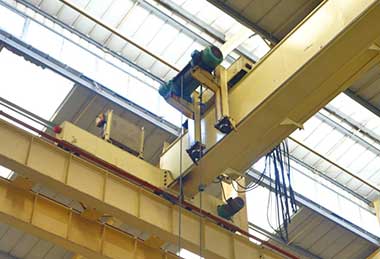
Crane type:LDP
Lifting capacity:3~10ton
Lifting height6、9、12m
Crane span:7.5-22.5m
Working class:A3、A4

Crane type:LDE
Lifting capacity:(5+5)ton(10+10)ton
Lifting height6、9、12、18、24、30m
Crane span:7.5-22.5m
Working class:A3

Crane type:SL
Lifting capacity:1-5ton
Lifting height1-6m
Crane span:1-10M
Working class:A3

Crane type:LDZ
Lifting capacity:3-10ton
Lifting height9、12、15、18、20m
Crane span:4.5-28.5m
Working class:A5
Types of Chinese type double girder bridge cranes, reliable and cost-effective

Crane type:LH
Lifting capacity:5、10/3、16/3、20/5、32/10ton
Lifting height6、9、12、18、24、30m
Crane span:7.5-25.5m
Working class:A3-A5

Crane type:QD
Lifting capacity:5-450ton
Lifting height26m
Crane span:10.5-31m
Working class:A5、A6

Crane type:QB
Lifting capacity:5-75ton
Lifting height14-22m
Crane span:10.5-31.5m
Working class:A4

Crane type:QE
Lifting capacity:5-16ton
Lifting height16m
Crane span:10.5- 31.5m
Working class:A5、A6

Crane type:QDY
Lifting capacity:< 75ton
Lifting height20m
Crane span:10.5-31.5m
Working class:A7

Crane type:QZ
Lifting capacity:5、10、16、20ton
Lifting height18、20、26、28m
Crane span:10.5-31.5m
Working class:A6

Crane type:QC
Lifting capacity:5-32/5ton
Lifting height18m
Crane span:10.5-31.5m
Working class:A6

Crane type:QL
Lifting capacity:(5+5)-(20+20)ton
Lifting height12-16m
Crane span:10.5-31.5m
Working class:A6、 A7

Crane type:QN
Lifting capacity:5、10、16ton
Lifting height22m
Crane span:10.5-31.5m
Working class:A6
Under Running (U/R) & Top Running (T/R) Bridge Travelling Cranes
Top running vs. underhung
This is the section of the bridge where the trolley and hoist system is installed and operates.
- Top-running configurations -Due to the fact that the trolley and hoist are supported by the runway support columns, top-running configurations are perfect for lifting extremely heavy loads.
- Under hung crane configurations - In an underhung configuration, the trolley and hoist are connected and run along the bridge's lower flange. Underhung trolley and hoist configurations are an excellent way to maximize space in your facility.

Top Running Cranes
Oveview - The crane bridge travels on top of rails mounted on a runway beam supported by either the building columns or columns specifically engineered for the crane. Top running canes are the most common form of crane design where the crane loads are transmitted to the building columns or free standing structure. These cranes have the greatest variation in capacity, span and service class and usually span the full width of the framing supports. These are available in both single girder and double girder configuration.
Basic structure of single girder top running crane
A top running single girder overhead crane is a type of crane that has a single beam spanning the width of a building and is supported by two end trucks. The hoist and trolley run on the bottom flange of the beam.
Advantages of a top running single girder overhead crane include:
- Cost-effective: Single girder cranes are generally less expensive than double girder cranes.
- Space-saving: Single girder cranes take up less space than double girder cranes, making them ideal for smaller facilities.
- Ease of maintenance: Because there is only one girder, maintenance is generally easier and less time-consuming.
Limitations of a top running single girder overhead crane include:
- Lower capacity: Single girder cranes typically have a lower capacity than double girder cranes.
- Limited span: Single girder cranes are typically limited in span compared to double girder cranes.
- Limited lift height: Single girder cranes may not be able to lift loads as high as double girder cranes.
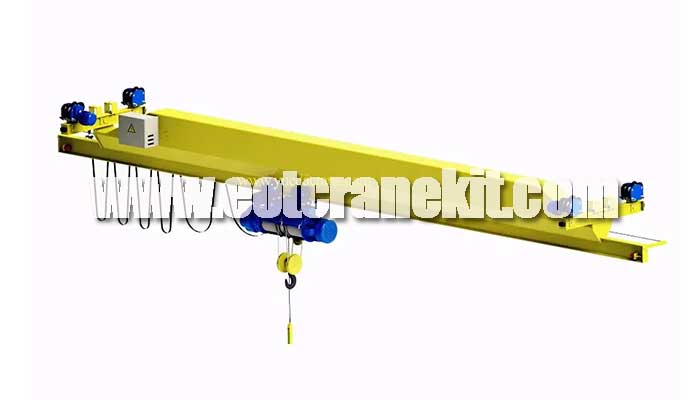
Under running cranes
Overview - Under running or under slung cranes are supported by using a suspension type support which is connected to the bottom of the frame. The crane wheels are supported from the bottom of flange of the crane beams which act as a crane rail and usually only span a portion of the column-to-column span of the structure. Under running cranes are typically available in standard capacities up to 10 tons (special configurations up to 25 tons and over 90 ft spans). Under hung cranes offer excellent side approaches, close headroom and can be supported on runways hung from existing building members if adequate.
Basic structure of electric single girder suspension crane
The underhung bridge crane is basically similar to the top running electric single-girder crane. The main difference is that the underrunning crane is not supported and travelling on the top of runway beams between the spans of the building, but is suspended on the lower flange of the I-beam by using four pulleys mounted on the beam.
Advantages:
- simple structure, light weight, cheap price.
- And they can be installed on the ceiling or roof structure and used in relatively low factory buildings or warehouses, which is an cost-effective bridge crane by saving the cost of the crane supporting columns.
Limitations:
- There must be a roof truss or beam of sufficient strength to bear the self-weight, lifting load and dynamic load of the crane, so the lifting capacity of this underslung bridge crane should not be too large.
- At present, the maximum lifting capacity of undehrung bridge crane made by Chinese crane manufacturers and supplier are 10 ton.
Bridge cranes types based on the lifting devices
According to the pick-up device: such as hook bridge crane, grab bridge crane, electromagnetic bridge crane, container bridge crane, etc.
Overhead cranes are a type of material handling equipment that are used to lift and move heavy loads in manufacturing and industrial settings. There are several types of overhead crane attachments that can be used to increase the versatility and functionality of these cranes. Here are some examples:

Hook
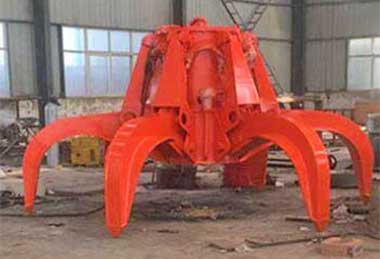
grab
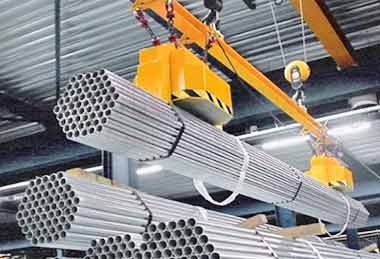
magnets
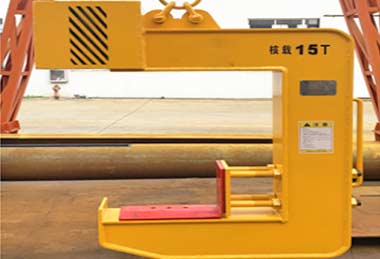
c hook
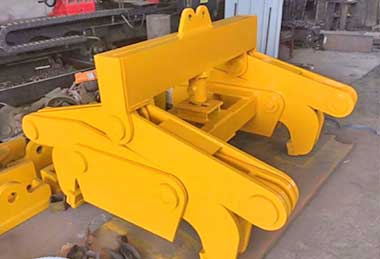
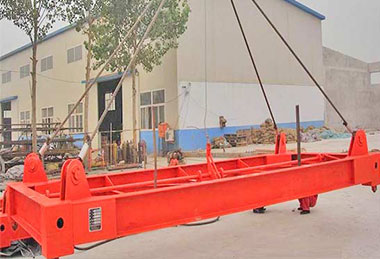
Spreader
- Hook Block: This is a basic attachment that is used to lift loads using a hook. Hook blocks are available in a range of sizes and capacities to meet specific application requirements.
- Lifting Magnets: These attachments use magnetic force to lift and move ferrous materials, such as steel plates or sheets. They are commonly used in metalworking and fabrication applications.
- Grabs: These attachments are used to lift and move bulk materials, such as sand, gravel, or scrap metal. They come in a variety of designs, including clamshell grabs, orange peel grabs, and bucket grabs.
- C-Hooks: These attachments are used to lift and move coils or other cylindrical loads. They are designed with a curved shape that allows them to securely grip the load.
- Spreader Beams: These attachments are used to distribute the weight of a load evenly across multiple lifting points. They are commonly used in applications where a load is too long or awkwardly shaped to be lifted with a single attachment point.
- Vacuum Lifters: These attachments use suction cups or a vacuum to lift and move materials, such as glass or plastic sheets. They are commonly used in manufacturing and assembly applications.
- Pallet Lifters: These attachments are used to lift and move pallets or other large containers. They are designed with fork-like tines that can be inserted into the pallet or container.
- Each type of overhead crane attachment offers its own unique advantages and limitations, and should be selected based on the specific requirements of the application.
Types of overhead cranes based on the uses or functions
According to the purpose or functions of cranes, the bridge cranes can be classified into general use bridge crane, metallurgical bridge crane, explosion-proof bridge crane and so on.
Overhead crane types | Classification | Application |
General overhead crane | Hook overhead crane, grab bridge crane, electromagnetic bridge crane, 2- purpose overhead crane, 3- purpose overhead crane | Machining workshop, assembly workshop, power plant, warehouse, storage yard |
Metallurgical bridge crane | Casting bridge crane, clamp crane, ingot stripping crane, feeding crane and forging crane | Steel Plant |
Explosion-proof bridge crane/ Hazardous use overhead cranes | Explosion-proof bridge crane for coal mine; explosion-proof bridge crane for factory | Coal mines, factories with flammable and explosive mixtures |
Your Trusted Overhead Crane Manufacturer & Supplier
Gantry Crane
Main types of gantry cranes
With gantry cranes, the trolley and hoist mechanism still travels along a bridge but is supported by legs rather than runways. They are therefore perfect for outdoor situations where installing columns is not an option. For instance, fixed- or track-mounted gantry cranes are frequently utilized for those applications in shipyards and railyards.
Gantry cranes are adaptable and come in portable and adjustable models. Gantry cranes are especially helpful in situations where lifting is not usually needed, like in a motor repair shop, etc.
Main types of gantry cranesBased on different classifications standards, the gantry cranes can be classified into different crane types:
There are many classifications of gantry cranes:
- 1. According to the structure: single main girder gantry crane, double main girder gantry crane, box type or truss type gantry crane.
- 2. According to the cantilever: single cantilever gantry crane, double cantilever, no cantilever gantry crane, etc.
- 3. According to the support method: rail-mounted gantry cranes, tire-type gantry cranes.
- 4. According to the pick-up device: hook gantry crane, grab gantry crane, electromagnetic gantry crane, etc.
- 5. According to the application occasion: general purpose gantry crane, shipbuilding gantry crane, hydropower station gantry crane, etc.
Single girder gantry crane & double girder gantry cranes
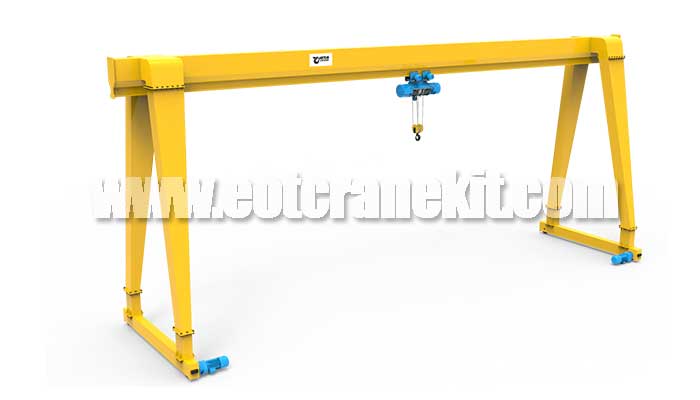
A single girder gantry crane is a type of gantry crane that has a single main girder spanning between two legs. It is commonly used in outdoor applications, such as in shipyards, construction sites, and storage yards.
Features of a single girder gantry crane include:
- Cost-effective: Single girder gantry cranes are typically less expensive than double girder gantry cranes, making them a cost-effective solution for many outdoor lifting applications.
- Versatile: Single girder gantry cranes can be designed to handle a wide range of load capacities and sizes, making them suitable for a variety of applications.
- Easy to install: Single girder gantry cranes are typically easier to install than other types of cranes, such as bridge cranes or jib cranes.
- Space-saving: Single girder gantry cranes take up less space than other types of cranes, such as bridge cranes or jib cranes. This makes them ideal for use in areas where space is limited.
- Mobility: Single girder gantry cranes can be mounted on wheels or rails for mobility, allowing them to be easily moved between work areas.
Overall, single girder gantry cranes are a versatile and cost-effective solution for many outdoor lifting applications. They offer a range of features and can be customized to meet the specific needs of a particular application.
Types of single girder gantry crane
- The symbols are: MDG, MDE, MDZ, MDC, MDN, MDP, MDS, MH, MBH
- Such as: MDG- single girder single trolley hook gantry crane
- MDE- Single girder double trolley hook gantry crane
- MDZ- Single Beam Grab Gantry Crane
- MDC- Single Beam Electromagnetic Gantry Crane
- MDN—single girder single trolley grab hook gantry crane
- MDP-S ingle Beam Grab Electromagnetic Gantry Crane
- MDS—Single girder three-purpose gantry crane
- MH— electric hoist gantry crane
- MBH-Electric hoist semi-gantry crane
- Portable gantry crane - Fixed height & adjustable height gantry cranes
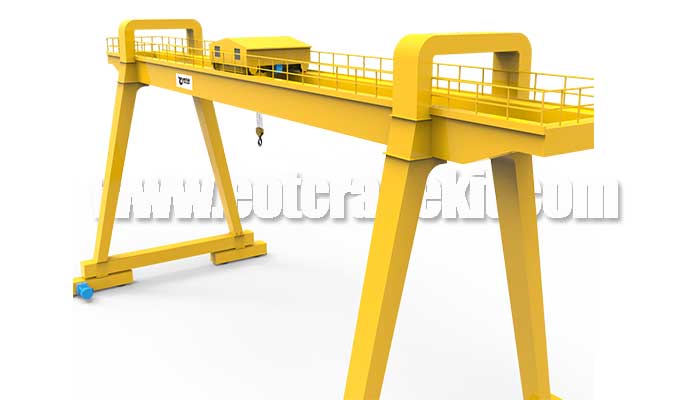
Double girder gantry cranes are heavy-duty cranes that are used to lift and move large and heavy objects in industrial settings such as factories, shipyards, and construction sites.
Features of double girder gantry cranes include:
- High lifting capacity: Double girder gantry cranes have a higher lifting capacity than single girder gantry cranes, making them ideal for lifting and moving heavy loads.
- Increased height: The double girder design allows for a higher hook height, which is beneficial for lifting and moving objects that require additional clearance.
- Greater stability: Double girder gantry cranes are more stable than single girder gantry cranes, which allows for greater precision during lifting and movement.
- Customizable: Double girder gantry cranes can be customized with various lifting attachments and safety features to meet specific industrial needs.
- Versatile: Double girder gantry cranes can be used in both indoor and outdoor settings, making them a versatile option for various industries.
Double girder gantry cranes have several advantages, including high lifting capacity, increased height, greater stability, customizability, and versatility. These features make them an ideal choice for lifting and moving heavy loads in various industrial settings.
Types of Double girder gantry crane
- The symbols are: MG, ME, MZ, MC, MP, MS, RMG, RTG
- Such as: MG—double girder single trolley hook gantry crane
- ME—Double girder double trolley hook gantry crane
- MZ- double girder grab bucket gantry crane
- MC-Double beam electromagnetic gantry crane
- MP- Double Beam Grab Electromagnetic Gantry Crane
- MS- Double girder three-purpose gantry crane
- RMG- Rail Mounted Container Gantry Crane
- RTG-Tire Type Container Gantry Crane
Types of gantry cranes based on gantry supporting legs

Crane type:MH
Lifting capacity:3-16ton
Lifting height9m
Crane span:12-30m
Working class:A3

Crane type:MG
Lifting capacity:Up to 500ton
Lifting height12m
Crane span:18-35m
Working class:A5

Crane type:MHZ
Lifting capacity:5-10ton
Lifting height9m
Crane span:12-30m
Working class:A5

Crane type:MDG
Lifting capacity:5-32/5ton
Lifting height11m
Crane span:18-35m
Working class:A5

Crane type:MZ
Lifting capacity:5ton、10ton
Lifting height18m
Crane span:18-35m
Working class:A6

Crane type:L
Lifting capacity:5-10ton
Lifting height9m
Crane span:16-30m
Working class:A5

Crane type:MHE
Lifting capacity:(1+1)-(20+20)ton
Lifting height7.5-22m
Crane span:5-20m
Working class:A3-A5

Crane type:MHB
Lifting capacity:5-10ton
Lifting height6m
Crane span:10-20m
Working class:A4

Crane type:BMH
Lifting capacity:5-10ton
Lifting height6m
Crane span:10-20m
Working class:A4

Crane type:Portable gantry crane
Lifting capacity:1-5ton
Lifting height6m
Crane span:10m
Working class:light duty
- A-frame gantry crane type: This type of gantry crane has two vertical A-shaped legs that are connected at the top by a horizontal beam. The trolley, which carries the load, runs along the horizontal beam. This design offers high stability and is suitable for heavy-duty lifting applications.
- U-shaped gantry crane type: This type of gantry crane has two parallel legs that are connected by a U-shaped cross beam. The trolley runs along the bottom flange of the cross beam, and the U shape of the beam provides additional stability. This design is suitable for heavy-duty lifting applications where stability is important.
- L-shape leg gantry crane type: This type of gantry crane has two legs that are shaped like an L. The trolley runs along the bottom flange of the cross beam, and the L shape of the legs provides good stress conditions. This design is suitable for applications where there is limited space for goods to pass through horizontally.
- C-type gantry crane type: This type of gantry crane has two legs that are shaped like a C. The trolley runs along the bottom flange of the cross beam, and the C shape of the legs provides a large horizontal passing space. This design is suitable for applications where there is a need for a large horizontal passing space.
- Semi-gantry crane/single leg gantry crane type: This type of gantry crane has one end of the main beam supported by a vertical leg, while the other end is supported by a runway on the ground. The trolley runs along the bottom flange of the main beam. This design is suitable for applications where there is limited space for installation.
- Truss type gantry cranes: This type of gantry crane has a main beam that is constructed with truss members. The trolley runs along the bottom flange of the main beam, and the truss design provides high strength and stability. This design is suitable for heavy-duty lifting applications.
- Each structural form of gantry crane offers its own unique advantages and limitations, and should be selected based on the specific requirements of the application. Factors to consider when selecting a gantry crane include lifting capacity, span, height, mobility, and support structure for installation.
Selection of Gantry Cranes
1. Selection of single main girder and double girder gantry cranes
Choose according to the lifting tonnage, working speed and cargo size.
- The single main girder type is used when the span is less than 35 meters and there is no special requirement under 50 tons.
- Double-girder type is used when the width of the door foot is large, the working speed is high, or long pieces are often lifted.
2. Span and cantilever length - According to the main factors affecting the crane's self-weight, the span should be kept as small as possible while meeting other requirements.
3. Determination principle of wheelbase - Meet stability requirements; Transverse passability of goods; General wheelbase B=(1/4~1/6)S.
4. Determination of the distance between gantry cranes
During work, there should be a certain space between the external dimensions of the gantry crane and the cargo and transport vehicle passages in the yard to facilitate loading and unloading operations. Generally, when the transport vehicles are loaded and unloaded within the span, there should be a distance of more than 0.7m from the door legs. There should be a distance of more than 0.5m between the spreader and the transport vehicle when it is not working, and a distance of more than 0.5m when the goods pass through the door legs.
Your Trusted Overhead Crane Manufacturer & Supplier
Jib Crane & Cantilever Crane
Main types of jib cranes
Jib cranes are ideal for areas with insufficient headroom and structural support, providing versatile and cost-effective lifting solutions. Jib cranes have limited movement because they cannot move around a facility, but they can be used as supplements to regular traveling cranes and monorail tracks. They can also be used in bays, as well as along the walls and sides of stores. Jib cranes provide 180- or 360-degree movement when mounted to the floor or a wall.
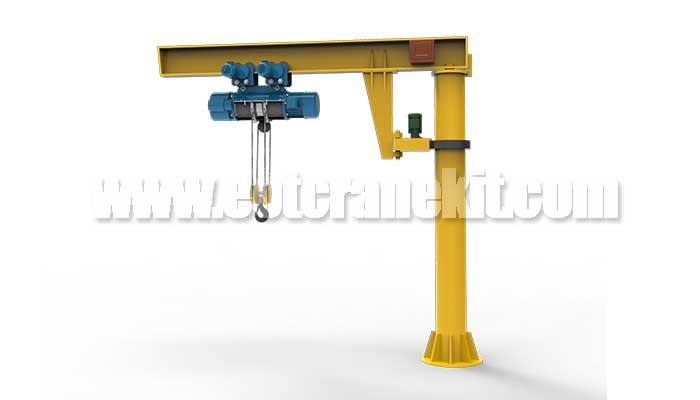
Floor jib crane

Wall jib cranes
Advantages of jib cranes include:
- Versatility: Jib cranes are available in a range of sizes and lifting capacities, making them suitable for a variety of applications. They can be used to lift and move loads in a variety of directions, making them ideal for applications where precise load placement is required.
- Space-saving: Jib cranes take up less floor space than other types of cranes, such as bridge cranes or gantry cranes. This makes them ideal for use in areas where space is limited.
- Cost-effective: Jib cranes are generally less expensive than other types of cranes, making them a cost-effective solution for many applications.
- Easy to install: Jib cranes can be installed quickly and easily, often with minimal disruption to existing operations.
- Increased safety: Jib cranes can be operated remotely, which increases operator safety and reduces the risk of accidents. They also offer precise load control, which reduces the risk of damage to the load or surrounding equipment.
- Overall, jib cranes are a versatile and cost-effective solution for many material handling applications. They offer several advantages over other types of cranes, including space-saving design, easy installation, and increased safety.
Limitations of jib cranes
- While jib cranes offer several advantages, they also have some limitations that should be considered when selecting the appropriate material handling equipment for a particular application. Some limitations of jib cranes include:
- Limited lifting capacity: Jib cranes typically have a lower lifting capacity than other types of cranes, such as bridge cranes or gantry cranes. This makes them unsuitable for applications that require lifting very heavy loads.
- Limited reach: Jib cranes have a limited reach compared to other types of cranes. This means that they may not be suitable for applications where the load needs to be moved over a large distance.
- Limited mobility: Jib cranes are typically mounted in a fixed location and cannot be moved easily. This means that they may not be suitable for applications where the load needs to be moved to different locations within a facility.
- Limited height: Jib cranes are typically mounted at a fixed height, which may not be suitable for applications where the load needs to be lifted to a great height.
- Space limitations: While jib cranes are space-saving compared to other types of cranes, they still require a certain amount of space for installation. This means that they may not be suitable for applications where space is extremely limited.
Overall, jib cranes are a versatile and cost-effective solution for many material handling applications. However, their limitations should be carefully considered when selecting the appropriate equipment for a particular application.

Crane type:BZD pillar jib crane
Lifting capacity:0.125-5ton
Lifting height3m
Arm length:3-6m
Lifting height:2-8m/min

Crane type:BX wall mounted jib crane
Lifting capacity:0.125-3ton
Lifting height3m
Arm length:3-6m
Lifting height:2-8m/min

Crane type:BB wall travelling jib crane
Lifting capacity:1-5ton
Lifting height: As request
Arm length:4-12m
Lifting height:8m/min

Crane type:Articulating jib crane
Lifting capacity:0.125-0.5ton
Lifting height3m
Arm length:3-4m
Lifting speed:2-8m/min

Crane type:Portable jib crane
Lifting capacity:0.125-0.5ton
Lifting height3m
Arm length:3m
Lifting height:8m/min

Crane type:Double arm jib crane
Lifting capacity:0.125-5ton
Lifting height3m
Arm length:3-5m
Lifting speed:2-8m/min
- Freestanding pillar jib crane: This type of jib crane is mounted on a freestanding pillar or column, which provides support and stability. It is commonly used in outdoor applications, such as loading docks or construction sites.
- Foundationless jib cranes: This type of jib crane does not require a foundation or concrete pad to be installed. Instead, it is mounted directly to the existing floor or concrete slab. It is commonly used in applications where a permanent foundation is not practical or cost-effective.
- Wall-travelling jib crane: This type of jib crane is mounted on a track that allows it to move horizontally along a wall or other structure. It is commonly used in applications where space is limited or where a freestanding crane would not fit.
- Wall-mounted jib crane: This type of jib crane is mounted directly to a wall or other vertical structure. It is commonly used in manufacturing and industrial settings where a permanent lifting solution is required.
- Portable jib crane: This type of jib crane is designed to be moved from one location to another as needed. It is typically mounted on a wheeled base that allows it to be easily transported.
- Articulating jib crane: This type of jib crane has a flexible arm that can be adjusted to reach loads in tight or hard-to-reach spaces. It is commonly used in manufacturing and assembly applications where precise load placement is required.
Each type of jib crane offers its own unique advantages and limitations, and should be selected based on the specific requirements of the application. Factors to consider when selecting a jib crane include lifting capacity, reach, height, and mobility, as well as the available space and support structure for installation.
Your Trusted Overhead Crane Manufacturer & Supplier
Workstation Cranes & Cell Cranes
Main types of workstation bridge cranes
Workstation cranes provide a convenient and ergonomic design for repetitive activities and lightweight applications (up to 2 tons). Workstation cranes, which come in a wide range of sizes and lifting capacities, can be set up as over-hung systems or standalone buildings in your company, to assist enhance safety, uptime, and productivity in your business.
A workstation crane is a type of overhead crane that is designed to lift and move loads within a limited area, typically within a workstation or production cell. It is a smaller and more lightweight version of a traditional overhead crane, and is commonly used in manufacturing and assembly applications.

Freestanding workstation crane

Ceiling-mounted workstation crane
There are two main types of workstation cranes:
- Freestanding workstation crane: This type of workstation crane is mounted on a freestanding support structure, such as a column or post. It can be easily moved and repositioned as needed, and is ideal for applications where flexibility is important.
- Ceiling-mounted workstation crane: This type of workstation crane is mounted to the ceiling or roof structure of the building. It offers greater lifting capacity and can cover a larger area than a freestanding workstation crane, but requires a more permanent installation.
Advantages of workstation cranes include:
- Increased productivity: Workstation cranes allow operators to move loads quickly and easily, reducing the time and effort required for manual handling.
- Improved ergonomics: Workstation cranes can be designed to fit the specific needs of the operator, improving ergonomics and reducing the risk of injury.
- Increased safety: Workstation cranes can be operated remotely, which increases operator safety and reduces the risk of accidents. They also offer precise load control, which reduces the risk of damage to the load or surrounding equipment.
- Space-saving: Workstation cranes take up less floor space than other types of cranes, such as bridge cranes or gantry cranes. This makes them ideal for use in areas where space is limited.
Limitations of workstation cranes include:
- Limited lifting capacity: Workstation cranes typically have a lower lifting capacity than other types of cranes, such as bridge cranes or gantry cranes. This makes them unsuitable for applications that require lifting very heavy loads.
- Limited reach: Workstation cranes have a limited reach compared to other types of cranes. This means that they may not be suitable for applications where the load needs to be moved over a large distance.
- Limited mobility: Workstation cranes are typically mounted in a fixed location and cannot be moved easily. This means that they may not be suitable for applications where the load needs to be moved to different locations within a facility.
- Limited height: Workstation cranes are typically mounted at a fixed height, which may not be suitable for applications where the load needs to be lifted to a great height.
Overall, workstation cranes are a versatile and cost-effective solution for many material handling applications within a limited area. However, their limitations should be carefully considered when selecting the appropriate equipment for a particular application.
Your Trusted Overhead Crane Manufacturer & Supplier
How to Select The Best for Your Applications
Factors affect crane selection
The overhead crane in your plant is one of the most crucial pieces of machinery. The majority of the labor-intensive work at your facility is physically done by it, therefore you need to have the equipment that will perform optimally for your needs. The size of your facility and your budget are only two factors to consider when selecting an overhead crane. You must carefully choose because there are various things to take into account, including your facility and the applications you will use it for.
Here are some fundamental guidelines to help you choose the best overhead crane equipment for your organization.
What is your facility conditions?
Take a thorough look at your facilities and decide what size and type of cranes will fit into the space the best before you start looking into a specific cranes.
This includes:
- Calculating the area that the crane will cover. You must measure any height limits or obstructions on the ceiling that can affect the functioning of the crane or violate OSHA rules in addition to the width and length of your structure.
- identifying any barriers that might restrict the crane's mobility. Examine your facilities to identify any potential impediments that can prevent appropriate and safe operation. OSHA regulations provide for at least 3 inches of clearance above and 2 inches of clearance laterally around crane equipment.
knowing how to install the crane in your facility. You might be able to employ a portable system that doesn't need any installation depending on your applications and the layout of your facility. However, if you want the installation of a permanent system, pay special attention to whether your facility has the foundation and/or structure required for a secure installation.
What is your lifting requirements?
The application for which you will require the overhead crane is the next most crucial consideration after determining how a crane might fit into your building. When considering your options for cranes, keep the following in mind:
- Crane capacity and working duty. Pay special attention to the amount of weight a overhead crane can support and evaluate it against your requirements. Even marginally exceeding a crane's capacity can be exceedingly risky. Decide if your lifting crane will need to be put to everyday use because the service duty or working class also dictates how frequently the crane can be used safely.
- Structural components .Aluminum or steel can be used to make cranes, with steel being more robust and long-lasting. Steel construction cranes are typically required for heavier-duty applications.
- Mechanical and electrical systems.
Additionally, consider the crane's capabilities and whether they align with the application. Your crane may be able to provide more reach and better flexibility around obstructions, for example, thanks to systems like a telescoping bridge. Your staff may be able to multitask or control the crane remotely if necessary thanks to the operator controls.
There are numerous aspects to consider when picking the ideal overhead crane system for your requirements. It might be difficult to choose the appropriate overhead crane equipment for your facility and application, but being aware of your needs in advance can help you avoid a lot of uncertainty. Yuantai Crane has rich experience in helping clients to select the right type of cranes, hoists, and structures they require to improve worksing efficiency, safety and make more profits.
If you're looking for a new overhead crane system, get in touch with Yuantai Crane to see what we can do to help you.
Main Specifications, Definitions & Terms of Main Types of Cranes
Your Trusted Overhead Crane Manufacturer & Supplier
Main Specifications, Definitions & Terms of Main Types of Cranes
Overhead Crane Basic to know Better Your Overhead Crane Design & Solution
Basics of overhead crane specifications, definitions & terms for reference to get custom overhead crane, gantry crane, jib crane & other hoists and cranes.
Lifting capacity / Rated lifting capacity of crane
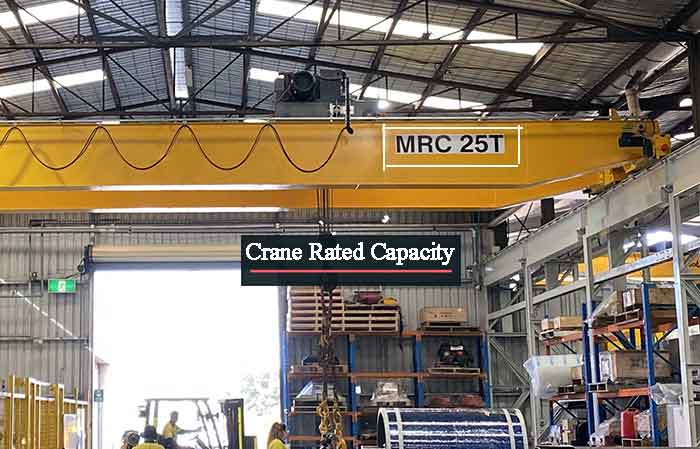
The lifting capacity or rated lifting capacity of a crane is commonly referred to as the lifting weight G. It refers to the maximum weight that a crane can lift safely and stably under normal working conditions. The lifting capacity of a crane is determined by its structural design, such as the length of its boom, the strength of its wire ropes, and the capacity of its hoisting mechanism. The lifting capacity is usually expressed in metric tons (t) or kilonewtons (kN).
- Rated lifting capacity Gn refers to the total weight of the material that the crane can lift along with any detachable lifting equipment or attachments such as grab buckets, electromagnetic suction cups, balance beams, etc.
- Total lifting capacity Gz refers to the total weight of the material that the crane can lift along with any detachable lifting equipment and fixed lifting equipment and devices that are permanently attached to the crane (including hooks, pulley blocks, lifting steel wire ropes, and other lifting devices below the crane trolley).
- Effective lifting capacity Gp refers to the net weight of the material that the crane can lift.
Note:The parameters need to be explained as follows:
- First, the lifting capacity marked on the crane nameplate usually refers to the rated lifting capacity of the crane, which should be prominently displayed on an obvious position of the crane structure.
- Second, for jib type cranes, the rated lifting capacity varies with the amplitude, and its lifting characteristic index is characterized by the lifting moment. The value marked on the label is the maximum lifting capacity.
- Third, for cranes with detachable spreaders (such as grab buckets, electromagnetic suckers, balance beams, etc.), the total rated lifting capacity of the spreader and the mass of the material, the mass of the material allowed to be lifted is the effective lifting capacity.
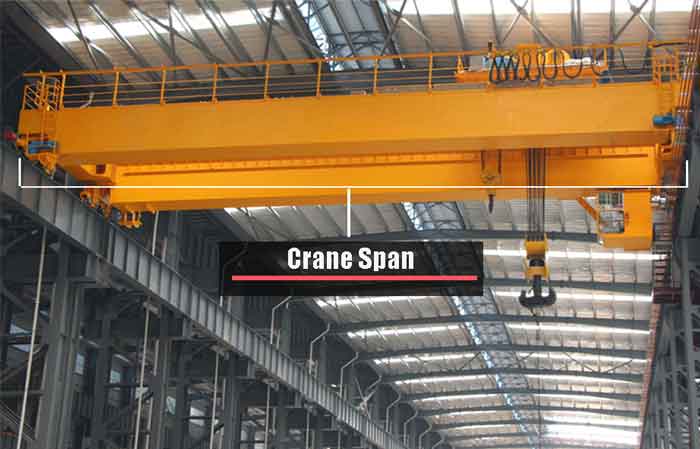
Crane span
- Crane span - Span S refers to the horizontal distance between the centerlines of the running tracks of a bridge-type crane, measured in meters. The span of a bridge crane is usually 1.5-2.0 meters smaller than the span of the building (1.5 meters for cranes under 50 tons).
- Bridge crane gauge - The distance between the centerlines of the running tracks of a bridge crane's trolley is called the gauge of the trolley.
- Gantry crane gauge The distance between the centerlines of the running tracks of a gantry crane that runs on tracks on the ground is called the gauge of the crane.
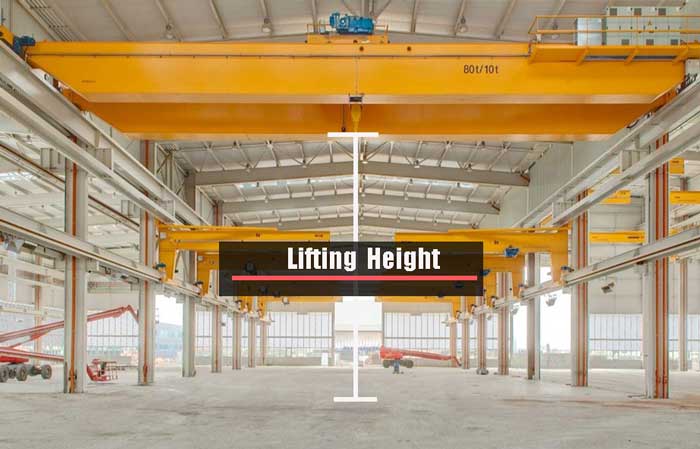
Lifting height
The lifting height H is the vertical distance from the top surface (or ground) of the crane running track to the uppermost position of the lifted load. The unit of measurement is meters. When using a hook, the measurement is taken to the center of the hook ring, while when using a grab bucket or other containers, the measurement is taken to the bottom of the container. More about crane crane span, lifting height and types of lifting crane working coverage for your reference.
- The vertical distance from the ground to the highest allowable position of the lifting device, marked as H.
- If the hook can be lowered below ground level, then the height below ground level is called the lowering depth (h).
- Long travel refers to the direction of the bridge's movement along the rails.
- Cross travel refers to the movement of the 'crab' from one side of the bridge to the other.
- Hook Height is the distance from the datum to the highest position of the hook, which determines the height of the runway from the floor and is dependent on the clear inside height of the building. Effective lift is the distance between the beam and the floor, minus the height of the hoist.
- Runway Height is the distance between the grade level and the top of the rail.
- Side Clearances are measured from the center of the supporting rail to the face of the supporting column, required for operation, safety, and wheel maintenance.
- Vertical Clearances refer to the space required for the crane to travel within a building while avoiding obstructions such as lights, equipment, and structural framing. The lower the crane headroom, the higher will be the vertical clearance and lower could be the building height.
- Clear Span is the horizontal center distance between the rails of the runway on which the crane travels, typically 500 mm less than the width of the building. The span required depends on the crane coverage width dictated by the application.
- Runway Length is the longitudinal run of the runway rail parallel to the length of the building.
- Hook Approaches refer to the distance from the wall to the nearest possible position of the hook, which affects floor area utilization.
- End Approach refers to the minimum horizontal distance parallel to the runway between the outermost extremities of the crane and the centerline of the hook.
- Bridge, Trolley, and Lift Speeds are specified in feet per minute or FPM and selected to allow safe operation while using a pendant. Dual operating speeds are commonly used, but a variable speed control system is preferred for optimum control.
- Electrical Requirements ideally include 480 volt, 3 phase, 60 hertz for US requirements. The runway power is usually by a conductor bar, and a hoisting trolley by festoon cable. The control circuit voltage at pendant pushbuttons shall not exceed 150 volts for AC and 300 volts for DC.
Radius R:
- For a jib crane in a horizontal position, the distance between the centerline of rotation and the vertical line passing through the center of the load.
- For a non-rotating jib crane, it refers to the distance between the pivot point under the jib and the vertical line passing through the center of the load.
- The maximum radius is achieved when the jib is at its minimum inclination or when the distance between the trolley position and the center of rotation of the crane is at its maximum.
Amplitude L
The amplitude of the rotating jib crane refers to the horizontal distance between the center line of rotation and the plumb line of the pick-up device, and the unit is m. The amplitude of a jib crane of the non-rotating type refers to the horizontal, horizontal distance between the centerline of the spreader and the rear axle of the jib or other typical axis.
When the inclination angle of the jib is the smallest or the distance between the position of the trolley and the center of rotation of the crane is the largest, the amplitude is the maximum amplitude; otherwise, it is the minimum amplitude.
Operating speed:
- Hoisting speed Vq refers to the vertical displacement speed of the rated load when the crane is in a stable operating state, measured in meters per minute.
- Trolley running speed Vk refers to the running speed of the crane with the rated load on a horizontal surface or track, measured in meters per minute.
- Crane running speed Vt refers to the running speed of the trolley with the rated load on a horizontal track in a stable motion state, measured in meters per minute.
- Slewing speed V1 refers to the average linear speed of the horizontal displacement from maximum radius to minimum radius in the slewing plane with the minimum rated load when the crane is in a stable motion state, measured in meters per minute.
- Traveling speed V refers to the smooth running speed of a mobile crane with a rated load while driving on a road, measured in kilometers per hour.
- Rotation speed ω refers to the rotation speed of the crane around its center of rotation when it is in a stable motion state, measured in revolutions per minute.
Working class or working duty of cranes
The working class of a crane is determined by considering the utilization of its lifting capacity and time, as well as the working characteristics of the operating cycles. According to GB/T 3811-2008 "Design rules for cranes," the working class of a crane is divided into the working class of the entire machine, the working class of the mechanism, and the working class of the structural or mechanical components.
The usage level of a crane (i.e., the degree of busyness over time) is classified into different levels based on the number of load cycles and the duration of the operation.
The crane use level indicates how frequently the crane was used over the design life. The general work cycle number N is divided into 10 levels based on the design life period (see table 1).
Crane use level | general work cycle number N | annotation |
U0 | 1.6*10 4 | Not often use |
U1 | 2.2*104 | |
U2 | 3.3*104 | |
U3 | 1.25*105 | |
U4 | 2.5*105 | Free to use |
U5 | 5*105 | Often secondary to use |
U6 | 1*106 | Don't always busy to use |
U7 | 2*106 | Busy use |

Crane load condition
The degree of the crane load is determined by two factors: the ratio of hoisting the load to the rated load Pi/Pmax, and the ratio of the role of various hoisting load numbers to the general work cycles ni/N. The following are the two load spectrum factor and Kp computed by type relationships:
In the formula:
Kp—load spectrum factorand; ni—the effect number of load Pi; N—general work cycles, N= ; Pi—the I hoisting load, i=1,2….n; Pmax—max lifting load; m—index, in here m=3.
The nominal load spectrum coefficient divides the crane load condition into four categories (see table 2)
Table 2:
Crane load condition | nominal load spectrum coefficient (Kp) | Explain |
Q1-light | 0.125 | Rarely lifting load rating |
The load state level is classified into four levels: Q1, Q2, Q3, and Q4, with Q1 being the most frequently used and Q4 being the least frequently used. The load state level is determined based on the ratio of the actual weight of the lifted object to the rated lifting capacity of the crane.
One working cycle: hoisting goods/ loads→lifting→running→lowering→unloading→the empty hook returns to its original position.
The idle time between work cycles of a crane refers to the time required for the crane to complete one work cycle and return to its original position before starting the next work cycle. The idle time depends on the type and configuration of the crane, as well as the specific work environment.
Calculation formula for total working cycles: N=3600YDH/tc
Y: The service life of the crane (generally 20-30 years) .D: The number of working days in a year (265 days) H: The number of working hours in a day. tc: The time of a working cycle (s), which is related to the degree of work busyness
Main specifications of types of cranes
Cranes have different main specifications depending on their type. For bridge cranes, the main specifications include lifting capacity, lifting height, span, lifting speed, trolley traveling speed, bridge traveling speed, working class, and load state level. Gantry cranes have similar specifications, but with crane traveling speed instead of bridge traveling speed. Jib cranes are characterized by lifting capacity, lifting height, arm length, lifting speed, slewing speed, working class, and load state level. It's important to note that these specifications can vary depending on the specific model and manufacturer of the crane.
Main specifications of bridge cranes
Crane Type | Usage Scenarios | Lifting Capacity Range | Span Range | Lift Height Range | Duty Cycle | Control Type | Environmental Factors |
Single Girder Overhead Travelling Crane | Manufacturing, Assembly, Maintenance | 1-20 tons | Up to 60 feet | Up to 30 feet | Light to Medium | Pendant, Radio Remote, or Cab | Indoor, Dry, and Non-corrosive |
Double Girder Overhead Crane | Steel Mills, Power Plants, Heavy Manufacturing | 5-100+ tons | Up to 150 feet | Up to 100 feet | Medium to Heavy | Pendant, Radio Remote, or Cab | Indoor or Outdoor, Dry, and Non-corrosive |
Jib Crane | Machining, Assembly Workstations | 0.5-5 tons | Up to 20 feet | Up to 20 feet | Light to Medium | Pendant or Cantilevered | Indoor, Dry, and Non-corrosive |
Underhung Crane | Low Headroom Applications | 1-10 tons | Up to 60 feet | Up to 30 feet | Light to Medium | Pendant or Radio Remote | Indoor, Dry, and Non-corrosive |
Grab Overhead Crane | Handling Loose Bulk Materials | 5-100+ tons | Up to 150 feet | Up to 100 feet | Medium to Heavy | Pendant, Radio Remote, or Cab | Indoor or Outdoor, Dry, and Non-corrosive |
Electromagnet Overhead Crane | Handling Ferrous Materials | 5-100+ tons | Up to 150 feet | Up to 100 feet | Medium to Heavy | Pendant, Radio Remote, or Cab | Indoor or Outdoor, Dry, and Non-corrosive |
Ladle Overhead Crane | Handling Molten Metal | 5-100+ tons | Up to 150 feet | Up to 100 feet | Medium to Heavy | Pendant, Radio Remote, or Cab | Indoor, High Temperature |
Explosion-proof Overhead Crane | Hazardous Environments | 1-100+ tons | Up to 150 feet | Up to 100 feet | Light to Heavy | Pendant, Radio Remote, or Cab | Indoor, Hazardous |
Clean Room Overhead Crane | Clean Room Environments | 1-20+ tons | Up to 60 feet | Up to 30 feet | Light to Medium | Pendant or Radio Remote | Indoor, Clean |
Automated Overhead Crane | Fully or Partially Automated Material Handling | 1-100+ tons | Up to 150 feet | Up to 100 feet | Light to Heavy | Automated Controls | Varies by Application |
Main specifications of types of gantry cranes
Type | Load Capacity | Span Width | Height Under | Usage Scenarios: |
Portable Gantry Crane | Up to 5 tons | Up to 30 feet | Up to 20 feet | Lifting small loads in warehousesMaintenance work in factories |
Adjustable Gantry Crane | Up to 15 tons | Up to 40 feet | Up to 35 feet | Heavy lifting in workshops Construction projects |
Fixed Gantry Crane | Up to 100 tons | Up to 150 feet | Up to 100 feet | Heavy-duty lifting operations in shipyardsLarge-scale construction projects |
Container Gantry Crane | Up to 100 tons | Up to 200 feet | Up to 100 feet | Loading and unloading of containers in ports and terminals |
Rail Mounted Gantry Crane (RMG) | Up to 120 tons | Up to 100 feet | Up to 80 feet | Container handling in intermodal rail yards and container terminals |
Small Lightweight Gantry Crane | Up to 2 tons | Up to 15 feet | Up to 10 feet | Lifting small loads in workshops and garages |
Mobile Gantry Crane | Up to 20 tons | Up to 40 feet | Up to 20 feet | Lifting and moving heavy loads in outdoor settings or large warehouses |
Main specifictions of types of jib cranes
Crane Type | Usage Scenarios | Lifting Capacity Range | Span Range | Lift Height Range | Duty Cycle | Control Type | Environmental Factors |
Jib Crane | Machining, Assembly Workstations | 0.5-5 tons | Up to 20 feet | Up to 20 feet | Light to Medium | Pendant or remote control | Indoor, Dry, and Non-corrosive |
Pillar jib crane | Indoor and outdoor use | 1-20 ton | 3~12m | 3~8 | Light to Medium | Pendant or remote control | Floor mounted with foundation or foudationless design |
Wall mounted jib crane | Workshop or workstation | 1-5 ton | 2-8m | 3-10m | light | Pendant or remote control | H steel column or concrete column of walls |
Wall travelling jib crane | Workshop or workstation | 1-3 ton | 5~12.5m | 6~30 | light | Pendant or remote control | Linked workshops |
Portable jib cranes | Workshop or workstation and outdoor use | 0.25t -2 ton | 2-6 m | 2-5m | Light | Pendant or remote control | General material handling conditions |
Hoisting and crane machinery terminology
1.1 Light lifting equipments
1.1.2 Rack-pinion jack - A jack that uses a rack as a rigid lifting device. 1.1.3 Hydraulic jack - A jack that uses a plunger or hydraulic cylinder as a rigid lifting device.
1.2 Pulley block - A small and light lifting device consisting of a fixed pulley group, a moving pulley group, and a lifting rope that passes successively over the fixed and moving pulleys.
1.3 Hoist - A small and light lifting device that is mounted on a common hanger and consists of a driving device, a transmission device, a braking device, and a flexible member for winding or clamping, or for lifting and lowering the lifting device.
1.3.1 Chain block - A hoist that is manually operated by pulling a chain and chain wheel to finally lift the lifting chain through a star wheel or nest chain wheel, thereby driving the lifting device to move up and down.
1.3.2 Lever block - A hoist that is manually operated by driving a wire rope or chain with a lever to move the lifting device.
1.3.2.1 Rope lever block - A hoist that is manually operated by driving a wire rope clip with a lever, alternately pulling the wire rope to drive the lifting device to move.
1.3.2.2 Chain lever block - A hoist that is manually operated by driving a nest chain wheel with a lever to wind and unwind the lifting chain, thereby driving the lifting device to move.
1.3.3 Electric hoist - A hoist that is driven by an electric motor and finally lifts the lifting rope or lifting chain through a drum, a star wheel, or a nest chain wheel, thereby driving the lifting device to move.
1.3.4 Pneumatic hoist - A hoist that is powered by compressed air.
1.4 Winch - A hoist that is driven by power through a flexible member to move the lifting device.
1.4.1 Drum hoist - A winch with the end of the lifting flexible member directly fixed on the drum, which has a dual function of winding and storing the lifting flexible member.
1.4.2 Friction hoist - A winch where the lifting flexible member only wraps around the drum for several turns, and when one end is wound up, the other end is released at the same time. The drum relies on the frictional force between the flexible member and the drum wall to create a tension difference between the entrance and exit ends of the flexible member, thereby providing traction force for the flexible member.
1.4.3 Capstan - A single drum frictional winch where the outer periphery of the drum is concave so that the lifted flexible member can slide automatically along the axis of the drum (capstan head) towards the bottom of the arc, without producing axial displacement.
1.5 Underslung monorail system - A light and small lifting device that consists of several simple lifting trolleys traveling along an overhead rail for transporting goods.
2.1 Classification of cranes according to their structure
2.1.1 Overhead type crane - A crane with a lifting device suspended from a hoist or a running trolley that runs along the overhead bridge.
2.1.1.1 Overhead travelling crane - A bridge-type crane supported directly on elevated tracks by running devices at both ends of the bridge.
2.1.1.2 Portal bridge crane (gantry crane) - A bridge-type crane with the bridge supported on the ground track or foundation by two side legs.
2.1.1.3 Semi-portal bridge crane - A bridge-type crane with one side of the bridge directly supported on elevated or high-rise building tracks and the other side supported on the ground track or foundation by legs.
2.1.2 Cable type crane - A crane with a lifting device suspended from a hoist that runs along a cable.
2.1.2.1 Cable crane - A cable-type crane with both ends of the supporting cable fixed to the top of two supports.
2.1.2.2 Portal cable crane - A cable-type crane with the end of the supporting cable fixed to both ends of the bridge, and the bridge supported on the ground track by two side legs.
2.1.3 Jib type crane - A crane with a lifting device suspended from the top of a jib or from a hoist that runs along the jib.
2.1.3.1 Portal slewing crane - A slewing jib-type crane with a portal frame that runs along the ground track and can be passed under by railway or other ground vehicles.
2.1.3.2 Semi-portal slewing crane - A slewing jib-type crane with one side of the semi-portal frame supported on elevated tracks by a running truck and the other side supported on the ground track or foundation by legs and a running truck.
2.1.3.3 Tower crane - A slewing jib-type crane with the jib mounted on the top of a vertical tower.
2.1.3.4 Railway crane - A jib-type crane that operates on railway lines and is used for loading and unloading and for rescuing railway locomotives, vehicles, and overturned trains.
2.1.3.5 Mobile crane - A jib-type crane that can be equipped with columns or towers and can run on an untracked surface with or without a load, relying on its own weight to maintain stability.
2.1.3.6 Floating crane - A jib-type crane supported and operated by a special floating ship, which floats on the waterway and can sail or be towed along the waterway.
2.1.3.7 Deck crane - A slewing jib-type crane mounted on a ship's deck for loading and unloading cargo.
2.1.3.8 Derrick crane - A slewing jib-type crane with its lower end hinged to the lower part of a mast, its upper end connected to the masthead by a wire rope, and the mast itself kept upright by top and bottom supports.
2.1.3.9 Cantilever crane - A jib-type crane with a lifting device suspended from the end of a cantilever or from a hoist that runs along the cantilever.
2.1.3.9.1 Pillar jib crane - A cantilever crane with a cantilever that rotates around a fixed pillar on a base, or where the cantilever is rigidly connected to the turning pillar, rotating together relative to the vertical centerline in the support base composed of pillars and cantilevers.
2.1.3.9.2 Wall crane - A cantilever crane mounted on a wall or column that cannot be inclined.
2.2 Cranes are classified by pick-up device and use
2.2.1 Hook crane / Hook crane - a crane that uses a hook as a retrieval device
2.2.2 Grabbing crane / Grabbing crane - a crane with a grab bucket as a pick-up device
2.2.3 Electromagnetic Crane / Magnet crane - a crane with an electromagnetic suction cup as a pick-up device
2.2.4 Metallurgy crane/ (see GB6974.16) Metallurgy crane - a special crane that adapts to the special requirements of metal smelting, rolling and other thermal processing, and is directly used in the production process
2.2.5 Stacking crane/ (see GB6974.17) Stacking crane - a crane that usually uses a fork as a pick-up device to stack items in a warehouse or workshop
2.2.6 Container cranes/ (see GB6974.19) Container cranes - cranes for loading and unloading container ships and vehicles, stacking and destacking or transshipment of containers at port terminals and station freight yards
2.2.7 Erection crane / Erection crane - a crane for placing prefabricated parts, lifting machinery and equipment, etc.
2.2.8 Rescue crane / Salvage crane - a crane used for emergency rescue and cleaning up the accident scene
2.3 Cranes are classified according to their transportation methods
2.3.1 Fixed base crane - a crane that is fixed to a foundation or support base and can only work in situ
2.3.2 Traveling crane - a rail or trackless crane that can be moved as a whole
2.3.2.1 Self-propelled crane / Self-propelled crane - during operation or transportation, the whole machine can run along the track or trackless by relying on its own operating mechanism
2.3.2.2 Trailer crane / Trailer crane - a running crane that does not have running power itself and is towed by a tractor (tractor, etc.)
2.3.3 Climbing crane / Climbing crane - a crane that is installed on the building components under construction and can continue to climb upwards by its own mechanism as a whole as the building increases
2.3.4 Portable crane / Portable crane - a crane mounted on a base that can be moved from one site to another by manpower or with the aid of auxiliary equipment
2.3.5 Lorry crane / Lorry crane - a crane that is fixed to a truck and is usually used for loading and unloading goods on the truck
2.3.6 Radial crane / Radial crane - a crane that can move along an arc track around a fixed vertical center line
2.4 Cranes are classified according to the driving mode of the working mechanism
2.4.1 Manual crane / Manual crane - a crane driven by human power
2.4.2 Electric crane / Electric crane - a crane driven by electricity
2.4.3 Hydraulic crane / Hydraulic crane - a crane driven by hydraulic or hydraulic power
2.4.4 Internal combustion crane / Diesel crane - a crane driven by an internal combustion engine (diesel engine, gasoline engine)
2.4.5 Steam crane / Steam crane - a crane driven by a steam engine
2.5 Cranes are classified by slewing capacity
2.5.1 Slewing Crane / Slewing Crane - A crane in which the superstructure (on board), or slewing platform, can carry a hoisted load around an axis of rotation, relative to the substructure (on board), or base
2.5.1.1 Full-circle slewing crane / Full-circle slewing crane - a slewing crane in which the upper structure (on the vehicle) or the slewing platform can rotate relative to the lower structure (off the vehicle) or the base within a range of more than 360°
2.5.1.2 Non-full slewing crane / Limited slewing crane - a slewing crane in which the upper structure (on the vehicle) or the slewing platform can rotate relative to the lower structure (on the vehicle) or the base within an included angle of less than 360°
2.5.2 Non-slewing crane / Non-slewing crane - a crane that cannot rotate a lifted load relative to its base or trolley
2.6 Cranes are classified according to their supporting methods
2.6.1 Supported crane / Supported crane - an overhead crane supported on an elevated track and running above the track
2.6.2 Suspension Crane / Underslung crane - An overhead crane that is suspended from the lower flange of an elevated track and operates below it
2.7 Cranes Classified by Application
2.7.1 Workshop crane / Workshop crane - used in processing workshops, repair workshops, assembly workshops, cranes for lifting workpieces and machines
2.7.2 Machine house cranes/ Machine house cranes - cranes used for hoisting and repairing generators, water turbines and other equipment in the machine room
2.7.3 Warehouse crane / Warehouse crane - a crane used for lifting and stacking items in the warehouse and on the yard
2.7.4 Storage yard cranes/ Storage yard cranes - cranes used for stacking and reloading bulk materials on open-air yards
2.7.5 Construction cranes/ Building cranes - cranes used to lift building materials, place prefabricated parts, and hoist machinery and equipment at the construction site
2.7.6 Construction cranes/ Construction cranes - cranes used on earthwork construction sites
2.7.7 Port crane / (see GB6974.18) Port crane - a crane specially designed and manufactured according to the requirements of port loading and unloading operations
2.7.8 Shipyard crane / Shipyard crane - a crane used to build ships in a shipyard
2.7.8.1 Shipway crane / Shipway crane - a crane used to lift the hull and ship's equipment on the shipyard
2.7.8.2 Dock crane - a shipbuilding crane used on a dock (floating dock)
2.7.8.3 Outfitting crane / Crane for finishing shipguilding - After the ship is launched, the shipbuilding crane used to install the ship's auxiliary equipment and supporting components
2.7.9 Dam crane / Dam crane - the crane used for opening and closing gates, lifting equipment, etc. on the hydropower dam
2.7.10 Shipboard crane / Shipboard crane - a crane installed on the deck of a ship for loading and unloading cargo
Crane Basic - Main Structures, Parts and Components & Crane Kits
Your Trusted Overhead Crane Manufacturer & Supplier
Main Parts and Components of Overhead Cranes
Basic Bridge Crane Structures and Components
Basics of overhead crane specifications, definitions & terms for reference to get custom overhead crane, gantry crane, jib crane & other hoists and cranes.
A crane's function is to move the lifted weight horizontally and longitudinally across the building. Typically, the hoisted load is supported by a hook that is cabled to a hoist. A trolley that swings horizontally along the crane bridge supports the hoist. Depending on the capacity and span, the crane bridge is connected to a number of crane trucks at each end. Crane trucks might have two, four, or eight wheels depending on the crane's capability. The wheels are supported by runway beams and go along a crane rail. The diagram below depicts the fundamental crane components.

- Bridge - An overhead crane's main structural component is the bridge. It spans the width of the structure and is made up of one or more load-bearing beams or girders. These could be steel box girders or rolled steel joists. During operation, the hoist trolley runs along the length of the girders on the bridge.
- Runway - The track and support system used by the crane. The runway girders are typically designed as an integral element of the building construction.
- Runway Rail - The rail that the crane runs on and is supported by the runway beams.
- End trucks - The end trucks, which are located on either side of the bridge, house the wheels on which the entire crane travels. It is a structure made up of structural parts, wheels, bearings, axles, and other components that supports the bridge girder(s) or trolley cross member(s). Electric drive motors, which are normally two-speed or variable-speed units, power the wheels and bring the crane into place. Brakes, which are generally electrically actuated, are positioned on the drive motors and are crucial for preventing uncontrolled loads from becoming unsafe. At the end of the travel range, electrical limit switches stop power to the drive motors, preventing the crane from colliding with the building structure.
- Hoist - A hoist mechanism is a unit that includes a motor drive, connection, brakes, gearing, drum, ropes, and a load block that is designed to raise, hold, and lower the maximum rated load. The trolley is equipped with a hoist mechanism.
- Trolley or Crab - The 'crab' is the 'cross travel unit' that lowers and raises the hook. A top-running trolley on a double-girder crane runs on rails attached to the crane bridge's top. A single-girder crane's underhung trolley runs on the bottom flange of the crane beam, with drive units directly linked to the trolley. The trolley transports the electric wire rope hoist, which supports the load block and hook via a pulley system. The load is moved up and down by a variable-speed AC motor on the hoist. Limit switches keep the load block and trolley from colliding.
- Bumper (Buffer) - An energy-absorbing device designed to reduce impact when a moving crane or trolley reaches the limit of its allowed travel or when two moving cranes or trolleys collide. This device can be mounted on a bridge, trolley, or runway stop.
- Controls - EOT crane controls are often housed in an operator pendant or remote console and consist of numerous push buttons and switches that operate relays and contactors located on the crane. Drive motors and hoist motors draw significant currents when in operation and require adequately rated contactors to turn them on and off. Variable frequency inverters manage the speed of motors that require precise placement. If a dangerous scenario occurs, a master contactor is triggered by a main switch and cuts off all power to the crane.
Other features of specialty cranes may include: end stops, a full length platform on both girders, under bridge illumination, a closed, glazed, or air conditioned cabin, specialist controls, and so on.
Crane bridge / Main girder
The bridge frame includes main girders, end girders, trolley running tracks, railings, walking platforms, driver's cabs, etc.
The bridge frame is the basic component of the whole crane, which bears various loads and should have sufficient rigidity and strength. Strength is the ability to resist fracture, and stiffness is the ability to resist deformation.

Main parts and component of main girder of top running double girder overhead crane

End carriages of double girder overhead bridge cranes
Main beam structure:
- Material: Q235B or Q345B , Structural form: box type
- Because the main girder of the box structure has many advantages such as high overall rigidity, good manufacturing, assembly, transportation and maintenance conditions, it is widely used at home and abroad.
- The upper camber of the main beam - the main beam is generally made into a uniform upward arched shape.
Arching of main girder
- The purpose of arching: to reduce the climbing and sliding of the trolley, and to enhance the bearing capacity of the main beam;
- Arching standard: According to the provisions of JB1036-82 "Technical Conditions for General Bridge Cranes", the upper arching degree of the main beam span is:
- F=(0.9‰~1.4‰)L
- In the formula: F──camber of main beam; L──span of main beam.
Downward deflection of main beam
- The downward deflection of the main beam - after the crane has been used for a certain period of time, the camber of the main beam will gradually decrease until it disappears, and the downward deflection will appear.
- Reasons: ① Improper manufacture of the main beam; ② Unreasonable use; ③ Influence of high temperature; ④ Unreasonable repair.
Overhead crane travelling system
The overhead crane traveling system consists of wheels, motors, reducers, brakes, etc.
It is to provide driving force to the driving wheels so that the whole crane can run horizontally along the fixed track.

Drive mode: separate drive and centralized drive
- Separate drive: Two sets of separate drive devices respectively drive the driving wheels under the beams at both ends.Rely on the rigidity of the bridge itself and the control system to keep the wheels on both sides synchronous
- Concentrated drive: one set of drive device drives the wheels at both ends at the same time. It is easy to keep in sync, but the drive shaft is long and the installation is complicated.The centralized drive mode is mainly used on cranes with small lifting capacity
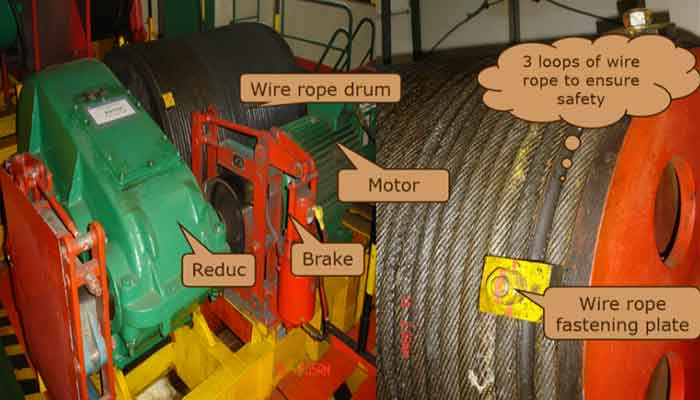
Crane trolley
The lifting mechanism diagram of crane trolley is shown above.:
- Installed on the bridge frame, it is composed of a lifting mechanism, a trolley running mechanism and a lifting trolley frame.
- Lifting mechanism: realize the lifting of goods;
- Trolley running mechanism: drive the lifting trolley to run horizontally and horizontally along the track on the bridge frame;
- Trolley frame: supports the entire trolley and bears the load.
The settings of the main and auxiliary hooks of the lifting trolley:
- When the lifting capacity is less than 10t, only one set of lifting mechanism and one hook are provided;
- When the lifting capacity is >10t, two sets of lifting mechanisms are provided:
- The main lifting mechanism with large lifting capacity is the main hook
- The one with the smaller lifting capacity is the auxiliary lifting mechanism—the auxiliary hook
Generally, the lifting weight of the auxiliary hook is 15% to 20% of the lifting weight of the main hook.
Motors
Motors are divided into: AC motors and DC motors. AC motors are divided into synchronous motors and asynchronous motors. Asynchronous motors are divided into three-phase motors and single-phase motors.
The difference between synchronous motor and asynchronous motor
- 1. The difference between motor synchronization: the speed of synchronous motor is synchronous with the electromagnetic speed, while the speed of asynchronous motor is lower than the electromagnetic speed. No matter the load size of synchronous motor, as long as it does not lose the step, the speed will not change. The speed of asynchronous motor always follows the load size changes with changes.
- 2. Structural differences: Synchronous motors have high precision, but are complex in manufacture, high in cost, and relatively difficult to maintain, while asynchronous motors are slow in response, but easy to install and use, and cheap in price. Therefore, synchronous motors are not as widely used as asynchronous motors.
- 3. Differences in use occasions: Synchronous motors are mostly used in large generators, while asynchronous motors are almost used in motor occasions.
- 4. The main difference The difference between synchronous motors and asynchronous motors lies in whether there is slip (the difference between the magnetic field speed and the rotor speed).
The difference between DC motor and AC motor
- 1. Different types of input power sources: AC motors use AC power (single-phase and three-phase), while DC motors use DC power (constant DC and pulsating DC).
- 2. The structure of the motor is different: DC motors generally have brushes and commutators, while AC motors generally do not. AC motors are more versatile than DC motors! Sparks often appear between the brushes of the DC motor and the commutator, causing the surface of the commutator to oxidize or even insulate.
- 3. Different uses: DC motors are mainly used for power machinery or other equipment with a wide range of speed regulation (requiring smooth speed regulation), such as gantry planers, rolling mills, electric track traction (such as electric locomotives, subways), and AC motors are mainly used It is suitable for power machinery or other equipment with a small speed regulation range, such as general fans, water pumps, machine tools, cranes on construction sites, etc.
Basic structure of crane motors

Asynchronous motors are mainly composed of two parts. The fixed part is called the stator and the rotating part is called the rotor.
Rotor - The rotor consists of the rotor core, rotor windings and shaft. The role of the rotor winding is to induce electromotive force, flow current and generate electromagnetic torque.
The structure type of rotor winding: squirrel cage type and winding type.
According to the structure of the rotor, asynchronous motors are divided into:
- Squirrel-cage asynchronous motor: drives various machinery, such as ventilators, machine tools and transportation machinery, etc.
- Wound rotor asynchronous motor: large starting torque, hoist, water pump and driving.

Squirrel cage rotor
The shape of the rotor winding is like a "squirrel cage". Since the rotor winding of the asynchronous motor does not need to be powered by an external power supply, it can close itself to form a short-circuit winding.

Wound rotor
The wound rotor winding is similar to the stator winding. It is also a three-phase symmetrical winding with insulated wires embedded in the rotor core slot and connected in a star connection.

Conical rotor motor ZD series
Braking features:
- The braking device of the conical rotor motor is composed of a sleeve
- Brake spring on motor rotor, fan brake wheel and end
- Composed of brake rings on the cover.
- Application range: dedicated to hoist lifting
- Manufacturer: Nanjing Special
- Protection level: IP44, IP54
- Insulation class: B class, F class
Motor duty
Indicates the allowable cycle time of the motor under different loads. The working system of the motor is: S1~S10;
The common ones are as follows:
- S3: Intermittent periodic work system
- S4: Intermittent periodic duty with start
- S5: Intermittent periodic duty system with electric braking
- S6: continuous cycle duty system
Duty cycle
Also known as the duty cycle, it refers to the ratio of the equipment to be able to work at full load.
Common are: 25%, 40%, 60% . ( 25%: It means that under full load, it can only work for 25% of the time, that is, it can only work for 25 minutes within 100 minutes, otherwise it will overheat and burn out. )
Insulation class
Cranes are generally Class B or Class F
In electrical equipment such as generators, insulating materials are the weakest link. Insulating materials are particularly susceptible to accelerated aging and damage due to high temperatures. Different insulating materials have different heat resistance properties, and electrical equipment using different insulating materials have different ability to withstand high temperatures. Therefore, general electrical equipment stipulates the maximum working temperature.
Insulation temperature class A class E class B class F class H class C class
Maximum allowable temperature (℃) 105 120 130 155 180 180 or more
Factors affecting the price of the reducer:
- Configuration: the difference between imported and domestic
- Type: helical gear reducer, cycloid reducer, planetary reducer stepless variable speed reducer, worm gear reducer
- Frame size: The larger the frame size, the bigger the reducer
- Motor size and motor type: The reducer must be equipped with a motor. If a special motor is required, the price will be affected, and the price of the reducer with a large motor power will increase accordingly.
- Voltage: 220-480/50, the motor will increase by 10%, 220-480/60 motor will increase by 20%, and the delivery time of voltage 220/60 and 460-480/50 is relatively long
- Protection grade: IP44, IP54, IP55
- Insulation class: B, F, H
- Ambient temperature: -20°C— 40°C
- Special use environment: metallurgy, dust
- Altitude: below 1000 meters
- Special requirements
Reducer
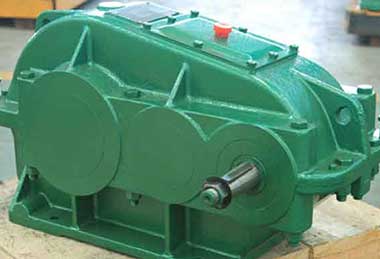
ZQ series cylindrical gear reducer
- Scope of application: used for lifting bridge cranes and running carts
- Classification: Models are divided into: 250, 350, 400,
- There are 8 types of 500, 650, 750, 850, and 1000.
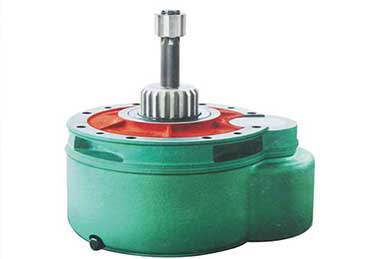
- The reducer is a self-contained part, easy to assemble and disassemble
- Adopt standard modulus cylindrical gear
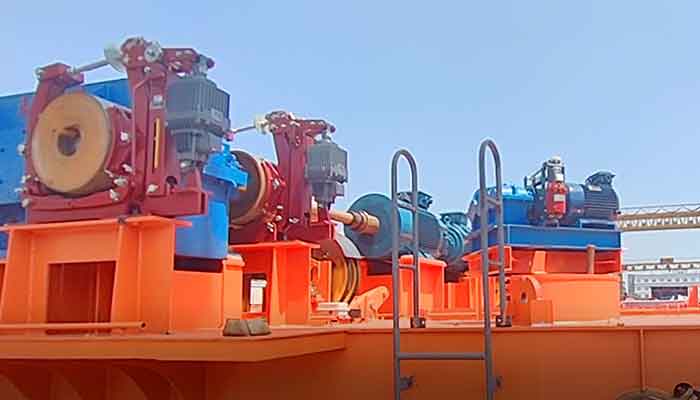
YWZ series electric hydraulic block brake
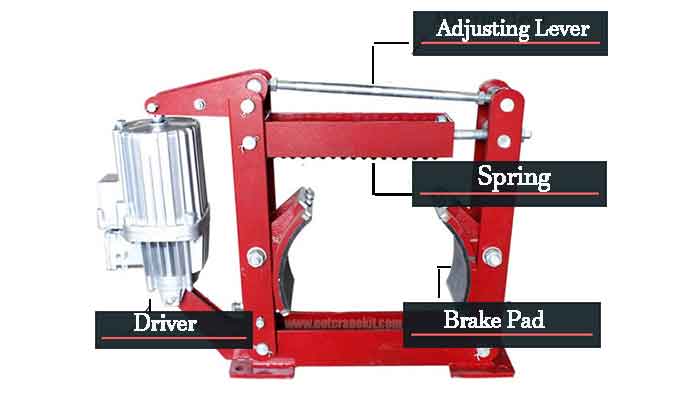
Block brake - Seabury (Germany, specializing in the production of brakes and couplings)
Overload limiter

BCQ series electric hoist weight limiter

BQX series explosion-proof electric hoist load limiter

QCX series lifting weight limiter
Busbar

Seamless busbar(6 square -35 square) - copper conductor
Safe, stable, no interface (except power supply point), small size, convenient installation and economical;
It is suitable for single-girder bridge cranes and cranes with low power consumption. It is recommended that the current intensity is lower than 120A and the running length is within 100 meters;
1. It adopts non-joint installation, which is convenient for transportation and takes up little space for installation.
2. The installation bending radius is small, and the minimum bending radius is 750mm.

Multi pole busbar line (within 200A) - copper conductor
It is suitable for logistics automation production lines and inspection lines with low current and high frequency of use.
1. The casing of the multi-pole trolley type trolley line is made of engineering plastics with high insulation performance. The insulation performance is good, and there is no harm to the maintenance personnel touching the outside of the power transmission conduit.
2. The multi-electrode sliding contact line transmission guide rail has good electrical conductivity, fast heat dissipation, high current density, low impedance value, and small line loss. The brushes are made of metal graphite materials with high electrical conductivity and high wear resistance.

Single pole busbar (200A-2000A)-aluminum alloy conductor
Suitable for most occasions, the first choice for large current and long distance power supply;
Indoor and outdoor use;
- Easy maintenance and low maintenance cost;
- Heat-resistant sheath can be used in high temperature environment;
- Power input point can be provided at any position;

For steel mills - rigid sliding wire
A moving trolley line composed of trapezoidal copper rods and channel steel or a combination of "T" copper bars and channel aluminum
- Rigid body trolley line is composed of trapezoidal copper rod and channel steel or the combination of "T" copper bar and channel aluminum. It is supported by high-strength special insulators to form a moving trolley line that feeds power to various lifting machinery and equipment.
- Product Features - Reliable operation, never power failure
- Structure - Composed of trapezoidal copper bars and channel steel or a combination of "T" copper bars and channel aluminum.

Angle steel sliding wire has the advantages of good wear resistance, high temperature resistance and little wear of carbon brushes, but as a technology more than ten years ago, it also has many shortcomings, such as heavy lifting power consumption, troublesome installation, and difficult operation. Complicated, etc.

C-shaped steel and supporting power supply system
- C-shaped steel supply range: C32, C30, C40, C63
- Cable supply range: 6 square -75 square
- Cooperate with the mobile power supply of bridge gate machine and electric hoist trolley;
- It can work normally in indoor, dusty, dusty, and large temperature difference environments, with low environmental requirements and stable high-speed operation;
- It can be installed with flat cable or round cable;
Hook groups

semi closed hook groups

Full closed crane hook

Double hooks group

Ladle hook group
Types of hooks
- The hook block is mainly composed of a hook and a pulley block. There are generally two types of semi-closed and fully closed hooks.
- According to the shape, it can be divided into single hook and double hook.
- Single hook: easy to manufacture and use, suitable for small tonnage (below 80 tons) cranes;
- Double hooks: symmetrical force, suitable for large-tonnage cranes.
- According to the manufacturing method, it can be divided into forged hooks and sheet hooks (plate hooks).
- Forged hooks: Generally, No. 20 high-quality carbon steel with high strength and good toughness is selected, and then annealed.
- Plate hook: Generally, ordinary carbon steel such as 16Mn or Q235 or low alloy steel is used.
Scrap standards for hooks:
Cast hooks are not allowed; the surface of the hook body is smooth, free of cracks, peeling and any defects that damage the wire rope; the defects on the hook body must not be repaired by welding; the hook should be equipped with a safety device to prevent accidental decoupling.
Hook Group Inquiry Instructions
- tonnage
- Wire rope diameter
- Number of pulleys
- pulley diameter
- Hook opening size
- Whether the material process is required
Types of pulleys
According to the number of wire ropes wound into the drum, it can be divided into 1) single pulley block and 2) double pulley block.

single pulley block

double pulley block.
- Pulley process: casting, rolling, forging.
- Pulley material: cast iron pulley, cast steel pulley, rolled pulley, forged pulley, nylon pulley.
- Cast iron pulleys include gray cast iron pulleys and nodular cast iron pulleys. Gray cast iron pulleys have little wear on wire ropes, but are fragile, and are mostly used for light-duty work; ductile iron pulleys have higher strength and impact toughness than gray cast iron, and are generally used in traditional hoist hook sets.
- Cast steel pulleys, No. 25, No. 35, and No. 45 steel, have high strength and impact toughness, but the workmanship is slightly poor. Due to the hard surface, the wire rope is severely worn. Generally used in hoist trolley hook group.
- Rolled pulleys are generally rolled with No. 45 steel plates, which have the same properties as castings.
- Nylon pulleys are light in weight, wear-resistant, simple in process and low in cost, and can increase the service life of steel wire ropes, but their rigidity is low. Generally used in European hoist hook set.
Safety inspection of the hook:
The inspection cycle shall be determined according to the degree of heavy work and harsh environment, and shall not be less than once a month. Mainly check whether the hook is cracked, deformed and whether the hook nut and anti-loosening device are loose, and check the wear of the bushing, mandrel, small hole, ear hole and its fasteners. The hook assembly part should be overhauled at least once a quarter, and cleaned and lubricated
It should be inspected at least once every six months, and at least once a quarter for frequently used hooks. Before the inspection, the hook body should be cleaned with kerosene, and the dangerous section should be inspected with a 20 times magnifying glass. There must be no cracks, plastic deformation, or loose rivets. For hooks that pass the inspection, the processed surface should be coated with anti-rust oil, the non-processed surface should be coated with anti-rust paint, and marks that are not easy to wear off should be made in the low stress area.
Drum
- The reel is divided into steel plate rolling and seamless steel pipe.
- Steel plate rolling is generally used for hoisting trolleys, φ400-800mm, the maximum can be φ1200mm, and the length is 3-4 meters.
- Seamless steel pipes are generally used for hoists, within φ426mm.
- According to whether there is a rope groove on the surface of the reel: it is divided into smooth surface and spiral groove surface reel.

Smooth reel (feature: with flange, commonly used for multi-layer reels)
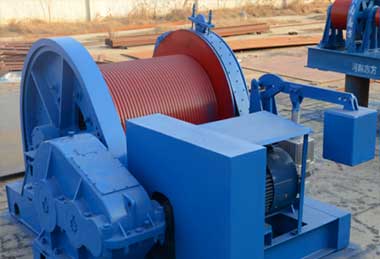
Spiral groove surface reel (feature: no flange, commonly used for single layer reel)

Spiral groove surface reel (feature: no flange, commonly used for single layer reel)
- According to the number of layers of wire rope wound on the reel: it is divided into single-layer winding reel and multi-layer winding reel.
- Most cranes use single-layer winding drums, and multi-layer winding drums are used for cranes with extremely large lifting heights or requiring compact structures (such as truck cranes).
- The roll material is generally cast iron. It can be cast steel or rolled and welded with steel plate when needed.
- The common damaged part is the groove for winding the rope. The reason for the damage is the wear of the wire rope on him; when the deflection angle of the drum and the pulley is too large, the peak groove of the drum will also be worn, and the result will be that the wire rope will be damaged. out of groove.
Wheel set
Wheels are divided into single rim, double rim and no rim wheels. The function of the rim is to guide and prevent the trolley body from derailing.
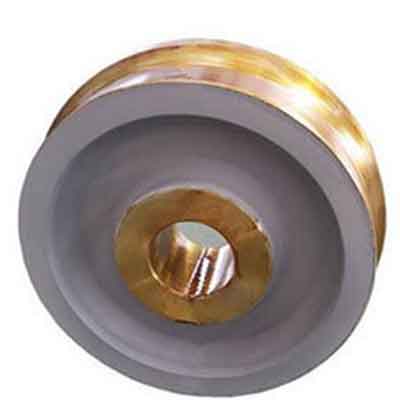
single rim wheel
Generally used for trolley wheels
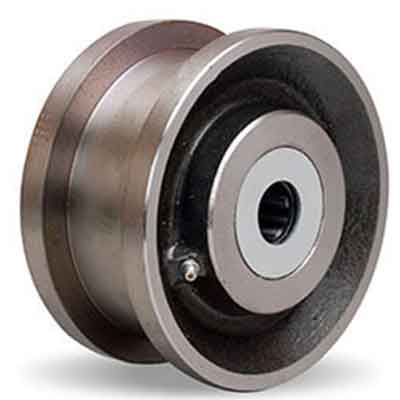
double rim wheels
Wheels for crane trolley ;
Rimless wheels are generally not used on cranes.
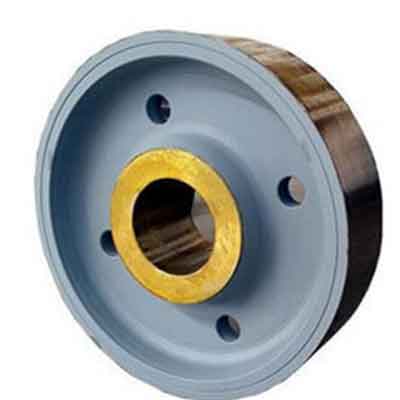
The wheel set is mainly composed of bearing housings and wheels.
Housing material: gray iron, ductile iron, cast steel.
Wheel material: No. 45 steel, ductile iron, 65Mn, 50SiMn, 42CrMo.
Wheel technology: casting, forging.
Scrap standards for wheels:
- When cracks are found on the tread and rim of the wheel, the wheel should be replaced.
- When the wear of the rim of the wheel exceeds 50% of the original thickness, or when the bending deformation of the rim reaches 20% of the original thickness, the wheel should be scrapped.
- During use, if the tread peels off and the scratched area is greater than 2c㎡ and the depth is greater than 3mm, it is allowed to repair, otherwise it should be scrapped. When the tread thickness loss reaches 15% of the original thickness, the wheel is scrapped.
- The wheels are relatively easy to wear and tear, and the frequency of use is different, so they need to be replaced according to the usage conditions.
Production time: 1)10-15 days delivery for standard wheels, 2) 30-45 days for non-standard wheels according to the process and material requirements.
Overhead Bridge Crane Workshop & Crane Runway & Crane Rails
Your Trusted Overhead Travelling Crane Manufacturer & Supplier
Overhead Bridge Crane Workshops, Runways & Crane Rails
Crane Basics to Know Your Workshop & Get Custom Bridge Crane Design & Runway System
Knowing the workshop conditions and dimensions is crucial when selecting an overhead crane because it helps to determine the most suitable crane configuration for the specific application. The available headroom, floor space, and lifting height requirements are all important factors to consider when selecting an overhead crane. The capacity of the loads that will be lifted and the types of loads that the crane will handle also need to be taken into account. By understanding the workshop conditions and dimensions, you can select an overhead crane that will operate safely and efficiently within the available space and meet your lifting needs.

Your Trusted Overhead Travelling Crane Manufacturer & Supplier
Workshop Dimensions Affect Your Overhead Bridge Crane Designs

- 1 Height from the ground to the lowest point of the plant
- 2 rail top elevation
- 3 crane spans
- 4 The distance between the center of the track and the side of the factory building
- 5 lifting height
- 6 large car running track models
- 7 rail beam model
- From this, a crane suitable for the plant can be determined
When designing a custom overhead crane for your workshop or facility, there are several key factors to consider:
- Available headroom: The amount of vertical space available in your workshop or facility will determine the maximum lifting height of the crane.
- Floor space: The available floor space will determine the size and configuration of the crane.
- Lifting height requirements: The required lifting height will determine the design of the crane and its components.
- Load capacity: The maximum load capacity and the types of loads that the crane will handle will determine the size and strength of the crane components.
- Building structure: The building structure and its ability to support the weight of the crane and its loads must be taken into account when designing the crane.
By considering these factors, you can design a custom overhead crane that will operate safely and efficiently within your workshop or facility and meet your specific lifting needs. Click to know more about types of crane buildings and facility.

Main specifications or main terms needs to know to get your customized electric travelling bridge crane for indoor workshops

crane runway length, crane columns for indoor workshops Clicke to check more working coverages of overhead bridge cranes
What should be considerable for new workshop or building?
When selecting an overhead crane for a workshop or facility, consider the following factors:
- Span and height: Determined by the distance between the rails and the height of the building, as well as the required lifting height.
- Lifting capacity: Based on the maximum weight of the objects to be lifted and the weight of the pick-up mechanism.
- Working level and speed: Chosen based on the load status and utilization level.
- Power supply: Must be sufficient to meet the crane's power requirements.
- Environmental conditions: Temperature, humidity, and presence of corrosive or explosive materials must be taken into account.
- Safety features: Overhead cranes must be equipped with overload protection, emergency stop systems, and anti-collision devices.
Careful evaluation of these factors is crucial when selecting an overhead crane.
A professional crane manufacturer or supplier can provide guidance and assistance in choosing the right crane for your needs.
For existing workshops
For existing workshops, there are several additional factors to consider when selecting an overhead crane:
- Building structure: The building structure must be able to support the weight and forces of the overhead crane. A structural engineer should evaluate the building to ensure it is suitable for the installation of an overhead crane.
- Obstructions: The presence of any obstructions, such as columns, beams, or equipment, must be considered when selecting the span and height of the overhead crane.
- Floor space: The floor space of the workshop must be sufficient to accommodate the movement of the crane and the placement of loads.
- Access: Adequate access must be provided for the installation, maintenance, and repair of the overhead crane.
- Electrical systems: The existing electrical systems of the workshop must be able to support the power requirements of the overhead crane.
It is important to carefully evaluate these factors when selecting an overhead crane for an existing workshop. A professional crane manufacturer or supplier can provide guidance and assistance in selecting the right overhead crane for your specific needs.
Steel Structure workshops vs. Concrete workshops
how the factors and conditions for overhead crane selection may vary between steel structure and concrete workshops:
Building Structure
When selecting an overhead crane for a workshop or facility, one important factor to consider is the building structure. Steel structure workshops typically have a higher load-bearing capacity due to the strength and rigidity of the steel frame. This allows them to support heavier cranes and loads than concrete workshops, which may have lower load-bearing capacity due to the limitations of the concrete structure. A structural engineer should evaluate the building structure to determine its suitability for the installation of an overhead crane.
- Steel structure workshops:
- Higher load-bearing capacity due to strength and rigidity of steel frame.
- Can support heavier cranes and loads.
- Concrete workshops:
- Lower load-bearing capacity due to limitations of concrete structure.
- May not be able to support as heavy cranes and loads.
For both new and existing workshops, it is important to ensure that the building can support the weight and forces of the overhead crane. A structural engineer should evaluate the building structure to determine its suitability for the installation of an overhead crane.
- For new workshops, you have the opportunity to design the building with the overhead crane in mind. This means you can ensure that the building structure is strong enough to support the crane and that the span and height of the crane are appropriate for your needs.
- For existing workshops, it is important to carefully evaluate the building structure to ensure it can support the weight and forces of the overhead crane. A structural engineer can assess the load-bearing capacity of the building and determine if any modifications or reinforcements are necessary.
Span and Height
Another important factor to consider is the span and height of the overhead crane. The span is determined by the distance between the rails on which the crane will travel, while the height is determined by the height of the building and the required lifting height of the load. Steel structure workshops may have larger spans and higher ceilings than concrete workshops, allowing for larger and taller cranes.
- Steel structure workshops:
- May have larger spans and higher ceilings.
- Can accommodate larger and taller cranes.
- Concrete workshops:
- May have smaller spans and lower ceilings.
- May not be able to accommodate as large or tall cranes.
For new workshops, you can design the building with the span and height of the overhead crane in mind. This means you can ensure that there is enough space for the crane to operate effectively.For existing workshops, it is important to accurately measure the span and height to ensure that the selected crane will fit within the existing workshop space. Any obstructions, such as columns or beams, should also be taken into account.
Lifting Capacity
The lifting capacity of the overhead crane is another important factor to consider. This is determined by the maximum weight of the objects to be lifted and the weight of the pick-up mechanism. Steel structure workshops may be able to support cranes with higher lifting capacities due to their higher load-bearing capacity.
- Steel structure workshops:
- Higher load-bearing capacity allows for cranes with higher lifting capacities.
- Concrete workshops:
- Lower load-bearing capacity may limit crane lifting capacities.
Working Level and Speed
The working level and speed of the overhead crane are also important factors to consider. The working level is chosen based on the load status and utilization level, while the working speed is determined by the required speed of lifting, traveling, and trolley movements. These factors may vary between steel structure and concrete workshops depending on their specific operational requirements.
- Steel structure workshops:
- Working level and speed requirements may vary depending on operational needs.
- Concrete workshops:
- Working level and speed requirements may vary depending on operational needs.
Power Supply
The power supply for the overhead crane must also be considered. It must be sufficient to meet the power requirements of the crane's motors and control systems. Steel structure workshops may have different power supply requirements than concrete workshops due to differences in crane size, lifting capacity, and operational requirements.
- Steel structure workshops:
- Power supply requirements may vary depending on crane size, lifting capacity, and operational needs.
- Concrete workshops:
- Power supply requirements may vary depending on crane size, lifting capacity, and operational needs.
Environmental Conditions
Environmental conditions, such as temperature, humidity, and presence of corrosive or explosive materials, must also be taken into account when selecting an overhead crane. These conditions may vary between steel structure and concrete workshops depending on their specific operational requirements.
- Steel structure workshops:
- Environmental requirements may vary depending on operational needs.
- Concrete workshops:
- Environmental requirements may vary depending on operational needs.
Safety Features
Finally, safety features such as overload protection, emergency stop systems, and anti-collision devices are essential for ensuring safe operation of an overhead crane. These features are important for both steel structure and concrete workshops, but their specific requirements may vary depending on the size, lifting capacity, and operational requirements of the crane.
- Steel structure workshops:
- Safety feature requirements may vary depending on crane size, lifting capacity, and operational needs.
- Concrete workshops:
- Safety feature requirements may vary depending on crane size, lifting capacity, and operational needs.
In summary, factors such as building structure, span, height, lifting capacity, working level, speed, power supply, environmental conditions, and safety features may vary between steel structure and concrete workshops when selecting an overhead crane. A professional crane manufacturer or supplier can provide guidance and assistance in selecting the right overhead crane for your specific workshop type. Click to learn more on cranes workshops and crane building.
Your Trusted Overhead Travelling Crane Manufacturer & Supplier
Bridge Cranes runways and rails
Overhead crane runways are the structural elements of an overhead crane that provide stability and support to the bridge crane structure.


Overhead crane end carriages with wheels running on crane rails

Overhead bridge crane crane rail installation
There are several main types of crane runways, including top-running, underhung, free-standing, and semi-free standing crane runways.
- Top-running crane runways are commonly used for top-running single-girder cranes and top-running double-girder cranes. These runways include a stationary rail mounted to each runway beam, which the end trucks use to transport the bridge and hoist along the crane runway.
- Underhung crane runways utilize a rail mounted under the runway as opposed to on top. This design increases the working range of the crane, making it ideal for spaces with less headroom.
- Free-standing crane runways are self-supporting structures that can be located indoors or outdoors. They do not require support from the building structure and can be used for a variety of overhead crane types.
- Semi-free standing crane runways utilize the structure itself to help support the longitudinal and lateral forces acting on the crane. They do not require as much steel as other designs, making them more cost-effective.
The main components of a crane runway include the vertical support columns, the bridge girder to support the rail, and the trolley/hoist assembly. The crane rail is also an important component of the crane runway, providing a smooth, level surface for the end trucks to travel along. All of these components work together to provide support and rigidity to the bridge crane assembly and ensure safe and efficient operation of the overhead crane.
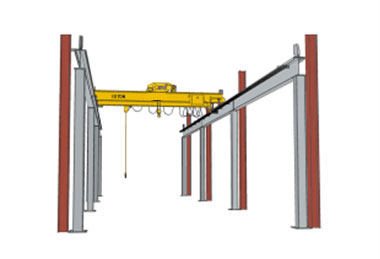
A semi-free standing crane runway is a type of crane runway that utilizes the structure itself to help support the longitudinal and lateral forces acting on the crane. This type of crane runway is typically used when the building structure is not capable of supporting the full weight and forces of the overhead crane, but can provide some support.
Semi-free standing crane runways do not require as much steel as other designs, making them more cost-effective. They are typically braced back to the building structure to provide additional support and stability.
Some features of semi-free standing crane runways include:
- Utilizes the structure itself to help support the forces acting on the crane
- Does not require as much steel as other designs
- More cost-effective than other designs
- Typically braced back to the building structure for additional support and stability
It is important to carefully evaluate your specific needs and requirements when selecting a crane runway for your overhead crane. A professional crane manufacturer or supplier can provide guidance and assistance in selecting the right type of crane runway for your specific needs.
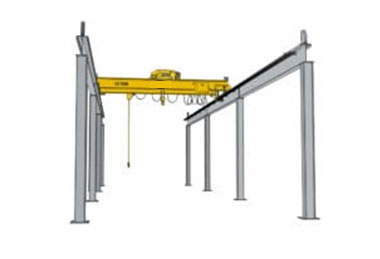
Free-standing crane runways are self-supporting structures that can be located indoors or outdoors. They do not require support from the building structure and can be used for a variety of overhead crane types.
Features of freestadning crane runways
- Self-supporting structure that can be located indoors or outdoors
- Does not require support from the building structure
- Can be used for a variety of overhead crane types
- A free-standing runway system is used when the building cannot support any loading and footers may be required.
- This type of system requires more steel to fabricate compared to a system that can be tied back.
- Our factory uses moment columns instead of "A" frame columns.
- Moment columns use the foundation to support and stabilize the system.
- No bracing is needed, as there is more steel in the column than in a system tied to the building.
- "A" frame columns may be less expensive, but they take up more space.
- Longitudinal bracing is standard.
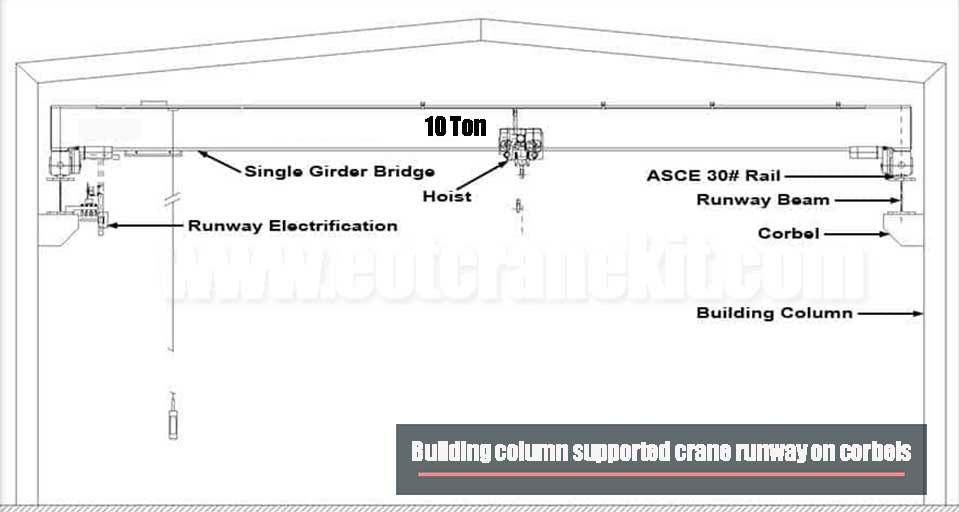
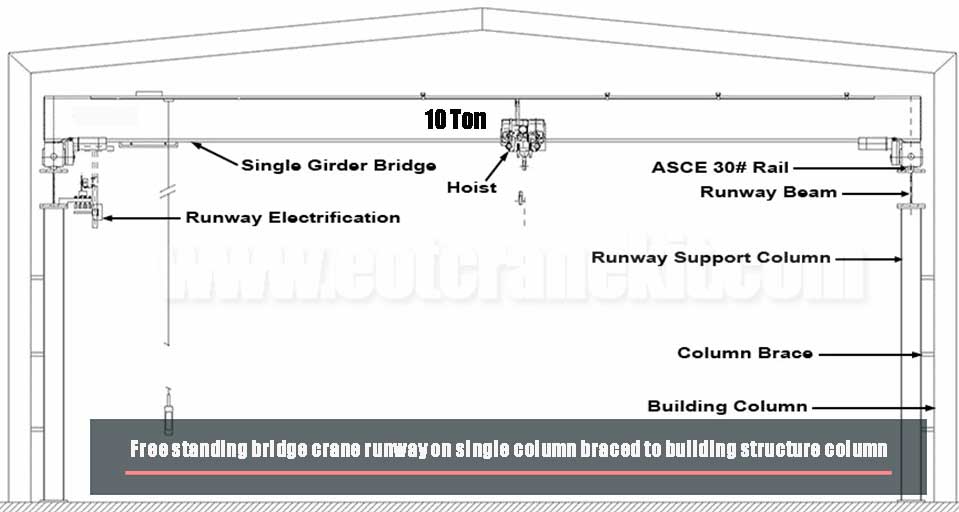
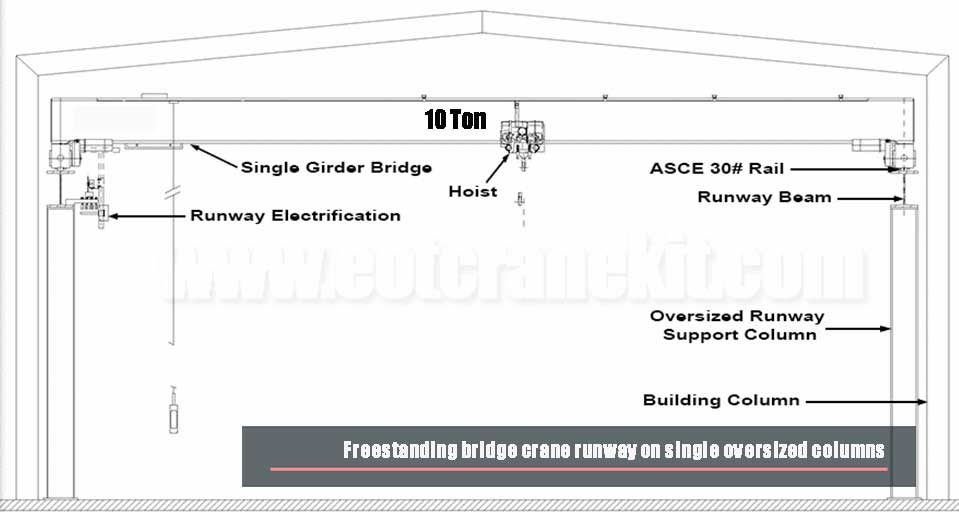

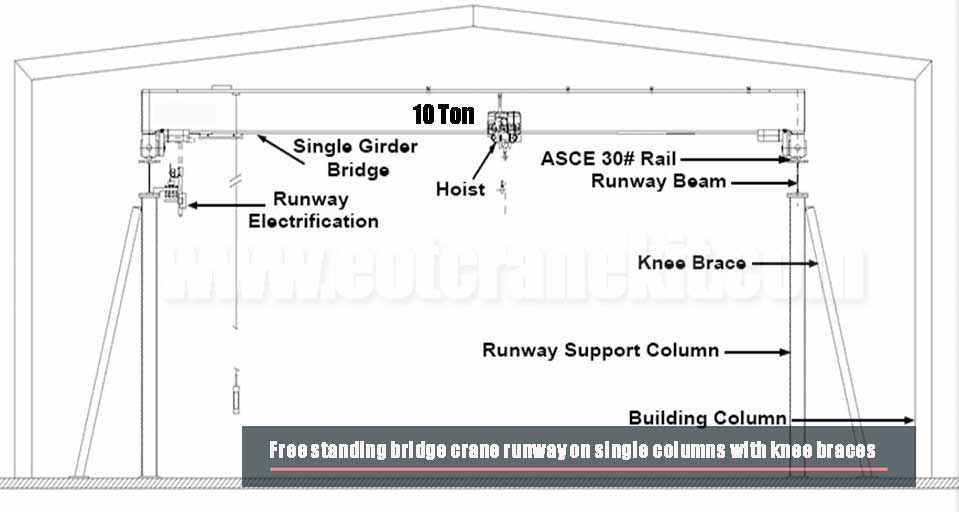


Columns mounting
- Footer takes lateral and longitudinal loads imposed on the system.
- Takes up minimal floor space.
- Larger footer design.
- Increases the cost of the system, but the best choice for columns.
Ceiling mounted runways
A ceiling mounted crane runway is a type of crane runway that is mounted to the ceiling of a building. This type of crane runway is typically used for underhung cranes, which are suspended from the ceiling and travel along the bottom flange of the runway beam.
Ceiling mounted crane runways are commonly used in facilities where floor space is limited or where there are obstructions on the floor that would interfere with the operation of a floor-mounted crane. They can also be used to maximize the lifting height of the crane by utilizing the full height of the building.

Ceiling Mounted
Some features of ceiling mounted crane runways include:
- Mounted to the ceiling of a building
- Typically used for underhung cranes
- Ideal for facilities with limited floor space or obstructions on the floor
- Can maximize lifting height by utilizing the full height of the building
- A ceiling mounted crane runway is attached to the building trusses or other support structure.
- Longitudinal bracing is required on both sides.
- Lateral bracing is only required on one side.
- The design of the building and roof trusses may limit the options for a ceiling mounted crane runway.


Crane rails
The crane rail is a key component of the crane runway. It is mounted on top of the runway beam and provides a smooth, level surface for the end trucks of the crane to travel along. The end trucks use the rail to transport the bridge and hoist along the crane runway .

crane rail drawing

Overhead bridge crane rail
Overhead crane rails are tracks that overhead cranes use to move along. These rails are attached to supporting beams, which can be made of steel or concrete. Crane rails come in two types: light rail (P) and heavy rail (QU). P-type railroad rail is used for small and medium tonnage cranes, while QU type crane special rail or square rail is used for large tonnage gantry cranes. There are also special rails designed for specific needs and applications.
- Light rail refers to steel rails weighing less than or equal to 30 kilograms per meter
- Heavy rail refers to steel rails weighing more than 30 kilograms per meter (including overweight machine rails)
- A steel plate is a flat steel material with a large aspect ratio and surface area. According to the thickness, it can be divided into three types: thin plate (thickness <4mm), medium plate (thickness 4-25mm) and thick plate (thickness >25mm). Steel strips are included in the class of steel plates.
Track Model Table | ||||||
light rail, | Model | Height A | Bottom width B | Head width C | Track Waist Thickness | kg/m |
P8 | 65 | 54 | 25 | 7 | 8.42 | |
P12 | 69.85 | 69.85 | 38.1 | 7.54 | 12.2 | |
P15 | 79.37 | 79.37 | 42.86 | 8.33 | 15.2 | |
P18 | 90 | 80 | 40 | 10 | 18.06 | |
P22 | 93.66 | 93.66 | 50.8 | 10.72 | 22.3 | |
P24 | 107 | 92 | 51 | 10.9 | 24.95 | |
P30 | 107.95 | 107.95 | 60.33 | 12.3 | 30.1 | |
heavy rail | Model | Height | Bottom width | Head width | Track Waist Thickness | kg/m |
P38 | 134 | 114 | 68 | 13 | 38.733 | |
P43 | 140 | 114 | 70 | 14.5 | 44.653 | |
P50 | 152 | 132 | 70 | 15.5 | 51.514 | |
How to select crane rail systems
When choosing a crane rail system for your application, several factors need to be considered to ensure optimal performance and safety. Here are some key factors to consider:
- Load requirements: Determine the maximum load capacity and the types of loads your crane rail system will be handling.
- Size of the crane rail: Consider the head width, height, bottom width, and web thickness of the crane rail. The width of the rails head is related to the design of the crane wheel.
- Type of crane rail: Choose between light rail type (P) and heavy rail type (QU) depending on the tonnage of the crane.
- Special needs and applications: Consider if there are any special needs or applications that require a specific type of crane rail.
It may be helpful to consult with a crane rail supplier or manufacturer to determine the best crane rail system for your specific needs. They can provide expert advice and guidance on selecting the right crane rail system for your application.
Matching of Crane wheels and crane rail
To ensure proper matching of crane wheels to crane rails, several factors need to be considered:
- Size of the crane rail: The head width, height, bottom width, and web thickness of the crane rail are related to the design of the crane wheel.
- Hardness of the raw material: The hardness of the raw material used to make the wheels and the heat treating techniques used to enhance the metal's hardness play a role in ensuring proper matching of wheels to tracks.
- Periodic inspection: It is important to periodically inspect cranes, including the wheels, to detect premature wheel wear and correct any issues before they can cause substantial damage.
It may be helpful to consult with a crane rail supplier or manufacturer for specific guidance on ensuring proper matching of crane wheels to crane rails for your application.
Guide on How to Select Proper Crane Duty for Your Overhead Cranes
Your Trusted Overhead Crane Manufacturer & Supplier
Comprehensive Guide to Selecting the Proper Crane Working Duty
Choosing the right crane working duty might not seem like the most exciting task, but it's a decision that can significantly impact the efficiency, safety, and productivity of your operations.
Overveiw of Crane Duties
Crane working duties are categorized into different classifications based on the intensity of workload they can handle. When a crane builder calculates the duty cycle for your application, they do so using FEM, ASME and CMAA classification systems. FEM classifications are primarily employed in Europe and are the standard for hoist, trolley and bridge duty motion. In North America, crane builders use ASME classifications to provide duty cycle standards for the hoist and CMAA standards for the duty cycle of the trolley and bridge. Each of the following standards are intended to be a guide to manufactures, purchasers or users when defining duty cycles.
Cranes Work duty Classification
Work Duty | Intermittent Service | |||||
| State of loading | FEM | ISO | GB | Cycles/H | Start/H | Ed in % |
| Light | 1DM | M1 | A1 | 15 | 90 | 15 |
| 1CM | M2 | A2 | 20 | 120 | 20 | |
| Moderate | 1BM | M3 | A3 | 25 | 150 | 25 |
| 1AM | M4 | A4 | 30 | 180 | 30 | |
| Heavy | 2M | M5 | A5 | 40 | 240 | 40 |
| 3M | M6 | A6 | 50 | 300 | 50 | |
| Super Heavy | 4M | M7 | A7 | 60 | 360 | 60 |
| 5M | M8 | A8 | 60 | 360 | 60 | |
Crane Duty Classifications in United States and Canada:
In the United States and Canada, various organizations provide standards for defining crane duty classifications, ensuring that lifting equipment meets the specific requirements of different applications. One such organization is the Crane Manufacturers Association of America (CMAA), which outlines duty classifications ranging from Class A to Class F.
| Classification | Description |
|---|---|
| Class A | Standby or infrequent usage, such as cranes found in power utilities or motor rooms, where precise handling of equipment at slow speeds with long idle periods between lifts occurs. |
| Class B | Light service, such as cranes used in repair shops or light warehousing, at slow speeds, with up to five lifts per hour up to maximum rated capacity. |
| Class C | Moderate service, such as those cranes installed in machine shops, including handling an average of 50% of the rated capacity up to 10 times per hour. |
| Class D | Heavy service, such as cranes deployed in heavy machine shops, foundries, container yards, and more, where loads of 50% of the rated capacity are handled constantly. |
| Class E | Severe service, such as cranes found in scrap yards, cement mills, lumber mills, and more, where the crane makes 20 or more lifts per hour at or near its rated capacity. |
| Class F | Continuous severe service, including custom-designed specialty cranes, that handle loads approaching the maximum rated capacity non-stop under extreme conditions. |
You can then use the table below to find your required FEM classification.
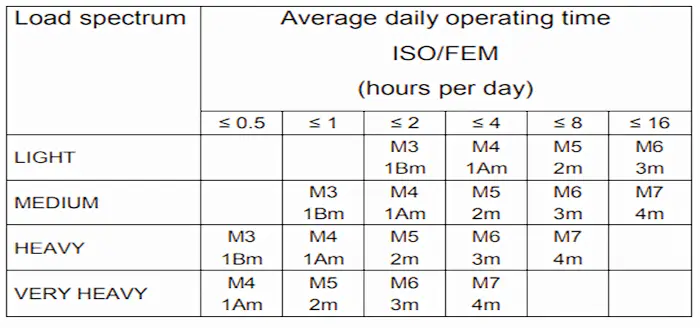
Average daily operating time of Light duty to very heavy duty crane based on Iso and fem standards
As you can see on this table, the FEM classification system aligns with the ISO crane duty classification system. The only difference is in the names of the categories: an FEM 1Am category crane is equivalent to an ISO M4 category crane.
Crane Duty Classifications in China
In China, overhead crane duty classification serves as a primary technical parameter, essentially representing the structural duty classification of the crane. This classification is determined by the lifting mechanism and is denoted by the labels A1 to A8. Specifically, A1 to A4 are considered light duty, A5 and A6 fall into the medium duty category, A7 is classified as heavy duty, and A8 represents extremely heavy duty. These classifications reflect the crane's utilization level, which encompasses the total number of working cycles throughout its entire design life cycle, as well as its load state.
Various countries adopt distinct standards for overhead crane duty classification, with commonly chosen ones including FEA, CMAA, and GB. Despite differences in standards, they share a common load spectrum. For reference, a GB standard table is provided below.

Crane Duty Classifications in China
Classifications of Crane Working Duties
Light Duty:
Light-duty cranes are engineered for tasks involving relatively light loads and infrequent use. Their design prioritizes precision and agility over sheer lifting power, making them suitable for applications where delicate handling and maneuverability are essential. Here are some key characteristics and examples of light-duty cranes:
Characteristics:
Lower lifting capacities compared to heavy-duty counterparts.
Compact and lightweight construction for easy installation and maneuverability.
Designed for intermittent use and occasional lifting tasks.
Versatile and adaptable to various work environments.
Examples:
Small Workshops: Light-duty cranes are commonly used in small workshops where space constraints and occasional lifting requirements are prevalent. These cranes facilitate the handling of lightweight materials, tools, and components with precision and efficiency.
Warehouses: In warehouses with low to moderate lifting demands, light-duty cranes provide a cost-effective solution for loading and unloading goods, organizing inventory, and performing maintenance tasks. They offer flexibility in maneuvering within confined spaces while ensuring safe and efficient material handling operations.
Assembly Lines: Light-duty cranes play a role in assembly line operations, where they assist in positioning and transferring components during manufacturing processes. Their agility and responsiveness enable operators to perform tasks with accuracy and speed, contributing to streamlined production workflows.
Light-duty cranes are ideal for applications where occasional lifting tasks require a balance of performance, affordability, and versatility. By selecting light-duty cranes tailored to their specific requirements, businesses can optimize efficiency, enhance workplace safety, and meet operational needs with precision and agility.
Moderate Duty:
Moderate-duty cranes serve as versatile workhorses capable of handling a diverse range of loads across various applications. They strike a balance between load capacity and frequency of use, making them suitable for a wide array of industrial settings. Here are the key characteristics and applications of moderate-duty cranes:
Characteristics:
Moderate lifting capacities, typically higher than light-duty cranes but lower than heavy-duty counterparts.
Designed to withstand moderate to frequent use, offering a reliable solution for ongoing lifting tasks.
Versatility in handling different loads and adapting to changing operational requirements.
Robust construction and durable components for enhanced longevity and performance.
Applications:
Manufacturing Facilities: Moderate-duty cranes are commonly deployed in manufacturing facilities where they play a crucial role in material handling and production processes. From moving raw materials and components to positioning finished products, these cranes contribute to the efficiency and productivity of assembly lines and manufacturing operations.
Construction Sites: In construction environments, moderate-duty cranes are utilized for lifting and positioning building materials, equipment, and structures. Whether it's lifting steel beams on high-rise construction projects or transporting heavy machinery on job sites, these cranes provide the versatility and reliability required to meet the demands of construction operations.
Warehouses and Distribution Centers: Moderate-duty cranes are integral to warehouse and distribution center operations, where they facilitate the movement of goods, pallets, and containers. These cranes are employed for tasks such as loading and unloading trucks, stacking and retrieving inventory, and optimizing storage space within the facility. Their versatility and adaptability make them essential for maintaining efficient warehouse logistics and maximizing throughput.
Moderate-duty cranes offer a versatile and reliable solution for a wide range of industrial applications. Their ability to handle moderate loads with efficiency and durability makes them indispensable assets in manufacturing, construction, and warehousing environments. By selecting moderate-duty cranes tailored to their specific operational requirements, businesses can optimize productivity, streamline material handling processes, and achieve operational excellence.
Heavy Duty:
Heavy-duty cranes are purpose-built to handle substantial loads and endure the rigors of continuous operation in demanding industrial environments. Designed with robust components and mechanisms, these cranes excel in lifting heavy materials and equipment with precision and reliability. Here are the key characteristics and industries that rely on heavy-duty cranes:
Characteristics:
High lifting capacities, capable of handling heavy loads ranging from several tons to hundreds of tons.
Built with rugged construction and reinforced components to withstand the stress of lifting heavy materials.
Engineered for continuous operation, with durable mechanisms and systems that ensure reliability and longevity.
Equipped with advanced safety features and overload protection systems to mitigate risks associated with heavy lifting.
Industries:
Steel Fabrication Plants: Heavy-duty cranes play a pivotal role in steel fabrication plants, where they are used for handling raw materials, semi-finished products, and finished steel components. These cranes are essential for lifting heavy steel beams, plates, coils, and structures throughout the fabrication process, including cutting, welding, bending, and assembly operations.
Mining Operations: In mining environments, heavy-duty cranes are utilized for various tasks such as ore extraction, material handling, and equipment maintenance. These cranes are deployed in surface mining operations, underground mines, and processing plants to lift heavy machinery, vehicles, and bulk materials such as coal, ore, and minerals.
Shipyards: Shipbuilding and repair facilities rely on heavy-duty cranes for lifting ship components, modules, and sections during construction and maintenance projects. These cranes are essential for handling ship hulls, propulsion systems, decks, and other large-scale components with precision and efficiency.
Heavy-duty cranes are indispensable assets in industries that require the lifting of heavy materials and equipment. Their robust design, high lifting capacities, and reliability make them ideal for demanding applications where safety, efficiency, and productivity are paramount. By investing in heavy-duty cranes tailored to their specific operational needs, businesses can optimize performance, minimize downtime, and ensure the success of their operations in challenging environments.
Severe Duty:
Severe-duty cranes represent the pinnacle of crane engineering, designed to operate flawlessly in the most extreme and challenging conditions. These cranes are built to withstand continuous, high-intensity operations where reliability, durability, and safety are of utmost importance. Here are the key characteristics and applications of severe-duty cranes:
Characteristics:
Exceptional durability and reliability, with robust construction and heavy-duty components capable of enduring harsh operating conditions.
Engineered for continuous operation in extreme environments, including high temperatures, corrosive atmospheres, and heavy dust or debris.
Advanced safety features and redundant systems to ensure the protection of personnel and equipment during high-intensity lifting tasks.
Precision engineering and high-performance mechanisms to maintain accuracy and efficiency under demanding operational requirements.
Applications:
Foundries: Severe-duty cranes are essential in foundry operations where they are subjected to extreme temperatures, heavy loads, and corrosive atmospheres. These cranes are used for handling molten metal, molds, and heavy castings throughout the production process, including pouring, cooling, and finishing operations.
Aerospace Manufacturing: In aerospace manufacturing facilities, severe-duty cranes are employed for lifting and positioning large aircraft components, engines, and assemblies. These cranes operate in cleanroom environments and are designed to meet stringent safety and quality standards while providing precise control and reliability.
Offshore Drilling Platforms: Severe-duty cranes play a critical role on offshore drilling platforms, where they are used for lifting heavy equipment, supplies, and personnel between the platform and supply vessels. These cranes operate in challenging offshore environments characterized by high winds, saltwater exposure, and dynamic load conditions, requiring robust construction and advanced safety features.
Severe-duty cranes are indispensable assets in industries where the operating conditions are exceptionally demanding. Their ability to withstand extreme environments and maintain high levels of performance and reliability make them essential for critical lifting operations in foundries, aerospace manufacturing, offshore drilling, and other specialized applications. By investing in severe-duty cranes engineered to meet their specific operational requirements, businesses can ensure the safety, efficiency, and success of their operations in the most challenging environments.
Factors Influencing the Selection of Working Duty
The selection of crane working duty is influenced by various factors, each playing a crucial role in determining the optimal duty classification. Let's delve deeper into these factors:
Load Capacity:
The primary function of a crane is to lift and move materials safely and efficiently. The weight of the materials being lifted directly impacts the required lifting capacity of the crane. Whether it's handling lightweight components or heavy machinery, selecting a crane with the appropriate load capacity ensures smooth and reliable lifting operations.
The load capacity of a crane is its ability to lift and transport materials safely and efficiently. It is one of the most critical factors to consider when selecting a crane for a specific application. Here's why load capacity is essential:
- Primary Function: The primary purpose of a crane is to lift and move materials. The load capacity determines the maximum weight that the crane can lift without exceeding its structural limitations or compromising safety.
- Safety: Exceeding the load capacity of a crane can lead to equipment failure, structural damage, and potential accidents. Selecting a crane with a sufficient load capacity ensures that lifting operations can be conducted safely without risking overloading or instability.
- Efficiency: Choosing a crane with the appropriate load capacity enhances operational efficiency by allowing for the handling of materials in a single lift, minimizing the need for multiple lifts or manual handling methods.
- Application Specific: Different applications require cranes with varying load capacities to accommodate the weight of the materials being lifted. Whether it's lifting lightweight components in a manufacturing plant or heavy machinery in a construction site, selecting a crane with the right load capacity is essential for meeting the specific requirements of the application.
- Smooth Operation: Cranes operate most effectively within their designed load capacities. Operating within the crane's rated load ensures smooth and reliable lifting operations, minimizing downtime and maximizing productivity.
In summary, the load capacity of a crane is a fundamental consideration in crane selection, ensuring safety, efficiency, and optimal performance in lifting operations across various industries and applications.
Relationship between Crane Duty and Crane Capacity:
- Crane Duty: Crane duty classification is a vital aspect of crane design and selection, encompassing factors such as operational demands, environmental conditions, and usage frequency. It categorizes cranes into different classes, ranging from light-duty (Class A) to severe-duty (Class F), based on their intended application. This classification ensures that the crane is designed and constructed to meet the specific requirements of its operating environment and workload. Factors considered in crane duty classification include the frequency of crane use, the intensity of operation, and the harshness of the operating environment.
- Crane Capacity: Crane capacity refers to the maximum load weight that a crane can safely lift and transport. It is determined by the crane's structural strength, mechanical components, and lifting mechanisms. Crane capacity is crucial for ensuring safe lifting operations and preventing overloading, which can lead to equipment damage, accidents, and injuries. Capacity specifications consider both static and dynamic loads, accounting for factors such as load distribution, impact forces, and safety margins.
While crane duty and crane capacity are related, they represent distinct aspects of crane design and performance. Higher-duty cranes typically have higher lifting capacities to meet the demands of more intensive operations. However, the relationship between duty and capacity is not always linear. Some cranes may have high lifting capacities but lower duty classifications if they are designed for infrequent or specialized usage. Conversely, cranes with lower lifting capacities may have higher duty classifications if they are engineered for continuous or high-frequency operation in demanding environments.
In summary, crane duty and crane capacity are essential considerations when selecting a crane for a specific application. While they are related, they represent different facets of crane performance, each influencing the suitability and effectiveness of the crane for its intended use. By understanding the interplay between duty classification and capacity specifications, businesses can make informed decisions to ensure optimal crane performance and safety in their operations.
Frequency of Use:
How often the crane will be in operation is a key determinant of its duty cycle. Cranes used for frequent lifting tasks require higher-duty classifications to withstand the rigors of continuous operation. Conversely, cranes used infrequently or for lighter lifting tasks may be suitable for lower-duty classifications. Understanding the frequency of crane use helps in selecting a duty classification that matches the operational demands.
The frequency of crane operation is a crucial factor in determining its duty cycle and selecting the appropriate duty classification. Here's why the frequency of use is essential:
- Duty Cycle Determination: The duty cycle of a crane, which refers to its intended usage pattern and workload capacity, is directly influenced by how often the crane will be in operation. Cranes used for frequent lifting tasks require higher-duty classifications to withstand the rigors of continuous operation, while those used infrequently or for lighter lifting tasks may be suitable for lower-duty classifications.
- Operational Demands: Understanding the frequency of crane use helps in assessing the operational demands placed on the crane. Cranes operating in environments with high usage rates and continuous lifting tasks, such as manufacturing plants or construction sites, require heavy-duty classifications to ensure reliability, durability, and safety under demanding conditions.
- Optimizing Performance: Selecting a duty classification that matches the frequency of crane use optimizes performance and extends the crane's service life. Overloading or operating a crane beyond its intended duty cycle can lead to premature wear and tear, increased maintenance requirements, and potential safety hazards. By aligning the duty classification with the frequency of use, crane operators can maximize efficiency and minimize downtime.
- Cost Considerations: Matching the duty classification to the frequency of crane use helps in balancing performance requirements with cost considerations. Investing in a higher-duty classification than necessary for infrequently used cranes may result in unnecessary expenses, while selecting a lower-duty classification for high-frequency use can lead to premature equipment failure and increased long-term costs.
In summary, understanding the frequency of crane use is essential for selecting the appropriate duty classification that aligns with operational demands, optimizes performance, and ensures the safety and reliability of lifting operations. By assessing the frequency of crane use upfront, businesses can make informed decisions when choosing the right crane for their specific application requirements.
Operating Environment:
Environmental conditions have a significant impact on crane performance and longevity. Factors such as temperature, humidity, and exposure to corrosive substances can affect the crane's structural integrity, electrical components, and mechanical systems. Cranes operating in harsh environments, such as outdoor construction sites or chemical processing plants, may require higher-duty classifications and specialized coatings or materials to withstand these conditions effectively.
The operating environment plays a critical role in determining the performance and longevity of a crane. Here's why considering the operating environment is essential:
- Impact on Crane Performance: Environmental factors such as temperature, humidity, and exposure to corrosive substances can affect various aspects of crane operation, including structural integrity, electrical components, and mechanical systems. Extreme temperatures can cause expansion and contraction of crane components, affecting their functionality and reliability. High humidity levels can promote corrosion and rust formation, leading to premature deterioration of crane materials and components.
- Selection of Duty Classification: Cranes operating in harsh environments, such as outdoor construction sites, chemical processing plants, or marine terminals, may require higher-duty classifications to withstand the rigors of these conditions effectively. Higher-duty classifications feature robust construction, corrosion-resistant materials, and specialized coatings to enhance durability and longevity in challenging environments. By selecting the appropriate duty classification based on the operating environment, businesses can ensure the reliability and safety of crane operations.
- Specialized Coatings and Materials: In addition to selecting the right duty classification, cranes operating in harsh environments may benefit from specialized coatings or materials designed to withstand specific environmental challenges. For example, cranes operating in coastal areas or chemical processing plants may require corrosion-resistant coatings to protect against saltwater exposure or chemical fumes. Similarly, cranes operating in high-temperature environments may require heat-resistant materials to prevent degradation and maintain performance.
- Maintenance Requirements: Environmental factors can also influence crane maintenance requirements. Cranes operating in harsh environments may require more frequent inspections, cleaning, and preventive maintenance to mitigate the effects of environmental wear and tear. Implementing a proactive maintenance program tailored to the specific operating environment helps prolong crane service life, minimize downtime, and ensure safe and reliable operation.
In summary, considering the operating environment is essential for selecting the appropriate duty classification and implementing measures to enhance crane performance and longevity. By understanding the environmental challenges faced by the crane and implementing proactive maintenance practices, businesses can optimize crane reliability, safety, and efficiency in diverse operating conditions.
Safety Requirements:
Safety is paramount in crane operations, and compliance with safety regulations and standards is essential to protect personnel and equipment from accidents and hazards. Different industries and jurisdictions have specific safety requirements governing crane design, installation, operation, and maintenance. Selecting a crane with the appropriate duty classification ensures compliance with safety standards and minimizes the risk of accidents due to overload or structural failure.
Safety is paramount in crane operations, and adherence to safety regulations and standards is essential to protect personnel and equipment from accidents and hazards. Here's why considering safety requirements is crucial:
- Regulatory Compliance: Different industries and jurisdictions have specific safety regulations and standards governing crane design, installation, operation, and maintenance. These regulations are put in place to ensure the safety of workers, prevent accidents, and mitigate risks associated with crane operations. Selecting a crane with the appropriate duty classification ensures compliance with these safety standards, minimizing the risk of non-compliance penalties and legal liabilities.
- Personnel Safety: The safety of crane operators, riggers, and other personnel involved in crane operations is of utmost importance. Cranes with higher-duty classifications are engineered with robust structural components, advanced safety features, and redundant systems to enhance personnel safety and mitigate the risk of accidents due to overload or structural failure. Additionally, safety devices such as limit switches, overload protection, and emergency stop systems are integral to crane design to prevent hazardous situations and protect personnel from harm.
- Equipment Safety: In addition to personnel safety, ensuring the safety of crane equipment is essential for preventing damage, downtime, and costly repairs. Cranes operating within their designated duty classifications are less likely to experience overload, fatigue, or structural failure, reducing the risk of equipment damage and associated safety hazards. Regular inspections, preventive maintenance, and adherence to manufacturer's recommendations further enhance equipment safety and reliability.
- Risk Mitigation: Selecting a crane with the appropriate duty classification helps mitigate risks associated with crane operations, including structural failure, overloading, and operational errors. By choosing a crane that is designed and rated for the intended application and workload, businesses can minimize the likelihood of accidents and ensure safe and efficient lifting operations.
In summary, safety requirements are integral to crane selection and operation, and compliance with safety regulations and standards is essential to protect personnel and equipment from accidents and hazards. Selecting a crane with the appropriate duty classification ensures compliance with safety requirements, enhances personnel and equipment safety, and mitigates risks associated with crane operations, contributing to a safer work environment and improved productivity.
Cost Considerations:
Budget constraints often play a significant role in the selection process, balancing performance requirements with financial feasibility. While higher-duty classifications offer enhanced performance and durability, they may come at a higher initial cost. Conversely, lower-duty classifications may be more cost-effective but may require more frequent maintenance and replacement over time. Businesses must weigh the upfront investment against long-term operating costs to determine the most cost-effective solution for their specific needs and budget.
Budget constraints are a critical factor in the selection process when choosing a crane, requiring a balance between performance requirements and financial feasibility. Here's why considering cost is essential:
- Initial Investment: Higher-duty classifications typically offer enhanced performance, durability, and safety features but may come with a higher initial investment cost. These cranes are engineered with robust construction, advanced technology, and additional safety mechanisms to withstand demanding operational conditions. While the upfront cost may be higher, businesses must evaluate the long-term benefits and return on investment (ROI) provided by these cranes in terms of improved productivity, reduced downtime, and lower maintenance expenses.
- Operating Costs: Lower-duty classifications may offer a more cost-effective solution upfront but may incur higher long-term operating costs due to increased maintenance, repairs, and potential downtime. These cranes may require more frequent inspections, preventive maintenance, and component replacements, leading to higher ongoing expenses over the crane's lifecycle. Businesses must consider the total cost of ownership, including maintenance, energy consumption, and downtime costs, when evaluating the financial implications of different duty classifications.
- Lifecycle Cost Analysis: Conducting a lifecycle cost analysis helps businesses assess the total cost of ownership over the crane's lifespan, taking into account initial purchase price, maintenance costs, operational expenses, and potential savings or losses associated with downtime. By comparing the total cost of ownership for different duty classifications, businesses can make informed decisions about the most cost-effective solution that aligns with their specific needs and budget constraints.
- Value Proposition: While cost is an essential consideration, businesses should also consider the value proposition offered by different duty classifications. Investing in higher-duty classifications may provide long-term benefits in terms of improved performance, reliability, safety, and operational efficiency, resulting in a higher overall ROI over the crane's lifespan. Businesses should weigh the upfront investment against the potential long-term benefits and savings when selecting the most suitable crane for their operations.
In summary, cost considerations are integral to crane selection, requiring businesses to evaluate the upfront investment, long-term operating costs, and overall value proposition provided by different duty classifications. By conducting a thorough cost analysis and considering factors such as performance, durability, and safety, businesses can make informed decisions that maximize ROI and meet their specific needs and budget requirements.
By carefully considering these factors, businesses can make informed decisions when selecting the appropriate crane working duty for their specific needs and applications. A thorough understanding of load requirements, operational demands, environmental conditions, safety considerations, and budget constraints ensures that the selected crane meets performance expectations, enhances safety, and delivers long-term value.
Determining the Operating Group of the Hoist
Determining the operating group of a hoist involves evaluating its duty cycle, load capacity, and frequency of use. This classification system helps match hoists to specific applications, ensuring safe and efficient operation. Operating groups range from light-duty to heavy-duty, with each group indicating the hoist's intended workload and performance capabilities. By accurately determining the operating group of a hoist, users can make informed decisions regarding its selection, maintenance, and usage, ultimately enhancing productivity and safety in various industrial settings.
According to the Average daily operating time to separate the lifting mechanism work duty:
Work Duty | Average daily operating time (hours per day) | |||||
≤0.5 | ≤ 1 | ≤ 2 | ≤ 4 | ≤ 8 | ≤ 16 | |
Light duty | M3 | M4 | M5 | M6 | ||
| Moderate | M3 | M4 | M4 | M6 | M7 | |
Heavy | M3 | M4 | M5 | M6 | M7 | |
Super heavy | M4 | M5 | M6 | M7 | ||
How to calculate the Average daily operating time ?
To calculate the average daily operating time of the hoist, you need to know the running time of the hoisting machinery in hours per day. This figure represents the total duration the hoist operates within a 24-hour period. For example, if the hoisting machinery runs for 8 hours per day, the average daily operating time of the hoist is 8 hours. Simply measure or estimate the number of hours the hoist is in operation each day to determine its average daily operating time accurately.
The average daily operating time of the hoist can be calculated from the running time of the hoisting machinery (hours per day):
t = (2 × H ×N × T) ÷ (V × 60)
- T:Average Daily Operating time.
- H:Average lifting height (meter)
- N:Number of Work Cycles Per Hour (cycles/h)
- T:Daily working time (h)
- V:Lifting Speed (m/min)
Assessing Client Requirements
Before selecting the right crane working duty for a client, it's essential to thoroughly assess their requirements. This involves understanding their industry sector, specific lifting needs and applications, as well as environmental factors that may impact crane operations.
Identifying the Client's Industry Sector
Understanding the client's industry sector is crucial in determining the most suitable crane solution tailored to their specific requirements. Let's delve deeper into how different industries have unique demands when it comes to crane operations:
- Manufacturing: In the manufacturing sector, efficient material handling is essential for maintaining production schedules and meeting quality standards. Clients may require cranes capable of handling heavy loads with precision and efficiency to streamline assembly processes. For example, overhead cranes equipped with specialized lifting attachments are commonly used in automotive assembly plants to lift and position large components such as engines, chassis, and body panels. These cranes enable seamless integration into assembly lines, ensuring smooth and uninterrupted production.
- Construction: The construction industry presents unique challenges due to the dynamic nature of building projects and the need to lift materials to great heights in confined spaces. Clients in this sector require cranes that can maneuver in tight spaces and lift heavy materials with precision and reliability. Tower cranes are a common sight on high-rise building sites, offering exceptional height and lifting capacity to facilitate vertical construction. Their tall, slender design and ability to reach over obstacles make them indispensable for lifting materials to elevated work areas, contributing to the efficient completion of construction projects.
- Warehousing: Efficient material handling is critical in warehousing and distribution centers, where the timely movement of goods is essential for meeting customer demands. Clients in this sector may require cranes optimized for space efficiency and rapid material handling to maximize storage capacity and throughput. Gantry cranes are commonly used in distribution centers for loading and unloading goods from trucks and organizing inventory within the warehouse. Their versatility, mobility, and ability to span large distances make them ideal for handling a wide range of products with speed and precision, ensuring efficient warehouse operations.
By identifying the client's industry sector and understanding their specific requirements, crane solutions can be tailored to meet the unique demands of each industry. Whether it's optimizing production processes in manufacturing plants, facilitating vertical construction in the building industry, or maximizing storage efficiency in warehousing facilities, selecting the right crane solution ensures optimal performance, productivity, and safety for clients across various industries.
The Client's Specific Lifting Needs and Applications
Understanding the client's specific lifting needs and applications is paramount in recommending the most suitable crane working duty. Let's explore how different requirements translate into varying duty classifications:
- Heavy-duty Cranes: Clients with operations involving the lifting of large machinery components or heavy materials require cranes with robust lifting capabilities. Heavy-duty cranes are designed to handle substantial loads and endure frequent use in demanding environments. In manufacturing plants, heavy-duty overhead cranes are essential for lifting and maneuvering heavy machinery components such as engines, chassis, and industrial equipment. These cranes are engineered with sturdy structures, powerful hoisting mechanisms, and reinforced components to ensure reliable performance and safety during heavy lifting operations.
- Light-duty Cranes: For clients with occasional lifting tasks or smaller-scale operations, light-duty cranes may be sufficient to meet their requirements. Light-duty cranes are designed for lighter loads and intermittent use, making them suitable for applications in small workshops, maintenance facilities, or warehouses. These cranes offer versatility and agility, allowing for precise handling of lightweight materials and components. Examples include light-duty overhead cranes used for loading and unloading goods from trucks or moving materials within confined spaces.
- Severe-duty Cranes: Clients operating in harsh environments or requiring continuous crane operation may necessitate severe-duty cranes to withstand the rigors of their working conditions. Severe-duty cranes are engineered for high-intensity operations in extreme environments such as foundries, steel mills, or mining sites. These cranes are built with specialized materials, coatings, and components to resist corrosion, abrasion, and environmental factors. They offer unmatched reliability and durability, ensuring uninterrupted performance even in the most challenging applications.
By understanding the client's specific lifting needs and applications, you can recommend the most suitable crane working duty that aligns with their operational requirements and performance expectations. Whether it's lifting heavy machinery components in manufacturing plants, handling occasional tasks in workshops, or operating continuously in harsh environments, selecting the right duty classification ensures optimal crane performance, safety, and efficiency for clients across diverse industries and applications.
Considering Environmental Factors
Environmental conditions play a critical role in determining the suitability of crane solutions for specific applications. Let's explore how various environmental factors can impact crane performance and longevity, and the considerations to keep in mind:
- Temperature: Extreme temperatures can affect crane components and materials, leading to accelerated wear and potential malfunctions. In high-temperature environments, such as steel mills or foundries, cranes may be subjected to intense heat, which can degrade lubricants, weaken structural elements, and impair electrical systems. Conversely, in cold environments, such as freezer warehouses or arctic regions, cranes may experience issues with lubricant viscosity, hydraulic fluid performance, and component stiffness. Selecting cranes with temperature-rated components and implementing appropriate cooling or heating systems can mitigate the effects of temperature extremes and ensure reliable crane operation.
- Humidity: High humidity levels can promote corrosion and rust formation on crane components, particularly in coastal or humid environments. Cranes operating in these conditions may require corrosion-resistant coatings, stainless steel hardware, and regular maintenance to prevent degradation and extend service life. Additionally, humidity can affect electrical components and systems, leading to issues such as moisture ingress, insulation breakdown, and electrical shorts. Implementing proper moisture protection measures and periodic inspections can help safeguard crane electrical systems from humidity-related damage.
- Exposure to Corrosive Substances: Cranes operating in environments with exposure to corrosive substances, such as chemicals, saltwater, or industrial pollutants, are susceptible to corrosion and degradation. Corrosion-resistant materials, protective coatings, and frequent cleaning are essential for preserving crane integrity and preventing premature deterioration. Regular inspections and maintenance routines should include corrosion checks and remedial actions to address any signs of corrosion or material degradation promptly.
Considering these environmental factors when assessing client requirements ensures that crane solutions are tailored to withstand the specific challenges posed by the operating environment. Whether it's implementing weatherproofing measures for outdoor cranes, installing cooling systems for high-temperature environments, or employing corrosion-resistant materials for corrosive environments, proactive measures can enhance crane performance, longevity, and reliability in diverse environmental conditions. By addressing environmental considerations upfront, clients can minimize downtime, maintenance costs, and potential safety hazards associated with environmental-related issues, ensuring optimal crane operation and productivity.
By thoroughly assessing the client's requirements and considering factors such as industry sector, lifting needs, and environmental conditions, you can recommend the most appropriate crane working duty to meet their specific needs and ensure optimal performance and safety.
Types of Cranes and Their Corresponding Duties
When it comes to lifting and moving heavy loads, various types of cranes are available, each designed to fulfill specific requirements. Let's explore the different types of cranes and their corresponding duties:
Overhead Cranes
Overhead cranes, also known as bridge cranes, are versatile lifting devices commonly used in industrial settings. They consist of a horizontal beam (bridge) that travels along elevated runways, supported by end trucks. Base on the crane duty classifications,they can be classifed into Light-duty Overhead Cranes,,Moderate-duty Overhead Cranes, Heavy-duty Overhead Cranes and Severe-duty Overhead Cranes.
In China, light-duty overhead cranes are classified as A1-A4, moderate-duty as A5-A6, heavy-duty as A7, and severe-duty as A8. In the USA, they are categorized as Class A-B for light-duty, Class C for moderate-duty, Class D for heavy-duty, and Class E-F for severe-duty. In Europe, the equivalents are FEM 1Dm/1Cm for light-duty, FEM 1Bm for moderate-duty, FEM 2m for heavy-duty, and FEM 3m for severe-duty.
| Classification | China | USA | Europe |
|---|---|---|---|
| Light-duty | A1-A4 | Class A-B | FEM 1Dm/1Cm |
| Moderate-duty | A5-A6 | Class C | FEM 1Bm |
| Heavy-duty | A7 | Class D | FEM 2m |
| Severe-duty | A8 | Class E-F | FEM 3m |
These classifications provide an overview of the typical duty classifications for each type of overhead crane based on standards set by different countries and organizations.
And the features and typical applications of each type of overhead crane are as following:
Light-duty Overhead Cranes:
These cranes are designed for light lifting tasks and infrequent use. They are suitable for applications where precision and agility are more critical than lifting capacity.
Features:
Lightweight construction for easy maneuverability and installation.
Simple design with basic lifting mechanisms.
Typically equipped with single-speed hoists for light lifting tasks.
Suitable for low-intensity operations and occasional use.
Typical Applications:
Small workshops and garages for lifting lightweight materials and components.
Retail stores or warehouses for occasional stock handling.
Assembly lines for precise positioning of parts during manufacturing processes.
Moderate-duty Overhead Cranes:
Moderate-duty cranes are the workhorses of industrial operations, capable of handling a wide range of loads in various applications. They strike a balance between load capacity and frequency of use, making them suitable for most industrial settings.
Features:
Versatile design capable of handling a wide range of loads.
Balanced combination of load capacity and operational frequency.
Equipped with dual-speed hoists for enhanced efficiency and productivity.
Robust construction with durable components for reliable performance.
Typical Applications:
Manufacturing facilities for general material handling and production tasks.
Warehouses and distribution centers for stock replenishment and order fulfillment.
Construction sites for lifting and positioning building materials such as steel beams and concrete panels.
Heavy-duty Overhead Cranes:
Heavy-duty cranes are built to handle substantial loads and endure frequent use in demanding environments. They are designed with robust components and mechanisms to withstand the rigors of continuous operation.
Features:
High load capacity to handle substantial weights with ease.
Designed for continuous operation in demanding environments.
Heavy-duty components and structural reinforcements for durability.
Equipped with advanced safety features and overload protection systems.
Typical Applications:
Steel fabrication plants for lifting heavy steel structures and components.
Mining operations for ore extraction and material handling.
Shipyards for assembling and launching large vessels and ship components.
Severe-duty Overhead Cranes:
Severe-duty cranes are engineered for continuous, high-intensity operations in extreme conditions. They offer unmatched reliability and durability, making them ideal for applications where downtime is not an option.
Features:
Engineered for extreme conditions and high-intensity operations.
Superior reliability and durability to minimize downtime.
Specialized coatings and materials for corrosion resistance and longevity.
Advanced safety systems and redundant components for enhanced protection.
Typical Applications:
Foundries and metal processing plants for handling molten metal and heavy castings.
Aerospace manufacturing facilities for lifting large aircraft components and assemblies.
Offshore drilling platforms for material handling and equipment maintenance in harsh marine environments.
Each type of overhead crane offers unique features and capabilities tailored to specific operational requirements and environments. By understanding the distinct characteristics and typical applications of light-duty, moderate-duty, heavy-duty, and severe-duty overhead cranes, businesses can select the most suitable crane for their needs, ensuring efficient and reliable lifting operations.
Gantry Cranes
Gantry cranes, also known as portal cranes, are similar to overhead cranes but are supported by legs that run on ground-level rails or wheels. They are commonly used in outdoor environments such as shipyards, construction sites, and storage yards. Gantry cranes are classified into two main categories based on their duty classification: Light-duty Gantry Cranes and Heavy-duty Gantry Cranes.
Here's how the classifications of light-duty and heavy-duty gantry cranes compare across China, the USA, and Europe:
| Classification | China | USA | Europe |
|---|---|---|---|
| Light-duty Gantry Crane | A1-A4 | Class A-B | FEM 1Dm/1Cm |
| Heavy-duty Gantry Crane | A5-A8 | Class C-F | FEM 2m-5m |
In China, light-duty gantry cranes are classified as A1-A4, while heavy-duty gantry cranes fall under A5-A8. In the USA, light-duty gantry cranes are categorized as Class A-B, and heavy-duty gantry cranes are grouped as Class C-F. In Europe, light-duty gantry cranes are equivalent to FEM 1Dm/1Cm, while heavy-duty gantry cranes range from FEM 2m to FEM 5m.
The features and typical applications of both light-duty and heavy-duty gantry cranes:
Light-duty Gantry Cranes:
These cranes are designed for light lifting tasks and occasional use. They are often used in small workshops or outdoor storage yards for loading and unloading lightweight materials. Examples include single girder gantry cranes with lower duty classifications.
Features:
Lightweight construction for easy portability and installation.
Simple design with basic lifting mechanisms.
Typically equipped with single girder configuration for lighter lifting tasks.
Suitable for infrequent use and low-intensity operations.
Typical Applications:
Small workshops and garages for loading and unloading lightweight materials such as pallets and boxes.
Outdoor storage yards for handling goods and materials during temporary storage or transportation.
Retail or wholesale warehouses for occasional stock handling and order picking.
Heavy-duty Gantry Cranes:
Heavy-duty gantry cranes are built to handle heavy loads and endure frequent use in demanding environments. They are commonly used in industries such as construction, shipping, and material handling. Examples include double girder gantry cranes with higher duty classifications.
Features:
Robust construction with heavy-duty components and structural reinforcements.
Designed to handle substantial loads with ease and endurance.
Often equipped with double girder configuration for increased lifting capacity and stability.
Built for continuous operation in demanding industrial environments.
Typical Applications:
Construction sites for lifting and positioning heavy building materials such as steel beams, concrete panels, and prefabricated modules.
Shipping terminals and ports for loading and unloading cargo containers and oversized freight.
Material handling facilities for moving large and heavy equipment, machinery, and components within manufacturing plants or warehouses.
Each type of gantry crane offers distinct features and capabilities suited to specific lifting requirements and operational conditions. By understanding the characteristics and typical applications of light-duty and heavy-duty gantry cranes, businesses can select the most appropriate crane for their needs, ensuring efficient and reliable material handling operations.
Jib Cranes
Jib cranes consist of a horizontal boom (jib) that is mounted to a vertical mast or wall-mounted pillar. They are versatile lifting devices commonly used in workshops, warehouses, and manufacturing facilities. Jib cranes are classified into two main categories based on their duty classification: Light-duty Jib Cranes and Heavy-duty Jib Cranes.
Here's a comparison of the classifications of light-duty and heavy-duty jib cranes across China, the USA, and Europe:
| Classification | China | USA | Europe |
|---|---|---|---|
| Light-duty | A1-A4 | Class A-B | FEM 1Dm/1Cm |
| Heavy-duty | A5-A8 | Class C-F | FEM 2m-5m |
In China, light-duty jib cranes are classified as A1-A4, while heavy-duty jib cranes fall under A5-A8. In the USA, light-duty jib cranes are categorized as Class A-B, and heavy-duty jib cranes are grouped as Class C-F. In Europe, light-duty jib cranes are equivalent to FEM 1Dm/1Cm, while heavy-duty jib cranes range from FEM 2m to FEM 5m.
The features and typical applications of light-duty and heavy-duty jib cranes:
Light-duty Jib Cranes:
These cranes are designed for light lifting tasks and occasional use. They are often used in small workshops or manufacturing cells for loading and unloading lightweight materials. Examples include wall-mounted or floor-mounted jib cranes with lower duty classifications.
Features:
Lightweight and compact design for easy installation and maneuverability.
Simple yet robust construction suitable for light lifting tasks.
Available in wall-mounted or floor-mounted configurations to suit various workspace layouts.
Equipped with a single jib arm for lifting lightweight materials with precision.
Typical Applications:
Small workshops or manufacturing cells for loading and unloading lightweight materials such as components, tools, and parts.
Assembly lines for positioning and transferring small components during production processes.
Maintenance areas or repair shops for lifting and handling tools, equipment, and machinery parts.
Heavy-duty Jib Cranes:
Heavy-duty jib cranes are built to handle heavier loads and endure frequent use in demanding environments. They are commonly used in industries such as automotive manufacturing, metal fabrication, and construction. Examples include articulating or freestanding jib cranes with higher duty classifications.
Features:
Sturdy construction with heavy-duty components and structural reinforcements.
Designed to handle heavier loads and endure frequent use in demanding industrial environments.
Available in articulating or freestanding configurations for increased versatility and lifting capacity.
Equipped with multiple jib arms or longer reach to accommodate larger and heavier materials.
Typical Applications:
Automotive manufacturing facilities for lifting and moving heavy vehicle components, engines, and chassis.
Metal fabrication shops for loading and unloading raw materials, steel plates, and fabricated metal parts.
Construction sites for lifting and positioning building materials, tools, and equipment at various heights and angles.
Each type of jib crane offers unique features and capabilities tailored to specific lifting requirements and operational environments. By understanding the characteristics and typical applications of light-duty and heavy-duty jib cranes, businesses can select the most suitable crane for their needs, ensuring efficient and reliable material handling operations.
Examples of Crane Working Duty Selection
Selecting the appropriate crane working duty is crucial across various industrial sectors to ensure optimal performance and safety. Let's explore examples of crane working duty selection in different sectors:
Steel Fabrication Plants:
Steel fabrication plants require cranes capable of handling heavy loads with precision. Moderate to heavy-duty overhead cranes are often utilized for lifting and transporting steel beams, plates, and structures within the facility. These cranes play a vital role in streamlining production processes and ensuring the safe handling of large steel components.
The typical crane duty of overhead cranes used in steel industrial sectors can vary depending on the country and specific requirements. However, here's a general overview based on different crane duty classifications:
| Country | Crane Duty Classification | Typical Use in Steel Fabrication Plants |
|---|---|---|
| United States | CMAA Class D or E | Handling heavy steel components like beams, plates, and structures |
| Europe | FEM Class M7 or M8 | Lifting and transporting heavy steel components in continuous operation |
| China | A6 or A7 | Handling substantial loads and enduring frequent use in industrial environments |
- United States:
In the United States, overhead cranes used in steel industrial sectors, such as steel fabrication plants, typically fall under the Crane Manufacturers Association of America (CMAA) classifications.
For heavy-duty lifting tasks in steel fabrication plants, CMAA Class D or E cranes are commonly employed. These cranes are designed to handle substantial loads and endure frequent use in demanding environments. - Europe:
In Europe, overhead cranes used in steel industrial sectors adhere to the European Materials Handling Federation (FEM) classifications.
For heavy-duty lifting applications in steel fabrication plants, FEM Class M7 or M8 cranes are often utilized. These cranes are engineered for continuous operation and can withstand the rigors of handling heavy steel components. - China:
China follows its own set of overhead crane duty classifications, which may differ from those in the United States and Europe.
In steel fabrication plants in China, cranes with higher-duty classifications, such as A6 or A7, are commonly employed. These cranes are designed to handle heavy loads and endure frequent use in industrial environments.
In summary, overhead cranes used in steel fabrication plants typically require moderate to heavy-duty classifications to handle the substantial loads and demanding operational conditions characteristic of the steel industry. The specific crane duty classification may vary based on regional standards and industry practices.
Automotive industry
The typical crane duty of overhead cranes used in the automotive industry can also vary based on different crane duty classifications in different countries.
| Country | Crane Duty Classification | Typical Use in Automotive Manufacturing Plants |
|---|---|---|
| United States | CMAA Class D or E | Handling large components like chassis and engines with precision |
| Europe | FEM Class M7 or M8 | Lifting heavy automotive components in continuous production lines |
| China | A6 or A7 | Enduring frequent use and continuous operation in automotive plants |
- United States:
In the United States, overhead cranes used in the automotive industry typically adhere to the Crane Manufacturers Association of America (CMAA) classifications.
Heavy-duty overhead cranes classified under CMAA Class D or E are commonly utilized in automotive manufacturing plants. These cranes are engineered to handle large and heavy components such as chassis and engines with precision and efficiency. - Europe: In Europe, overhead cranes used in the automotive industry may follow the European Materials Handling Federation (FEM) classifications.
For heavy-duty lifting tasks in automotive manufacturing plants, FEM Class M7 or M8 cranes may be employed. These cranes are designed to withstand continuous operation and frequent lifting of heavy loads required in automotive assembly lines. - China: China may have its own set of overhead crane duty classifications tailored to the automotive industry's specific needs.
In automotive manufacturing plants in China, cranes with higher-duty classifications, such as A6 or A7, are commonly utilized. These cranes are capable of handling large components and enduring continuous operation to meet the demands of automotive production lines.
Overall, heavy-duty overhead cranes with higher-duty classifications are typically used in the automotive industry to handle large components and ensure uninterrupted production lines. The specific crane duty classification may vary based on regional standards, industry practices, and the specific requirements of automotive manufacturing facilities.
Construction Sector
Infrastructure Projects (Bridges, Tunnels):
Infrastructure projects such as bridge and tunnel construction require cranes that can maneuver in confined spaces and handle heavy loads with precision. Gantry cranes are often used for assembling bridge segments and tunnel sections due to their versatility and mobility. These cranes play a critical role in accelerating construction timelines and ensuring project efficiency.
| Country | Typical Crane Duty Classification |
|---|---|
| United States | Gantry cranes classified under CMAA Class D or higher |
| Europe | Gantry cranes classified under FEM Class M7 or higher |
| China | Gantry cranes with higher-duty classifications, such as A6 or A7 |
Let's explore the typical crane duty classifications for infrastructure projects like bridges and tunnels in various countries:
Gantry cranes are commonly utilized for infrastructure projects such as bridge and tunnel construction. They offer the necessary versatility and mobility to navigate confined spaces and handle heavy loads with precision, contributing to the efficiency of construction projects.
- United States: In the United States, overhead cranes used in infrastructure projects may adhere to the Crane Manufacturers Association of America (CMAA) classifications.
Gantry cranes, known for their versatility and mobility, are commonly classified under CMAA Class D or higher for infrastructure projects like bridge and tunnel construction. These cranes are designed to maneuver in confined spaces and handle heavy loads with precision, accelerating construction timelines and ensuring project efficiency. - Europe: In Europe, overhead cranes used in infrastructure projects may follow the European Materials Handling Federation (FEM) classifications.
Gantry cranes classified under FEM Class M7 or higher are often utilized for assembling bridge segments and tunnel sections. These cranes offer the necessary versatility and mobility to navigate confined spaces and handle heavy loads with precision, contributing to the efficiency of construction projects. - China: China may have its own set of overhead crane duty classifications specific to infrastructure projects.
Gantry cranes with higher-duty classifications, such as A6 or A7, are commonly employed in bridge and tunnel construction in China. These cranes are engineered to maneuver in confined spaces and handle heavy loads with precision, facilitating the assembly of bridge segments and tunnel sections.
In summary, infrastructure projects like bridge and tunnel construction typically require gantry cranes with the versatility to maneuver in confined spaces and the capability to handle heavy loads with precision. The specific crane duty classification may vary based on regional standards and industry practices, but they are generally designed to accelerate construction timelines and ensure project efficiency.
Warehousing and Logistics Sector
Distribution Centers: Distribution centers rely on efficient material handling equipment to manage inventory and fulfill orders quickly. Light to moderate-duty overhead cranes are commonly used for loading and unloading goods from trucks and organizing inventory within the warehouse. These cranes optimize storage space and streamline logistics operations.
Here's the crane duty classifications for distribution centers in different countries presented in a table format:
| Country | Typical Crane Duty Classification |
|---|---|
| United States | Light to moderate-duty overhead cranes classified under CMAA Class A or B |
| Europe | Overhead cranes classified under FEM Class M5 or M6 |
| China | Overhead cranes with moderate-duty classifications, such as A3 or A4 |
Overhead cranes play a crucial role in distribution centers by facilitating efficient material handling tasks such as loading and unloading goods from trucks and organizing inventory within the warehouse. The specific crane duty classification may vary based on regional standards and industry practices but is generally aimed at optimizing storage space and streamlining logistics operations.
Let's explore the typical crane duty classifications for the warehousing and logistics sector in various countries:
- United States: In the United States, overhead cranes used in distribution centers may fall under the Crane Manufacturers Association of America (CMAA) classifications.
Light to moderate-duty overhead cranes classified under CMAA Class A or B are commonly utilized for loading and unloading goods from trucks and organizing inventory within distribution centers. These cranes optimize storage space and streamline logistics operations by facilitating efficient material handling. - Europe: In Europe, overhead cranes used in distribution centers may adhere to the European Materials Handling Federation (FEM) classifications.
Overhead cranes classified under FEM Class M5 or M6 are often employed in distribution centers for material handling tasks. These cranes are designed to optimize storage space and streamline logistics operations by efficiently loading and unloading goods from trucks and organizing inventory within the warehouse. - China: China may have its own set of overhead crane duty classifications specific to the warehousing and logistics sector.
Overhead cranes with moderate-duty classifications, such as A3 or A4, are commonly used in distribution centers in China. These cranes facilitate efficient material handling by loading and unloading goods from trucks and organizing inventory within the warehouse.
In summary, distribution centers typically require overhead cranes with light to moderate-duty classifications to optimize storage space and streamline logistics operations. The specific crane duty classification may vary based on regional standards and industry practices, but they are generally designed to facilitate efficient material handling within the warehouse.
Cargo Handling Facilities: Cargo handling facilities such as ports and airports require cranes capable of lifting heavy containers and cargo with precision and efficiency. Heavy-duty gantry cranes are often employed for loading and unloading ships and transporting cargo across the facility. These cranes play a vital role in facilitating the smooth flow of goods and ensuring timely deliveries.
| Country | Typical Crane Duty Classification |
|---|---|
| United States | Heavy-duty gantry cranes classified under CMAA Class D or higher |
| Europe | Gantry cranes classified under FEM Class M7 or higher |
| China | Heavy-duty gantry cranes with higher-duty classifications, such as A6 or A7 |
Cargo handling facilities such as ports and airports rely on heavy-duty gantry cranes to efficiently load and unload ships, transport cargo, and ensure timely deliveries. The specific crane duty classification may vary based on regional standards and industry practices but is generally aimed at facilitating the smooth flow of goods and enhancing operational efficiency in cargo handling facilities.
Let's explore the typical crane duty classifications for cargo handling facilities in various countries:
- United States: In the United States, cranes used in cargo handling facilities, such as ports and airports, may fall under the Crane Manufacturers Association of America (CMAA) classifications.
Heavy-duty gantry cranes classified under CMAA Class D or higher are commonly employed for loading and unloading ships and transporting cargo across cargo handling facilities. These cranes are designed to lift heavy containers and cargo with precision and efficiency, facilitating the smooth flow of goods and ensuring timely deliveries. - Europe: In Europe, cranes used in cargo handling facilities may adhere to the European Materials Handling Federation (FEM) classifications.
Gantry cranes classified under FEM Class M7 or higher are often utilized in ports and airports for cargo handling tasks. These heavy-duty cranes are capable of lifting heavy containers and cargo with precision and efficiency, contributing to the smooth flow of goods and timely deliveries. - China: China may have its own set of crane duty classifications specific to cargo handling facilities.
Heavy-duty gantry cranes with higher-duty classifications, such as A6 or A7, are commonly employed in ports and airports in China for cargo handling operations. These cranes are engineered to lift heavy containers and cargo with precision and efficiency, ensuring the smooth flow of goods and timely deliveries.
In summary, cargo handling facilities such as ports and airports typically require heavy-duty gantry cranes to lift heavy containers and cargo with precision and efficiency. The specific crane duty classification may vary based on regional standards and industry practices, but they are generally designed to facilitate the smooth flow of goods and ensure timely deliveries within the facility.
Mining and Extractive Industries
Open-pit Mining Operations: Open-pit mining operations involve the extraction of minerals from large open pits. Heavy-duty overhead cranes are used for lifting and transporting heavy equipment and materials within the mining site. These cranes need to withstand harsh environmental conditions and operate reliably to support mining operations.
Here's the crane duty classifications for mining and extractive industries in different countries presented in a table format:
| Country | Typical Crane Duty Classification |
|---|---|
| United States | Heavy-duty overhead cranes classified under CMAA Class D or higher |
| Europe | Overhead cranes classified under FEM Class M7 or higher |
| China | Heavy-duty overhead cranes with higher-duty classifications, such as A6 or A7 |
Mining and extractive industries rely on heavy-duty overhead cranes to lift and transport heavy equipment and materials within mining sites. The specific crane duty classification may vary based on regional standards and industry practices but is generally aimed at withstanding harsh environmental conditions and ensuring reliable operation to support mining activities.
Let's delve into the typical crane duty classifications for the mining and extractive industries in various countries:
- United States: In the United States, overhead cranes utilized in mining and extractive industries may align with the Crane Manufacturers Association of America (CMAA) classifications.
Heavy-duty overhead cranes classified under CMAA Class D or higher are often deployed in open-pit mining operations. These cranes are engineered to lift and transport heavy equipment and materials within the mining site, withstanding harsh environmental conditions and operating reliably to support mining operations. - Europe: In Europe, overhead cranes employed in mining and extractive industries may adhere to the European Materials Handling Federation (FEM) classifications.
Overhead cranes classified under FEM Class M7 or higher are frequently utilized in open-pit mining operations. These heavy-duty cranes are designed to handle the demanding tasks of lifting and transporting heavy equipment and materials within the mining site, contributing to the efficiency and productivity of mining operations. - China: China may enforce its own set of overhead crane duty classifications tailored to the mining and extractive industries.
Heavy-duty overhead cranes with higher-duty classifications, such as A6 or A7, are commonly employed in open-pit mining operations in China. These cranes are specifically engineered to lift and transport heavy equipment and materials within the mining site, enduring harsh environmental conditions and ensuring reliable operation to support mining activities.
In summary, open-pit mining operations typically necessitate heavy-duty overhead cranes capable of withstanding harsh environmental conditions and reliably lifting and transporting heavy equipment and materials within the mining site. The specific crane duty classification may vary based on regional standards and industry practices but is generally designed to support the efficiency and productivity of mining operations.
Quarrying and Mineral Processing Plants:
Quarrying and mineral processing plants require cranes for handling raw materials such as stone, ore, and aggregates. Heavy-duty gantry cranes are often utilized for loading and unloading materials from trucks and transporting them to processing facilities. These cranes enhance productivity and ensure the efficient processing of raw materials.
| Country | Typical Crane Duty Classification |
|---|---|
| United States | Heavy-duty gantry cranes classified under CMAA Class D or higher |
| Europe | Gantry cranes classified under FEM Class M7 or higher |
| China | Heavy-duty gantry cranes with higher-duty classifications, such as A6 or A7 |
Quarrying and mineral processing plants rely on heavy-duty gantry cranes to handle raw materials such as stone, ore, and aggregates. The specific crane duty classification may vary based on regional standards and industry practices but is generally aimed at efficiently loading and unloading materials from trucks and transporting them to processing facilities, contributing to productivity and efficiency in raw material processing.
Let's explore the typical crane duty classifications for quarrying and mineral processing plants in various countries:
- United States: In the United States, cranes used in quarrying and mineral processing plants may adhere to the Crane Manufacturers Association of America (CMAA) classifications.
Heavy-duty gantry cranes classified under CMAA Class D or higher are commonly employed for loading and unloading materials from trucks and transporting them to processing facilities. These cranes are designed to handle the heavy loads of raw materials such as stone, ore, and aggregates, enhancing productivity and ensuring efficient processing. - Europe: In Europe, cranes utilized in quarrying and mineral processing plants may follow the European Materials Handling Federation (FEM) classifications.
Gantry cranes classified under FEM Class M7 or higher are frequently utilized for material handling tasks in quarrying and mineral processing plants. These heavy-duty cranes are capable of efficiently loading and unloading materials from trucks and transporting them to processing facilities, contributing to productivity and efficiency in raw material processing. - China: China may have its own set of crane duty classifications tailored to quarrying and mineral processing industries.
Heavy-duty gantry cranes with higher-duty classifications, such as A6 or A7, are commonly employed in quarrying and mineral processing plants in China. These cranes are specifically designed to handle the heavy loads of raw materials and ensure efficient material handling and processing operations.
In summary, quarrying and mineral processing plants typically require heavy-duty gantry cranes capable of efficiently handling raw materials such as stone, ore, and aggregates. The specific crane duty classification may vary based on regional standards and industry practices but is generally aimed at enhancing productivity and ensuring the efficient processing of raw materials in these facilities.
By selecting the appropriate crane working duty for specific industrial sectors, businesses can enhance efficiency, improve safety, and optimize their operations for maximum productivity.
Case Studies
Case Study 1: Selecting Crane Working Duty for a Steel Fabrication Plant
Background:
A steel fabrication plant specializes in manufacturing structural steel components for various construction projects. The plant's operations involve cutting, welding, and assembling steel beams, plates, and structures.
Challenge:
The steel fabrication plant requires a crane solution that can handle heavy loads with precision and efficiency. With the diverse range of components being manufactured, the crane must be capable of lifting and transporting materials of varying shapes and sizes safely.
Solution:
After careful assessment of the plant's requirements, a heavy-duty overhead crane was selected for the steel fabrication facility. The crane is equipped with a robust lifting mechanism capable of handling large steel components with ease. Additionally, the crane is fitted with specialized lifting attachments to accommodate different types of loads, ensuring versatility and efficiency in operations.
Outcome:
By choosing a heavy-duty overhead crane tailored to the specific needs of the steel fabrication plant, productivity and safety were significantly enhanced. The crane's reliability and precision in lifting operations have optimized production processes, resulting in faster turnaround times and improved quality of fabricated steel components.
Case Study 2: Choosing the Right Working Duty for an Automotive Manufacturing Facility
Background:
An automotive manufacturing facility produces vehicles on a large scale, requiring continuous and efficient material handling solutions. The facility's operations involve assembly line production, with heavy components such as engines, chassis, and body panels being lifted and maneuvered throughout the production process.
Challenge:
The automotive manufacturing facility requires crane solutions that can withstand the high-intensity demands of assembly line production. With the need for frequent lifting of heavy components, reliability and precision are paramount to prevent downtime and ensure seamless production operations.
Solution:
For the automotive manufacturing facility, a combination of moderate-duty and heavy-duty overhead cranes was selected to meet the diverse lifting requirements across different areas of the production floor. Moderate-duty cranes are deployed in areas with lighter lifting tasks, such as component assembly stations, while heavy-duty cranes are utilized for lifting large assemblies and transferring materials between production stages.
Outcome:
By strategically choosing the right working duty for each area of the automotive manufacturing facility, productivity and efficiency were maximized. The combination of moderate-duty and heavy-duty cranes has enabled smooth and uninterrupted production operations, contributing to the facility's ability to meet production targets and deliver high-quality vehicles to market on time.
Guidelines for Selecting Crane Working Duty
Selecting the appropriate crane working duty involves careful consideration of various factors to ensure optimal performance, safety, and compliance with regulatory requirements. Here are some guidelines to assist in the selection process:
Conducting Load Analysis and Capacity Calculations
Before choosing a crane working duty, it's essential to conduct a comprehensive load analysis to determine the maximum weight that the crane will need to lift. This involves considering not only the weight of the materials being lifted but also factors such as load distribution, dynamic loading, and any additional equipment or attachments that may be used during lifting operations. Capacity calculations should be performed to ensure that the selected crane can safely handle the anticipated loads without exceeding its rated capacity.
Considering Frequency of Use and Operational Demands
The frequency of crane use and the intensity of operational demands are critical factors in determining the appropriate working duty. Cranes that will be used frequently and for heavy lifting tasks require higher-duty classifications to withstand the rigors of continuous operation. Conversely, cranes used infrequently or for lighter lifting tasks may be suitable for lower-duty classifications. Consideration should also be given to factors such as duty cycle, duty rating, and expected service life to ensure that the selected crane can meet the operational demands of the application.
Evaluating Safety and Regulatory Requirements
Safety is paramount in crane operations, and selecting the right working duty is essential to ensure the safety of personnel and equipment. Evaluate safety considerations such as crane stability, structural integrity, and risk of overload to mitigate potential hazards. Additionally, ensure compliance with regulatory requirements and industry standards governing crane design, installation, operation, and maintenance. This may include adherence to standards such as OSHA, ANSI, CMAA, FEM, and local regulatory requirements.
By following these guidelines and conducting a thorough assessment of load requirements, operational demands, safety considerations, and regulatory requirements, you can make informed decisions when selecting the appropriate crane working duty for your specific application. This approach will help to optimize crane performance, enhance safety, and ensure compliance with industry standards and regulations.
Consultation and Collaboration
Consultation and collaboration with various stakeholders play a crucial role in the successful selection and implementation of crane working duty. Here are some key aspects to consider:
Engaging with Crane Manufacturers and Suppliers
Crane manufacturers and suppliers are valuable partners in the selection process. They possess expertise in crane design, engineering, and technology and can provide insights into the latest advancements and best practices in the industry. Engage with crane manufacturers and suppliers to discuss your specific requirements, receive product recommendations, and obtain quotes for the desired crane solution. By leveraging their knowledge and expertise, you can make informed decisions and select the most suitable crane working duty for your application.
Involving Engineering Consultants for Specialized Projects
For specialized projects or complex applications, involving engineering consultants can provide additional expertise and support. Engineering consultants have specialized knowledge in structural analysis, mechanical engineering, and project management and can offer valuable insights into crane selection, design optimization, and integration with existing infrastructure. Collaborate with engineering consultants to assess project requirements, perform feasibility studies, and develop customized crane solutions tailored to your unique needs. Their technical expertise and experience can help ensure the successful execution of specialized projects and the optimal performance of crane systems.
Collaborating with Safety Experts and Regulatory Authorities
Safety is paramount in crane operations, and collaboration with safety experts and regulatory authorities is essential to ensure compliance with safety standards and regulations. Safety experts can conduct risk assessments, safety audits, and training programs to promote safe crane operation practices and mitigate potential hazards. Regulatory authorities such as OSHA (Occupational Safety and Health Administration) and ANSI (American National Standards Institute) provide guidelines and regulations governing crane safety and performance. Collaborate with safety experts and regulatory authorities to ensure that your crane system meets all applicable safety standards and regulatory requirements. By prioritizing safety and compliance, you can minimize risks, prevent accidents, and create a safe working environment for crane operators and personnel.
By engaging in consultation and collaboration with crane manufacturers, suppliers, engineering consultants, safety experts, and regulatory authorities, you can access valuable expertise, resources, and support to facilitate the selection, implementation, and operation of crane working duty. This collaborative approach ensures that your crane system meets your specific requirements, complies with industry standards and regulations, and operates safely and efficiently.
Conclusion
In conclusion, selecting the right crane working duty is a critical decision that can significantly impact the efficiency, safety, and productivity of your operations. Let's recap the key considerations discussed in this guide and emphasize the importance of ongoing maintenance and inspection for optimal crane performance and safety.
Recap of Key Considerations in Selecting Crane Working Duty
Throughout this guide, we've highlighted several key considerations to keep in mind when selecting crane working duty:
The specific requirements of your industry sector and lifting applications.
Conducting load analysis and capacity calculations to determine the appropriate crane capacity.
Considering factors such as frequency of use, operational demands, and environmental conditions.
Evaluating safety requirements and regulatory compliance to ensure safe crane operations.
Engaging in consultation and collaboration with crane manufacturers, suppliers, engineering consultants, safety experts, and regulatory authorities.
By carefully considering these factors and collaborating with stakeholders, you can make informed decisions and select the most suitable crane working duty for your specific needs and applications.
Emphasize the Significance of Ongoing Maintenance and Inspection
Beyond the initial selection of crane working duty, it's essential to prioritize ongoing maintenance and inspection to ensure optimal crane performance and safety. Regular maintenance tasks such as lubrication, component inspections, and adjustments help prevent mechanical failures and prolong the service life of the crane. Additionally, conducting periodic inspections and safety audits can identify potential issues and hazards before they escalate into safety incidents.
Remember, safety should always be a top priority in crane operations. By implementing a proactive maintenance and inspection program, you can minimize risks, prevent accidents, and create a safe working environment for crane operators and personnel.
In conclusion, selecting the right crane working duty and prioritizing ongoing maintenance and inspection are essential steps to optimize crane performance, enhance safety, and ensure the success of your lifting operations. By following the guidelines outlined in this guide and collaborating with industry experts, you can maximize the efficiency, reliability, and safety of your crane systems for years to come.
Overhead Crane Span & Factory Workshop Span, How Much Do You Know
Your Trusted Overhead Travelling Crane Manufacturer & Supplier
Overhead Crane Span & Factory Workshop Span, How Much Do You Know
Overhead crane basics on crane span. A practical guide to standard overhead crane spans, workshop span and factory span to optimize material handling.
Optimizing Material Handling: A Practical Guide to Standard Overhead Crane Spans
Efficient material handling is the backbone of any successful workshop or manufacturing facility. From moving raw materials to handling finished products, the smooth flow of materials is essential for maintaining productivity and meeting customer demands. At the heart of this process are overhead cranes, which play a crucial role in optimizing material handling operations.
Importance of Efficient Material Handling in Workshops:
In workshops, efficient material handling is paramount for several reasons. Firstly, it directly impacts productivity and workflow efficiency. By streamlining the movement of materials, workshops can minimize downtime and maximize output. Secondly, efficient material handling contributes to workplace safety. Properly organized and controlled material flows reduce the risk of accidents and injuries, creating a safer working environment for employees. Lastly, efficient material handling also has a significant impact on cost-effectiveness. By reducing waste, minimizing damage to materials, and optimizing resource utilization, workshops can achieve cost savings and improve their bottom line.
Overhead cranes are indispensable tools in the quest for efficient material handling. These versatile machines provide a reliable means of lifting, moving, and positioning heavy loads within the workshop environment. By utilizing overhead cranes, workshops can overcome the limitations of manual handling methods and achieve higher levels of productivity and precision. From loading and unloading materials to transporting them between workstations, overhead cranes play a vital role in every stage of the material handling process.
The purpose of this guide is to provide workshop owners, managers, and operators with a comprehensive resource for understanding and selecting the right overhead crane span for their specific needs. We'll cover everything from the basics of workshop spans and crane spans to practical guidelines for selecting the optimal crane span length. Whether you're setting up a new workshop or looking to upgrade your existing material handling equipment, this guide will equip you with the knowledge and tools you need to make informed decisions and optimize your material handling operations.
Overview of Workshop and Factory Spans
When we talk about workshop and factory spans, we're referring to the width or span of the building or workspace where manufacturing activities take place. This span plays a crucial role in determining the layout, organization, and efficiency of material handling within the facility.
In simpler terms, the workshop or factory span is the distance across the building from one side to the other. It's essential to understand this measurement accurately to ensure that the crane span, which we'll discuss later, aligns correctly with the workshop or factory layout.
Factors Influencing Workshop Span Requirements:
Industry Sector (e.g., Heavy Manufacturing, Light Manufacturing):
Different industry sectors have varying requirements when it comes to workshop spans. Heavy manufacturing industries, such as automotive or steel fabrication, may require larger spans to accommodate heavy machinery and equipment. On the other hand, light manufacturing industries, like electronics assembly, may require smaller spans due to handling smaller components. Different industry sectors have varying requirements when it comes to workshop spans due to the nature of their operations and the size and type of equipment they use.
Heavy Manufacturing: Examples: Automotive, steel fabrication, shipbuilding, aerospace.
- Span Requirements: Large spans are necessary to accommodate heavy and large machinery, assembly lines, and to facilitate the movement of oversized materials.
- Considerations: These industries often require wide and high bays to allow for the installation and operation of cranes and other heavy lifting equipment. The layout must support extensive and uninterrupted floor space to handle large-scale assembly and fabrication processes.
Light Manufacturing: Examples: Electronics assembly, textile manufacturing, food processing.
- Span Requirements: Smaller spans are typically sufficient since the machinery and components are smaller and lighter.
- Considerations: The focus is often on creating efficient production lines with tightly packed machinery and workstations. Cleanroom environments and precision manufacturing might necessitate specific environmental controls, impacting the span and layout.
Operational Needs and Processes:
The specific operational needs and processes within a workshop influence span requirements. Factors such as the size and weight of materials being handled, the layout of production lines, and the frequency of material movement all play a role in determining the ideal workshop span.
The specific operational needs and processes within a workshop significantly influence span requirements.
Size and Weight of Materials:
- Heavy materials and large components necessitate larger spans to facilitate safe and efficient handling and movement.
- Light materials allow for closer spacing of machinery and workstations, reducing the need for extensive spans.
Layout of Production Lines:
- Linear, continuous production lines in heavy manufacturing may require large, open spaces without interruptions.
- Modular or cellular layouts in light manufacturing might fit into smaller spans and more confined spaces.
Frequency of Material Movement:
- High-frequency movement of large items in heavy manufacturing demands wide, unobstructed spans to accommodate transport systems like conveyors and cranes.
- In light manufacturing, material movement might be handled by smaller automated systems or manual processes, requiring less span width.
Building Layout and Dimensions:
The layout and dimensions of the workshop itself impact span requirements. Factors such as the height of the building, the presence of columns or obstructions, and the overall layout of the workspace need to be taken into account when determining the appropriate span.
The overall layout and dimensions of the workshop impact span requirements significantly.
Building Height:
- Taller buildings can accommodate overhead cranes and large machinery, necessitating larger spans.
- Shorter buildings may be sufficient for light manufacturing processes that don't require extensive vertical space.
Presence of Columns or Obstructions:
- Columns can limit the effective span and require careful planning to avoid disrupting production lines in heavy manufacturing.
- Light manufacturing might be more adaptable to spaces with columns, as the equipment and workstations are smaller and more flexible in layout.
Workspace Layout:
- Open floor plans are ideal for heavy manufacturing to allow free movement of large machinery and materials.
- More compartmentalized layouts may work well in light manufacturing where different processes can be isolated for efficiency or cleanliness.
Safety Considerations and Regulations:
Safety considerations and regulatory requirements also influence span requirements. Building codes, safety standards, and regulations may dictate minimum clearance distances, load capacities, and other factors that impact span selection to ensure the safety of workers and equipment. Meeting these regulations is essential to maintain a safe working environment and ensure compliance with legal requirements.
Safety and regulatory requirements are crucial factors in determining span requirements.
- Building Codes: Local building codes dictate minimum structural standards, including load capacities and safety clearances, which directly impact the design of spans.
- Safety Standards: Occupational safety standards may require specific clearance distances around machinery, which influence span decisions to ensure safe operation.
- Regulations: Compliance with regulations for specific industries, such as fire safety codes, environmental regulations, and ergonomic standards, will affect the layout and span design.
- Ensuring proper ventilation, emergency exits, and safe walkways are all regulatory considerations that impact span requirements.
Determining the appropriate workshop span involves a multifaceted approach that considers the specific demands of the industry sector, operational needs and processes, building layout and dimensions, and adherence to safety considerations and regulations. Each of these factors plays a critical role in creating an efficient, safe, and compliant workshop environment.
Basics of Crane Span Calculation
The crane span, also known as the bridge span or runway span, refers to the distance between the rails on which the overhead crane travels. It's a critical dimension that determines the coverage area of the crane within a workshop or factory. A properly sized crane span ensures that the crane can effectively traverse the width of the workspace and handle materials with precision and efficiency.

Crane span of overhead crane
Relationship between Workshop Span and Crane Span:
The crane span is directly related to the workshop span, which is the width of the workshop or factory where the crane will be operating. The crane span should be equal to or slightly greater than the workshop span to ensure that the crane can cover the entire width of the workspace without limitations. Matching the crane span to the workshop span is essential for optimizing material handling operations and maximizing the use of available space. The crane span and workshop span are closely linked, and their relationship is vital for the efficient and effective operation of the crane within the workspace.
- Workshop Span: The total width of the workshop or factory, often measured from wall to wall.
- Crane Span: The distance between the two rails on which the crane travels, which should match the workshop span to ensure optimal coverage.
- Optimizing Material Handling: - Ensuring the crane span matches the workshop span allows the crane to cover the entire width of the workspace, enabling it to reach all areas without any limitations. - This alignment maximizes the use of available space, allowing for efficient movement and handling of materials across the entire workshop.
- Operational Efficiency: - A crane span equal to or slightly greater than the workshop span ensures that the crane can operate without restrictions, facilitating seamless workflow and reducing the need for manual handling. - This setup supports the handling of large and heavy items by providing consistent access across the entire width of the workshop.
- Design and Installation: - During the design phase, it is crucial to measure the workshop span accurately and ensure that the crane span is configured accordingly. - Proper installation and alignment of the crane rails are essential to prevent operational issues and ensure smooth movement of the crane.
Considerations for Buffer and Clearance Distances:
When calculating the crane span, it's essential to consider buffer and clearance distances to ensure safe and efficient crane operation. Buffer distances account for factors such as crane movement, load swing, and safety margins, while clearance distances ensure adequate space for the crane to operate without interference from obstacles such as walls, columns, or equipment.
When determining the appropriate crane span, it is crucial to consider buffer and clearance distances to ensure safe and efficient operation.
- Buffer Distances: Crane Movement: Allow additional space for the crane to move smoothly along its rails without hitting end stops abruptly.
- Load Swing: Account for the potential swing of the load during lifting and transporting to prevent collisions with other equipment or structural elements.
- Safety Margins: Include safety buffers to accommodate any unexpected movements or operational anomalies, enhancing overall safety.
Clearance Distances:
Walls and Columns: Ensure there is sufficient clearance between the crane and any walls, columns, or structural obstructions. This prevents damage to both the crane and the building infrastructure.
- Equipment: Adequate clearance must be maintained around other equipment and machinery to avoid interference with crane operations. This includes ensuring pathways are clear for the crane to move freely.
- Height Clearances: Vertical clearance is also critical, especially for overhead cranes, to ensure there is enough space above the crane for safe operation and maintenance activities.
- Regulatory Compliance: Adhering to industry standards and safety regulations is necessary to ensure the crane system is safe for operators and other personnel.
- Regulations often dictate minimum clearance distances and safety buffer requirements to prevent accidents and ensure smooth operation.
- Operational Considerations: Plan for routine maintenance and inspection access. Ensure that buffer and clearance distances are sufficient to allow maintenance personnel to perform their tasks safely and efficiently.
- Consider the potential for future changes or expansions in the workshop layout that might affect crane operation, and design buffer and clearance distances to accommodate such changes.
The relationship between workshop span and crane span is critical for optimizing material handling operations. Ensuring that the crane span matches the workshop span enables full coverage of the workspace and maximizes efficiency. Additionally, incorporating buffer and clearance distances is essential for safe and efficient crane operation, preventing collisions and ensuring compliance with safety regulations. These considerations help create a well-designed and functional workshop environment that supports smooth and safe crane operations.
Calculation Methods for Determining Crane Span:
- Simple Formulae Based on Workshop Width: One straightforward method for determining crane span is to use a simple formula based on the width of the workshop. By adding a buffer or clearance distance to the workshop width, you can calculate the crane span needed to cover the entire workspace effectively.
- Advanced Calculations for Specific Requirements: In some cases, more advanced calculations may be necessary to determine the crane span accurately. Factors such as load capacity, crane type, and specific operational requirements may require more detailed analysis to ensure optimal crane performance and safety.
Consulting with crane manufacturers or engineering professionals can provide valuable insights and assistance in performing advanced calculations and selecting the right crane span for your specific requirements.
By understanding the basics of crane span calculation and considering factors such as buffer and clearance distances, workshop owners can ensure that their crane systems are optimized for efficient and safe material handling operations. Whether using simple formulae or advanced calculations, selecting the right crane span is essential for maximizing productivity and minimizing downtime in the workshop or factory.
In some cases, more advanced calculations may be necessary to determine the crane span accurately. Factors such as load capacity, crane type, and specific operational requirements may require more detailed analysis to ensure optimal crane performance and safety. Consulting with crane manufacturers or engineering professionals can provide valuable insights and assistance in performing advanced calculations and selecting the right crane span for specific requirements.
Selection Criteria Based on Workshop or Factory Needs:
When choosing an overhead crane type for a workshop or factory, it is important to evaluate several critical factors to ensure the selected crane meets specific operational requirements and constraints. Here are the key criteria to consider:
Required Lifting Capacity
Determine Load Requirements:
Assess the maximum weight of the materials or equipment that the crane will need to lift and transport.
Consider the heaviest load the crane will handle regularly and any potential future increases in load requirements.
Crane Types:
Single Girder Cranes: Suitable for light to moderate lifting needs (typically up to 20 tons).
Double Girder Cranes: Better for heavier loads and higher capacities (above 20 tons).
Available Space and Clearance Heights
Workshop Dimensions:
Measure the available floor space and vertical clearance in the workshop or factory.
Consider the height of the ceiling, the presence of obstructions (such as lighting fixtures, HVAC systems, or structural beams), and the required clearance for safe crane operation.
Crane Types:
Low Headroom Cranes: Ideal for environments with limited vertical space.
Underhung Cranes: Mounted to the ceiling rather than floor-supported, useful for maximizing floor space.
Top Running Cranes: Suitable for workshops with ample headroom.
Operational Requirements and Processes
Workflow and Usage:
Evaluate the specific operational processes and workflow within the workshop.
Determine how frequently the crane will be used, the types of movements required (e.g., lifting, lowering, horizontal travel), and any special operational requirements (e.g., high precision, speed).
Crane Features:
Manual vs. Electric: Choose between manual cranes for infrequent or lighter use and electric cranes for more intensive operations.
Control Systems: Options include pendant controls, wireless remote controls, and automated systems for various levels of precision and convenience.
Budget Constraints
Cost Considerations:
Establish a budget for the crane system, including installation, maintenance, and potential upgrades.
Balance initial investment costs with long-term operational efficiency and maintenance expenses.
Cost-Effective Solutions:
Single Girder Cranes: Generally less expensive and suitable for lower budgets.
Pre-owned or Refurbished Cranes: Can provide significant cost savings while meeting operational needs.
Environmental Factors
Indoor vs. Outdoor Operation:
Determine whether the crane will be used indoors, outdoors, or in a combination of both environments.
Assess environmental conditions such as temperature, humidity, exposure to elements, and potential corrosive environments.
Crane Types and Features:
Weatherproof Cranes: For outdoor use, select cranes with weatherproofing features and corrosion-resistant materials.
Temperature and Humidity Control: Ensure the crane can operate reliably under specific environmental conditions present in the workshop or factory.
Pros and Cons of Crane Types:
- Single Girder Overhead Cranes: Pros: Cost-effective, lighter structure, easier installation and maintenance. Cons: Lower load capacity, limited to lighter applications.
- Double Girder Overhead Cranes: Pros: Higher load capacity, greater stability, suitable for heavy-duty applications. Cons: Higher cost, more complex installation and maintenance.
- Underhung (Suspension) Cranes: Pros: Saves floor space, suitable for limited headroom. Cons: Limited load capacity, requires robust ceiling support.
- Top Running Overhead Cranes: Pros: Suitable for heavy loads, maximizes vertical clearance. Cons: Requires strong structural support, higher installation cost.
Selecting the appropriate overhead crane for a workshop or factory involves a careful evaluation of factors such as required lifting capacity, available space and clearance heights, operational requirements, budget constraints, and environmental conditions. By considering these criteria and understanding the advantages and disadvantages of different crane types, workshop and factory owners can choose a crane system that best meets their specific needs and ensures efficient and safe operations.
Standard Overhead Crane Span Lengths
Standard crane span lengths are predetermined measurements that are commonly used in workshop and manufacturing environments. These standard lengths are based on industry standards, safety regulations, and practical considerations for efficient material handling operations.
The standard factory or workshop span can vary widely depending on factors such as local building codes, industrial standards, and the specific needs of the businesses operating in those countries. However, I can provide some general ranges based on common practices in different regions:
- United States: Factory or workshop spans in the US can range from around 30 feet (9 meters) to over 100 feet (30 meters) or more, depending on factors such as the type of industry, building codes, and available space.
- China: In China, factory spans can range from about 15 meters to 30 meters or more. This is influenced by factors such as the size of manufacturing operations, land availability, and local building regulations.
- European Union: Factory spans in European countries can vary, but they often fall within a similar range as those in the US, typically between 9 meters and 30 meters or more, depending on factors such as local regulations and industrial standards.
- Japan: Factory spans in Japan can be similar to those in other developed countries, ranging from around 9 meters to 30 meters or more, depending on factors such as land availability and industrial requirements.
Sure, here's a tabular representation of the general standard factory or workshop spans in different countries:
Country | Factory/Workshop Span Range |
United States | 30 feet (9 meters) to over 100 feet (30 meters) or more |
China | About 15 meters to 30 meters or more |
European Union | 9 meters to 30 meters or more |
Japan | Around 9 meters to 30 meters or more |
Typical Crane Span Lengths for Different Workshop Sizes:
Standard overhead crane span | 9 | 12 | 15 | 18 | 21 | 24 | 27 | 30 |
Stanard crane span length of 3-50ton overhead cranes | 7.5 | 10.5 | 15 | 16.5 | 19.5 | 22.5 | 25.5 | 28.5 |
Stanard crane span length of 80-250ton overhead cranes | 7 | 10 | 13 | 16 | 19 | 22 | 25 | 25 |
- Small Workshops: In small workshops, crane span lengths typically range from 7 meters to 15 meters. These workshops often handle lighter loads and have limited space for material handling equipment.
- Medium-Sized Workshops: Medium-sized workshops may require crane span lengths ranging from 15 meters to 30 meters. These workshops accommodate moderate loads and have a moderate amount of space for material handling operations.
- Large Workshops: Large workshops may require crane span lengths exceeding 30 meters. These workshops handle heavy loads and have ample space for material handling equipment and operations.
Crane Span Lengths for Different Industrial Sectors:
When considering workshop spans in different industry sectors, the specific requirements can vary significantly based on the nature of the operations, the size of the equipment, and the type of products being manufactured. Here's a more detailed look at how different sectors might approach workshop spans:
Heavy Manufacturing
- Automotive Industry:
Span Requirements: Larger spans are essential to accommodate the assembly lines, large machinery, and robotic systems.
Considerations: Wide bays are needed for vehicle assembly, testing, and painting areas. Overhead cranes and heavy-duty material handling systems are also commonly used, necessitating robust structural support. - Steel Fabrication:
Span Requirements: Very large spans to handle oversized steel components, heavy machinery, and welding equipment.
Considerations: The space must support the movement of large, heavy materials and provide room for heavy-duty cranes that can transport large steel beams and plates. - Shipbuilding:
Span Requirements: Extremely large spans to build and assemble large sections of ships.
Considerations: Requires significant overhead clearance and heavy lifting capacity to maneuver large ship sections and heavy machinery.
Light Manufacturing
- Electronics Assembly:
Span Requirements: Smaller spans are typically sufficient due to the handling of smaller, more delicate components.
Considerations: Cleanroom environments and precision assembly areas may need specific design features like controlled environments and anti-static flooring. - Textile Manufacturing:
Span Requirements: Moderate spans to accommodate looms and sewing machines.
Considerations: The layout often requires long, narrow spaces for rows of machinery, with good lighting and ventilation to maintain a comfortable working environment. - Food Processing:
Span Requirements: Moderate spans to accommodate processing lines and packaging machinery.
Considerations: Hygiene and safety regulations influence the design, with requirements for easy-to-clean surfaces, proper drainage, and controlled environments for different stages of processing.
Specific Considerations
Machinery Size and Movement:
Heavy manufacturing often involves large, immobile machinery that requires substantial space to operate safely and efficiently.
Light manufacturing typically involves smaller, more mobile equipment, allowing for denser packing of machinery and workstations.
Material Handling:
In heavy manufacturing, the need for large cranes and forklifts to move heavy materials influences the span and structure of the workshop.
Light manufacturing might utilize conveyor belts, small carts, and manual handling, which do not require as much overhead space or structural support.
Production Processes:
Heavy industries often have processes that require large, open spaces to assemble large products or move heavy parts.
Light industries may focus on high-volume production of small items, requiring less space per unit and more focus on efficiency and workflow within smaller spans.
Safety and Accessibility:
Larger spans in heavy manufacturing also ensure that there is adequate space for safe operation and maintenance of equipment, as well as emergency access.
In light manufacturing, the focus is on creating efficient workspaces where operators can easily access and work on smaller components.
In summary, the requirements for workshop spans vary greatly between heavy and light manufacturing sectors due to the different scales of operations, types of machinery, and production processes involved. Heavy manufacturing demands larger spans for accommodating bulky equipment and heavy materials, while light manufacturing can operate within smaller spans, focusing on efficiency and precision for handling smaller components.
Practical Guidelines for Crane Buyers
Step-by-Step Process for Selecting Crane Spans:
- Assess Workshop or Factory Span: Measure the width of the workspace where the crane will operate.
- Consider Buffer and Clearance Distances: Account for factors such as crane movement, load swing, and safety margins.
- Calculate Crane Span: Determine the crane span needed to cover the entire width of the workspace effectively.
- Evaluate Crane Types: Consider single-girder, double-girder, box girder, or gantry cranes based on lifting capacity and operational requirements.
- Consult with Crane Manufacturers: Discuss specific needs and requirements with crane manufacturers to select the most suitable crane system.
Evaluation of Workshop Layout and Operations
Evaluating the layout of the workshop or factory is crucial to ensure that the crane system can navigate the space effectively and support the operational processes with precision and efficiency.
- Analyze Material Flow:
Map out the entire workflow from the arrival of raw materials to the dispatch of finished products.
Identify critical areas where materials need to be lifted, moved, or stored. - Identify Operational Processes:
Understand the specific operational processes that will require crane usage. This includes assembly lines, processing stations, and storage areas.
Determine the frequency and type of movements (e.g., vertical lifts, horizontal transfers) required. - Consider Potential Obstacles:
Evaluate the workspace for potential obstructions such as columns, beams, machinery, and other equipment.
Ensure that the crane can move materials around these obstacles without disrupting the production flow. - Optimize Crane Placement:
Determine the optimal locations for crane rails or tracks to maximize coverage and efficiency.
Consider the need for multiple cranes or auxiliary lifting equipment in large or complex layouts.
Determining Load Capacity Requirements
Determining the maximum load capacity requirements is essential to select a crane system that can handle the materials safely and efficiently.
- Calculate Maximum Load:
Assess the heaviest single item or load that the crane will need to lift and move.
Include any attachments or fixtures that may add to the total weight. - Evaluate Load Size and Distribution:
Consider the dimensions and shape of typical loads to ensure they can be lifted without imbalance or instability.
Ensure the crane's lifting mechanism can accommodate varied load shapes and sizes. - Assess Frequency of Lifts:
Determine how often the crane will be used for lifting operations. High-frequency operations may require more durable and higher capacity cranes.
Consider the duty cycle of the crane to match the operational demands and prevent overuse.
Assessing Environmental Factors and Safety Regulations
Understanding environmental conditions and adhering to safety regulations are critical for selecting a crane system that operates reliably and safely.
- Evaluate Environmental Conditions:
Temperature: Ensure the crane can operate within the temperature range of the workshop. Extreme temperatures may require special components or insulation.
Humidity and Corrosive Conditions: If the workshop is in a humid or corrosive environment, choose cranes with appropriate protective coatings and materials to prevent corrosion and wear. - Ensure Regulatory Compliance:
Adhere to local building codes and industry-specific regulations that dictate safety standards for crane operation.
Consider load capacities, clearances, safety barriers, and emergency stop mechanisms as mandated by regulations. - Safety Standards:
Implement safety features such as overload protection, limit switches, and emergency stop controls.
Regularly inspect and maintain the crane to ensure it meets ongoing safety standards.
Consulting with Crane Manufacturers and Suppliers
Consulting with experienced crane manufacturers and suppliers can provide valuable insights and help in selecting the most suitable crane system for your needs.
- Discuss Requirements:
Clearly communicate your operational requirements, including load capacities, workspace layout, environmental conditions, and budget constraints.
Provide detailed information about the types of materials, lifting processes, and operational challenges you face. - Seek Professional Guidance:
Request recommendations for crane systems that match your specific needs.
Discuss the pros and cons of different crane types and configurations. - Budget Considerations:
Work with suppliers to find cost-effective solutions that meet your requirements without compromising on quality and safety.
Consider long-term costs, including maintenance, energy consumption, and potential future upgrades. - Installation and Support:
Ensure that the supplier provides comprehensive installation services and support.
Look for suppliers that offer training for operators, ongoing maintenance services, and quick response times for repairs and parts replacement.
Selecting the right overhead crane system for a workshop or factory involves a thorough evaluation of the layout and operations, determining load capacity requirements, assessing environmental factors and safety regulations, and consulting with crane manufacturers and suppliers. By carefully considering these criteria, workshop and factory owners can ensure they choose a crane system that meets their specific needs, enhances operational efficiency, and maintains a safe working environment.
Budget Considerations and Long-Term Maintenance Plans
When selecting a crane system, it is essential to consider not only the initial investment but also the long-term costs associated with owning and maintaining the equipment. Here's a detailed approach to managing budget constraints and developing a comprehensive maintenance plan:
Budget Considerations
Initial Purchase Price:
Assess the upfront cost of the crane system, including any customization required to meet specific operational needs.
Compare different models and brands to find a balance between cost and quality.
Installation Costs:
Include costs for installing the crane, which may involve structural modifications to the workshop, rail installation, and electrical work.
Ensure that installation is performed by qualified professionals to avoid issues and additional costs later on.
Total Cost of Ownership (TCO):
Evaluate the TCO, which encompasses all costs associated with the crane over its entire lifespan.
Components of TCO:
Initial Cost: Purchase and installation.
Operational Costs: Energy consumption, operator training, and any required certifications.
Maintenance Costs: Regular maintenance, inspections, parts replacement, and unexpected repairs.
Depreciation: The loss of value over time and the potential resale value of the crane.
Budget Planning:
Set a realistic budget that includes a buffer for unexpected expenses.
Prioritize essential features and capabilities that align with your operational needs to avoid overspending on unnecessary options.
Long-Term Maintenance Plans
- Developing a Maintenance Plan:
Create a detailed maintenance schedule that includes regular inspections, routine servicing, and preventive maintenance tasks.
Ensure the plan covers all components of the crane system, including mechanical, electrical, and structural elements. - Routine Inspections:
Conduct regular inspections to identify wear and tear, potential safety hazards, and performance issues.
Use a checklist to ensure all critical components are examined, including the hoist, trolley, rails, and control systems. - Preventive Maintenance:
Implement preventive maintenance practices to address issues before they lead to breakdowns or costly repairs.
This can include lubrication of moving parts, tightening of bolts and connections, and calibration of control systems. - Scheduled Servicing:
Follow the manufacturer's recommended service intervals for more thorough maintenance tasks.
Engage qualified technicians for tasks that require specialized knowledge or equipment. - Repair and Parts Replacement:
Keep an inventory of essential spare parts to minimize downtime in case of a breakdown.
Establish a relationship with reliable suppliers to ensure quick access to replacement parts. - Training and Documentation:
Train crane operators and maintenance personnel on proper use and maintenance procedures.
Maintain detailed records of all maintenance activities, including dates, tasks performed, and parts replaced, to track the crane's condition over time. - Safety Compliance:
Ensure that the maintenance plan includes regular checks to comply with safety regulations and standards.
Periodic safety audits can help identify and rectify potential safety issues.
Considering budget constraints and developing a long-term maintenance plan are critical steps in selecting and managing an overhead crane system. Evaluating the total cost of ownership, including initial costs, installation, and ongoing maintenance, helps in making an informed decision that balances cost and functionality. A comprehensive maintenance plan ensures the crane system remains reliable, safe, and efficient throughout its lifespan, ultimately protecting the investment and enhancing operational productivity.
Conclusion
Recap of Key Points and Takeaways:
- Workshop efficiency relies heavily on the proper selection of overhead crane spans.
- Understanding the relationship between workshop spans and crane spans is essential for optimizing material handling operations.
- Factors such as workshop layout, load capacity requirements, environmental considerations, and safety regulations must be carefully evaluated when selecting crane spans.
- Consulting with crane manufacturers, suppliers, and industry experts can provide valuable guidance and assistance in the crane span selection process.
Importance of Proper Overhead Crane Span Selection for Workshop Efficiency:
- Proper overhead crane span selection is critical for maximizing workshop efficiency, productivity, and safety.
- Matching crane spans to workshop requirements ensures optimal material handling operations and minimizes downtime.
- Selecting the right crane spans helps to maximize workspace utilization, reduce material handling costs, and enhance overall operational efficiency in the workshop.
Resources for Further Information and Assistance:
- For further information and assistance on overhead crane span selection, workshop owners and operators can consult with crane manufacturers, suppliers, and industry associations.
- Online resources, industry publications, and educational materials provide additional insights and guidance on crane span selection criteria, best practices, and case studies.
- Take advantage of available resources to stay informed and make well-informed decisions when selecting overhead crane spans for your workshop or manufacturing facility.
In conclusion, proper overhead crane span selection is essential for optimizing workshop efficiency and ensuring safe and efficient material handling operations. By understanding key considerations, consulting with experts, and utilizing available resources, workshop owners and operators can select the right crane spans to meet their specific needs and achieve success in the workplace.
Appendices
Glossary of Terms:
- Workshop Span: The width or span of the workshop or manufacturing facility.
- Crane Span: The distance between the rails on which the overhead crane travels.
- Buffer Distance: Additional space added to the crane span to account for crane movement, load swing, and safety margins.
- Clearance Distance: Space required around the crane for safe operation without interference from obstacles.
- Load Capacity: The maximum weight that a crane is designed to lift and move.
- Material Handling: The movement, control, and storage of materials within a facility or workspace.
- Overhead Crane: A type of crane that operates on an elevated track or runway system.
Sample Calculation Worksheets:
- Sample calculation worksheets for determining crane span based on workshop width and buffer distances.
- These worksheets provide practical tools for workshop owners and operators to use during the crane span selection process.
- Utilize these worksheets to calculate crane spans accurately and ensure optimal material handling operations within the workshop or manufacturing facility.
This comprehensive guide will provide workshop owners and managers with the necessary knowledge and tools to select the right overhead crane span for their specific workshop requirements, ultimately optimizing material handling efficiency and improving overall workshop productivity.
Electric Overhead Crane Speed, Speed Control & Customization
Your Trusted Overhead Crane Manufacturer & Supplier
Electric Overhead Crane Speed, Speed Control & Customization
Overhead electric crane comprehensive guide on Speed, speed control & customization. Single speed, double speed, variable speed, which is best for you?
Comprehensive Guide to Overhead Electric Crane Speed, Speed Control & Customization
Electric overhead cranes are the workhorses of many industrial sectors, seamlessly lifting and transporting heavy loads with precision and efficiency. In factories, warehouses, and construction sites, these cranes play a pivotal role in streamlining operations and boosting productivity. However, behind their seemingly simple functionality lies a crucial aspect that often gets overlooked: speed.
Speed Specifications
When it comes to electric overhead cranes, speed is not a one-size-fits-all affair. Different tasks demand different velocities to ensure optimal performance and safety. Let's break down the speed specifications of these cranes:
- Long Traveling Speed: Refers to the speed at which a crane or hoist moves along its runway or track over long distances. It measures how fast the crane can traverse horizontally from one end of the workspace to the other.
- Hoisting Speed: Indicates the rate at which the hoist mechanism raises or lowers a load vertically. It measures the speed of lifting or lowering the load, determining the efficiency of material handling operations.
- Cross Traveling Speed: Denotes the speed at which a crane's trolley moves perpendicular to the direction of its main travel. It measures the lateral movement of the trolley along the bridge or gantry, facilitating the positioning of loads across the workspace.
These speed specifications is key to harnessing the full potential of electric overhead cranes. From horizontal traversing to vertical lifting, each speed parameter plays a vital role in optimizing crane performance and ensuring smooth operations in industrial environments. But there's more to crane speed than meets the eye. Stay tuned as we explore the factors influencing speed and how to customize it to meet your specific needs.
General Speed of Single Girder Crane
The speed of a crane mainly depends on its type and application scenario, including lifting speed, trolley travel speed, and bridge travel speed. These speeds are typically measured in m/s or m/min, as follows:
Lifting Speed/ Hosting Speed : This refers to the speed at which the crane lifts a load. Generally, the lifting speed ranges from 8-12 m/min. For heavy lifting, the speed might be between 0.3-8 m/min.
Bridge Travel Speed/Long Traveling Speed : This is the speed at which the crane moves along its tracks. This speed is usually faster, typically ranging from 2-20 m/min.
Trolley Travel Speed/ Cross Travelling Speed : For overhead cranes, the trolley's speed on the tracks is generally between 2-20 m/min.
Additionally, there is the gantry crane travel speed, which usually considers the operator's comfort and ease of operation. The standard speed is 20 m/min, but it can be slightly faster during idle operation, reaching up to 30 m/min. For special applications, custom speeds can be designed according to user requirements.
It is important to note that the self-traveling speed of the crane should not exceed 3 km/h in specific situations (such as on turntables, near end stops, entering/exiting buildings, etc.). These speed settings are intended to ensure the safe operation of the crane and the convenience of its operation.

LD Single Girder Overhead Crane
Capacity: 1-25t
- Span: 7.5-35m
- Lifting height: 6-30m
- Lifting speed: 0.3-8m/min
- Hoist running speed: 20m/min
- Crane running speed: 20m/min
- Work duty: A3, A4
- Custom designs available
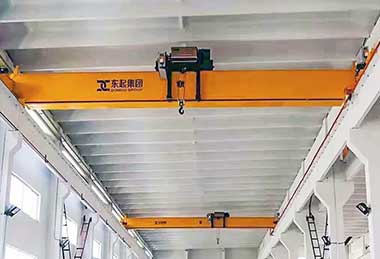
HD European Single Girder Crane
Capacity: 1-20t
- Span: 7.5-28.5m
- Lifting height: 6-18m
- Lifting speed: 0.8/5m/min
- Hoist running speed: 2-20m/min
- Crane running speed: 3-30m/min
- Work duty: A5
- Custom designs available
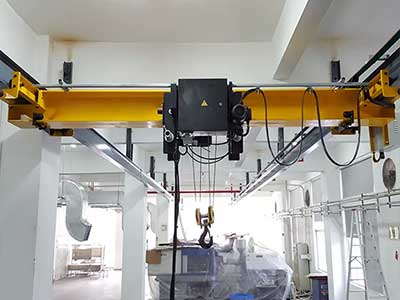
NLX Single Girder Underhung Crane
Capacity: 0.5-10t
- Span: 3-25m
- Lifting height: 6-30m
- Lifting speed: 0.7-8m/min
- Hoist running speed: 20m/min
- Crane running speed: 20m/min
- Work duty: A3, A4
- Custom designs available
Here's the information provided in a table format, organized by the type of single girder crane and its corresponding speed parameters:
Crane Type | Lifting Speed (m/min) | Hoist Running Speed (m/min) | Crane Running Speed (m/min) | Span (m) | Lifting Height (m) | Capacity (t) | Work Duty | Custom Designs Available |
LD Single Girder Overhead Crane | 0.3-8 | 20 | 20 | 7.5-35 | 6-30 | 1-25 | A3, A4 | Yes |
HD European Single Girder Crane | 0.8/5 | 2-20 | 3-30 | 7.5-28.5 | 6-18 | 1-20 | A5 | Yes |
LX Single Girder Underhung Crane | 0.7-8 | 20 | 20 | 3-25 | 6-30 | 0.5-10 | A3, A4 | Yes |
This table summarizes the key speed parameters for each type of single girder crane, including lifting speed, hoist running speed, and crane running speed, along with other specifications such as span, lifting height, capacity, work duty, and custom designs availability.
Comparison table organized by speed parameters:
Crane Type | Lifting Speed (m/min) | Hoist Running Speed (m/min) | Crane Running Speed (m/min) |
HD European Single Girder Crane | 0.8/5 | 2-20 | 3-30 |
LX Single Girder Underhung Crane | 0.7-8 | 20 | 20 |
LD Single Girder Overhead Crane | 0.3-8 | 20 | 20 |
This table organizes the crane types based on their lifting speed, hoist running speed, and crane running speed, making it easier to compare their performance in terms of speed capabilities.
General Speed of Double Girder Cranes

Parmeters of QD Double Girder Overehead Cranes
Load capacity: 5-450 tons
Span: 10.5-35 meters
Lifting height: 6-24 meters
Lifting speed: 1-15 meters per minute
Trolley running speed: 27-40 meters per minute
Crane running speed: 42-75 meters per minute
Work duty: A3-A7
Custom designs available

Parmeters of QDX Double Girder Overehead Cranes
Load capacity: 5-320 tons
Span: 10.5-35 meters
Lifting height: 6-24 meters
Lifting speed: 0.2-10.7 meters per minute
Trolley running speed: 4-33 meters per minute
Crane running speed: 2-68 meters per minute
Work duty: A3-A5
Custom designs available

Parmeters of LH Double Girder Overehead Cranes
Load capacity: 5-50 tons
Span: 10.5-35 meters
Lifting height: 6-30 meters
Lifting speed: 0.18-8 meters per minute
Trolley running speed: 20 meters per minute
Crane running speed: 20 meters per minute
Work duty: A3, A4
Custom designs available
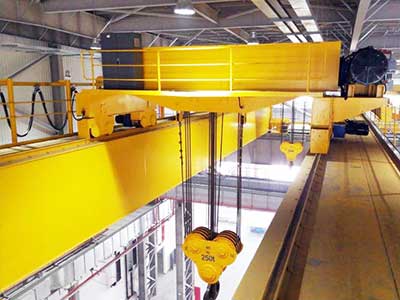
Parmeters of NLH Double Girder Overehead Cranes
Load capacity: 5-80 tons
Span: 10.5-35 meters
Lifting height: 6-18 meters
Lifting speed: 0.4-5 meters per minute
Trolley running speed: 2-20 meters per minute
Crane running speed: 3-30 meters per minute
Work duty: A5
Custom designs available
Here's the information presented in a table format:
Parameter | QD | QDX | LH | NLH |
Load Capacity (tons) | 5-450 | 5-320 | 5-50 | 5-80 |
Span (m) | 10.5-35 | 10.5-35 | 10.5-35 | 10.5-35 |
Lifting Height (m) | 6-24 | 6-24 | 6-30 | 6-18 |
Lifting Speed (m/min) | 1-15 | 0.2-10.7 | 0.18-8 | 0.4-5 |
Trolley Speed (m/min) | 27-40 | 4-33 | 20 | 2-20 |
Crane Speed (m/min) | 42-75 | 2-68 | 20 | 3-30 |
Work Duty | A3-A7 | A3-A5 | A3, A4 | A5 |
Custom Designs | Available | Available | Available | Available |
This table presents the parameters of each crane model, including load capacity, span, lifting height, lifting speed, trolley running speed, crane running speed, work duty, and custom designs availability.
Comparison table of summarizing the types of overhead cranes in terms of lifting speed, trolley running speed, and crane running speed:
Crane Type | Lifting Speed (m/min) | Trolley Running Speed (m/min) | Crane Running Speed (m/min) |
QD | 1-15 | 27-40 | 42-75 |
QDX | 0.2-10.7 | 4-33 | 2-68 |
LH | 0.18-8 | 20 | 20 |
NLH | 0.4-5 | 2-20 | 3-30 |
This table highlights the key speed parameters for each type of overhead crane.
Long Traveling Speed
Long Traveling Speed: Picture the overhead crane as it gracefully glides along its designated path, smoothly traversing the length of its rails with a sense of purpose. This fluid lateral movement, known as the long traveling speed, defines the rate at which the crane travels horizontally across the workspace.
Measured in meters per minute (m/m), the long traveling speed typically ranges from approximately 40 to 50 meters per minute. This range may vary depending on factors such as the crane's design, load capacity, and specific operational requirements. It's the fine balance between efficiency and control, ensuring that heavy loads are transported with precision and safety.
In environment of industrial facilities, the long traveling speed plays a crucial role in material handling operations. Whether it's moving raw materials to production lines or transferring finished products to storage areas, optimizing this speed is essential for maintaining workflow efficiency.
The long traveling speed isn't just about covering distances; it's about orchestrating the smooth flow of materials throughout the workspace. It sets the rhythm for operational productivity, allowing for seamless coordination between different areas of the facility.
By optimizing the long traveling speed, businesses can enhance productivity, reduce downtime, and improve overall operational efficiency. It's a vital component in the intricate dance of industrial operations, ensuring that every movement is executed with precision and purpose.
Long travelling speed of overhead cranes for handling different loads
The long traveling speed for overhead cranes can vary depending on several factors, including the type and weight of the loads being handled. Here's a breakdown of how long traveling speed may differ for different loads:
- Light Loads: For overhead cranes handling light loads, such as small components or materials, the long traveling speed may be higher. Since these loads typically pose less risk of instability or safety concerns, faster speeds can help improve overall productivity without compromising safety.
- Medium Loads: When handling medium-sized loads, such as machinery parts or palletized goods, the long traveling speed may be moderate. This ensures that the crane can still move efficiently while maintaining adequate control and stability over the load.
- Heavy Loads: For overhead cranes tasked with handling heavy loads, such as large machinery components or steel beams, the long traveling speed may be slower. Slower speeds allow for greater control and stability, reducing the risk of accidents or damage to the load and equipment.
- Variable Loads: In some cases, overhead cranes may be used to handle variable loads with varying weights. In such situations, the long traveling speed may be adjusted based on the specific load being lifted at any given time. This allows for optimal efficiency and safety while accommodating different load characteristics.
Overall, the long traveling speed for overhead cranes is often tailored to suit the specific requirements of the loads being handled, balancing factors such as productivity, safety, and load stability. It's essential for crane operators to consider these factors when determining the appropriate speed for different load-handling scenarios.
Hoisting Speed:
Ever marveled at the seamless ascent or descent of a load suspended from a crane? That's the magic of hoisting speed at work. Ranging from 6 m -25 m/minute, hoisting speed determines how quickly or slowly the crane raises or lowers its load. It's a delicate dance between power and precision, ensuring that heavy objects are maneuvered with finesse and control.
Hoisting Speed: Have you ever watched in awe as a crane effortlessly lifted or lowered a heavy load with seemingly effortless grace? That's the magic of hoisting speed in action.
Measured in meters per minute (m/min), hoisting speed typically ranges from 6 to 25 m/min. It's this speed that determines how quickly or slowly the crane raises or lowers its load. But it's not just about speed; it's about orchestrating a delicate dance between power and precision.
Whether it's lifting fragile components or moving massive machinery parts, hoisting speed plays a crucial role in maintaining stability and safety throughout the lifting process. It's about striking the perfect balance between power and precision, ensuring that every lift is executed with the utmost care and efficiency.
In world of industrial operations, hoisting speed is more than just a number – it's the key to unlocking seamless material handling and maximizing productivity. By optimizing hoisting speed, crane operators can ensure smooth operations, reduce downtime, and enhance overall efficiency in the workplace.
Factors Affecting Crane Speed
Crane speed isn't just about setting a number on a dial – it's a delicate balance influenced by various factors. Let's explore the key elements that shape the velocity of electric overhead cranes:
- Load Capacity: The weight of the load being lifted is a fundamental factor in determining crane speed. Heavier loads require slower speeds to maintain stability and ensure safe handling. It's a balancing act between power and precision, where the crane's capabilities must align with the demands of the workload.
- Acceleration and Deceleration Rates: Ever tried to stop a speeding train on a dime? The same principle applies to cranes. Acceleration and deceleration rates influence how quickly the crane can reach its desired speed and come to a halt safely. Smooth transitions are essential to prevent jolts and jerks that could compromise load stability and operator safety.
- Dynamic Loading: In the dynamic world of industrial settings, cranes often face sudden starts, stops, or changes in direction. These dynamic loading conditions can affect the crane's speed capabilities, requiring adjustments in operation to maintain efficiency and safety. It's a constant dance between momentum and control, where adaptability is key.
- Regulatory Standards: Just as every road has a speed limit, every region has regulations governing crane speed. Compliance with these standards is essential to ensure safety and legality in industrial operations. From maximum speeds to safety protocols, adhering to regulatory standards helps mitigate risks and maintain operational integrity.
- Maintenance and Inspection: Like any machine, cranes require regular upkeep to perform at their best. Maintenance and inspection routines ensure that crane components are in optimal condition, preserving performance and speed characteristics. From motors to brakes, attention to detail is crucial for smooth operations and longevity.
- Operator Training: Behind every crane is an operator steering the course. Proper training is vital for safe operation, empowering operators with the knowledge and skills to control speed and navigate potential hazards. From understanding speed limitations to executing emergency procedures, operator training is the linchpin of crane safety and efficiency.
By considering these factors, crane users can optimize speed settings to meet the demands of their specific applications while prioritizing safety and compliance. But the journey doesn't end here – stay with us as we explore speed control options and customization opportunities to unlock the full potential of electric overhead cranes.
Speed Control Options
When it comes to electric overhead cranes, controlling speed is more than just flicking a switch. Let's dive into the different options available for fine-tuning crane velocity:
- Variable Frequency Drive (VFD): Think of VFD as the maestro of crane speed control. By adjusting the frequency of the electrical supply to the crane's motor, VFDs offer unparalleled precision in regulating speed and acceleration. This makes them ideal for applications that demand frequent speed changes or require precise positioning of loads. Whether it's delicately maneuvering fragile materials or swiftly transporting heavy payloads, VFDs orchestrate seamless movements with finesse.
- Two-Speed Controls: If VFDs are the virtuosos, then two-speed controls are the reliable workhorses of crane speed regulation. Simple and cost-effective, these systems offer basic control over crane speed by toggling between two predefined settings – typically high and low speeds. While lacking the finesse of VFDs, two-speed controls are still capable of getting the job done efficiently, making them suitable for less demanding applications where precise speed control is not critical.
- Choosing the right speed control option depends on factors such as application requirements, budget constraints, and the level of precision needed. Whether opting for the sophistication of VFDs or the simplicity of two-speed controls, the goal remains the same: to optimize crane performance while ensuring safety and efficiency in industrial operations.
Advantages and Limitations of Crane Speed Control:
Variable Frequency Drive (VFD):
Advantages:
Precision: VFDs offer unparalleled precision in regulating crane speed and acceleration, allowing for smooth and precise movements.
Flexibility: They allow real-time adjustments to match the demands of the task, making them suitable for applications that require frequent speed changes or precise positioning of loads.
Efficiency: VFDs optimize energy consumption by adjusting motor speed based on load requirements, resulting in energy savings.
Safety: Precise speed control enhances safety by minimizing the risk of accidents and damage to loads.
Limitations:
Cost: VFDs can be more expensive to install and maintain compared to other speed control methods.
Complexity: They require specialized knowledge for installation, programming, and troubleshooting, which may increase complexity.
Maintenance: Regular maintenance is essential to ensure proper functioning of VFDs, adding to operational costs.
Two-Speed Controls:
Advantages:
Simplicity: Two-speed controls are simple and straightforward, making them easy to install and operate.
Cost-Effective: They are typically more affordable compared to VFDs, making them suitable for budget-conscious applications.
Reliability: Two-speed controls offer reliable performance and are less prone to technical issues compared to more complex systems.
Suitability: They are suitable for applications where precise speed control is not critical, such as basic material handling tasks.
Limitations:
Limited Precision: Two-speed controls lack the precision and flexibility of VFDs, making them less suitable for tasks that require precise positioning or frequent speed changes.
Energy Efficiency: They may not optimize energy consumption as effectively as VFDs since motor speed is fixed at predefined settings.
Limited Applications: Two-speed controls may not be suitable for applications that require advanced speed control features or where safety regulations mandate precise speed regulation.
Typical Applications:
Variable Frequency Drive (VFD):
Precision material handling tasks requiring accurate positioning of loads, such as assembly lines and manufacturing processes.
Operations with varying load conditions that require frequent speed changes, such as warehouses with diverse product handling needs.
Applications where energy efficiency is a priority, such as facilities aiming to reduce electricity consumption and operating costs.
Two-Speed Controls:
Basic material handling tasks with consistent load conditions, such as moving palletized goods in warehouses.
Applications where simplicity and reliability are valued over precision, such as small-scale manufacturing operations or construction sites.
Budget-conscious projects where cost-effective solutions are preferred, such as small businesses or temporary installations.
How to Select for Your Needs:
Evaluate Requirements: Assess your specific application requirements, including load characteristics, frequency of speed changes, and precision needed for positioning.
Consider Budget: Determine your budget constraints and weigh the cost of different speed control options against their benefits.
Assess Complexity: Consider the level of technical expertise available for installation, programming, and maintenance of the chosen speed control system.
Prioritize Safety: Ensure that the selected speed control method meets safety regulations and standards for your application.
Consult Experts: Seek advice from crane manufacturers or engineering professionals to help determine the most suitable speed control option for your needs.
Ultimately, the choice between VFDs and two-speed controls depends on a variety of factors, including application requirements, budget considerations, and safety regulations. By carefully evaluating these factors and considering the advantages and limitations of each speed control method, you can select the option that best meets your specific needs and objectives.
Typical Loads Handled by Each Type of Overhead Crane Speed Control:
Variable Frequency Drive (VFD):
Precision Components: VFD-controlled overhead cranes excel in handling precision components used in manufacturing industries, such as small mechanical parts, electronic components, and delicate assemblies. These cranes provide precise control over speed and acceleration, ensuring that fragile or intricate components are moved with utmost care and accuracy.
Fragile Materials: Industries dealing with fragile materials like glass, ceramics, or specialized electronic components rely on VFD-controlled cranes for safe and gentle handling. These cranes offer smooth movements and adjustable speeds, minimizing the risk of damage during lifting, positioning, and transportation.
Variable Load Conditions: Warehouses and distribution centers with diverse product sizes and weights benefit from VFD-controlled overhead cranes. These cranes can efficiently handle a wide range of loads, from lightweight packages to heavy pallets, by adjusting speed and acceleration as needed to accommodate varying load conditions.
High-Capacity Loads: In heavy industries such as steel manufacturing, shipbuilding, or automotive production, VFD-controlled cranes are used to lift and transport large and heavy components. These cranes provide precise control over speed and acceleration, allowing for safe and efficient handling of high-capacity loads like steel coils, machinery parts, or vehicle chassis.
Two-Speed Controls:
Bulk Materials: Two-speed control overhead cranes are commonly employed in industries dealing with bulk materials such as aggregates, sand, gravel, or bulk liquids. These cranes are used for loading and unloading materials from trucks or railcars, as well as transferring materials within storage yards or processing facilities.
General Warehousing: In general warehousing and logistics operations, two-speed control cranes are used for handling standard palletized goods, containers, and packages. These cranes facilitate the movement of goods within warehouses, distribution centers, and storage facilities, providing reliable and cost-effective material handling solutions.
Construction Materials: Construction sites utilize two-speed control cranes for lifting and moving construction materials such as bricks, lumber, concrete blocks, roofing materials, and piping. These cranes assist in various construction tasks, including material delivery, assembly, and installation, where precise speed control is not critical, but reliability and durability are essential.
Routine Maintenance: In industrial facilities, two-speed control cranes are often employed for routine maintenance tasks, including equipment servicing, tool handling, and material transport within production areas. These cranes provide straightforward and efficient material handling solutions for day-to-day operations, ensuring smooth workflow and operational continuity.
In essence, the choice between VFD-controlled and two-speed control overhead cranes depends on the specific requirements of the application, including the type of materials handled, precision and flexibility needed, and budget considerations. Both types of cranes offer distinct advantages and are tailored to meet the diverse needs of different industries and operational environments.
Examples Selection of Cranes Speed: Mold Handling
Mold handling
Variable Frequency Drive (VFD):
For handling molds in manufacturing processes, VFD-controlled overhead cranes offer precise speed control to ensure delicate handling. These cranes can adjust their speed and acceleration to match the requirements of each mold, whether it's a lightweight mold for small components or a heavier mold for larger parts. With VFDs, operators can navigate through tight spaces and intricate pathways with finesse, minimizing the risk of collisions or damage to the molds. This level of control is crucial in industries such as plastics manufacturing, where molds are critical components in the production process and require careful handling to maintain their integrity and prolong their lifespan.
Two-Speed Controls:
Two-speed control overhead cranes are also suitable for handling molds, particularly in applications where precision speed control is not as critical. These cranes provide reliable and straightforward handling of molds, allowing operators to toggle between high and low speeds based on the size and weight of the molds being transported. While they may lack the precision of VFD-controlled cranes, two-speed control cranes offer cost-effective solutions for moving molds within production areas or between storage locations. They are commonly used in foundries, metalworking shops, and other industrial settings where molds are integral to the manufacturing process and need to be transported efficiently.
Customization and Optimization
In the world of electric overhead cranes, one size doesn't fit all. Let's explore how customization and optimization play a crucial role in tailoring crane speed to meet specific operational needs:
Load Profile Analysis: Every workload tells a story, and understanding that story is key to unlocking the optimal speed settings for your crane. By analyzing the load profile – including factors such as weight, size, and frequency of lifts – operators can determine the required speed and acceleration parameters. Whether it's handling bulky materials or delicate components, aligning crane speed with the demands of the workload ensures smooth and efficient operations.
Load Profile Analysis:
In overhead crane operation, every workload carries its unique narrative, and deciphering that narrative is pivotal in setting the perfect speed settings for your crane. Load profile analysis dives deep into understanding this story, encompassing a comprehensive examination of factors such as weight, size, and frequency of lifts.
Imagine peering into the intricate details of your production line, where each load presents its own set of challenges and requirements. Load profile analysis allows operators to decode these intricacies, identifying patterns and trends that shape the optimal speed and acceleration parameters for crane operation.
For instance, when handling bulky materials, such as steel beams or machinery components, load profile analysis helps determine the ideal speed settings to ensure efficient movement while maintaining load stability and safety. On the other hand, delicate components demand a more delicate approach, where precise speed control is essential to prevent damage during lifting and transportation.
By aligning crane speed with the demands of the workload, load profile analysis lays the foundation for smooth and efficient operations. It empowers operators to navigate through the complexities of material handling with confidence, ensuring that each lift is executed with precision and care.
In essence, load profile analysis is the roadmap to optimizing crane performance, guiding operators towards the perfect balance between speed, safety, and efficiency. It's the key to unlocking the full potential of overhead crane operations, ensuring seamless workflow and productivity in industrial settings.
Consultation with Experts:
Sometimes, it takes a village to optimize crane performance. That's where crane manufacturers and engineers come into play. By tapping into their expertise, users can gain valuable insights into customizing speed settings to suit specific operational needs. Whether it's fine-tuning VFD parameters or optimizing control system configurations, expert guidance can pave the way for enhanced efficiency and productivity.
Crane manufacturers and engineers possess a deep understanding of crane systems and technologies. They can offer valuable advice on customizing speed settings, fine-tuning VFD parameters, and optimizing control system configurations. This level of expertise ensures that crane operations are fine-tuned to achieve maximum efficiency and productivity.
Whether it's optimizing the acceleration curve for smoother movements or adjusting speed limits to accommodate unique load profiles, expert consultation enables users to navigate complex challenges with confidence. By leveraging their knowledge and experience, users can implement tailored solutions that address specific operational needs while maximizing crane performance.
In essence, consultation with experts serves as a strategic partnership, empowering users to harness the full potential of their crane systems. It's a collaborative approach that fosters innovation, efficiency, and continuous improvement in industrial operations.
Safety Considerations:
In the fast-paced world of industrial settings, safety always comes first. Customized crane speeds must prioritize safety, ensuring load stability and operator protection at all times. From setting speed limits to implementing fail-safe mechanisms, safety considerations should remain paramount throughout the customization process. After all, a well-optimized crane is not only efficient but also safe to operate.
Customized crane speeds should prioritize load stability and operator protection at all times. This involves carefully setting speed limits that align with the capabilities of the crane and the characteristics of the load being handled. Additionally, implementing fail-safe mechanisms, such as emergency stop buttons and overload protection systems, adds an extra layer of safety to crane operations.
Throughout the customization process, safety considerations should be integrated into every decision and adjustment. Whether it's fine-tuning speed settings or optimizing acceleration profiles, every modification should be evaluated in terms of its impact on safety.
A well-optimized crane not only enhances efficiency but also ensures the safety of everyone involved in its operation. By prioritizing safety considerations, users can create a work environment where crane operations are conducted with confidence and peace of mind.
In conclusion, safety should always be at the forefront when customizing crane speeds. By incorporating safety measures into the customization process, users can achieve a balance between efficiency and safety, creating a workplace environment that is both productive and secure.
By embracing customization and optimization, crane users can harness the full potential of their equipment, maximizing efficiency and productivity while ensuring safety and compliance. But the journey doesn't end here – stay tuned as we delve deeper into maintenance and safety considerations to keep your crane operating at peak performance.
Maintenance and Safety
In electric overhead cranes, maintenance and safety go hand in hand. Let's explore how prioritizing maintenance and safety considerations can ensure smooth operations and protect both equipment and personnel:
- Regular Inspections: Just like a well-oiled machine, cranes require regular check-ups to ensure they're operating at peak performance. Regular inspections are essential for identifying any wear and tear on components that could affect speed and performance. From motors to brakes, a thorough inspection regimen can nip potential issues in the bud, keeping your crane running smoothly and efficiently.
- Emergency Stop Procedures: In the fast-paced environment of industrial settings, emergencies can happen in the blink of an eye. That's why it's crucial for operators to be trained on emergency stop procedures to halt the crane safely in case of unforeseen circumstances. Whether it's a malfunction or a safety hazard, quick and decisive action can prevent accidents and protect both personnel and equipment.
- Compliance with Standards: Safety knows no shortcuts, and adherence to regulatory standards is non-negotiable when it comes to crane operations. By complying with regional regulations governing crane speed and safety protocols, users can maintain both safety and legality in industrial settings. From maximum speed limits to safety protocols, staying abreast of regulatory standards is essential for ensuring operational integrity and mitigating risks.
By prioritizing maintenance and safety considerations, crane users can ensure smooth operations and protect both equipment and personnel from harm. From regular inspections to emergency preparedness, a proactive approach to maintenance and safety is the cornerstone of a safe and efficient work environment.
With this comprehensive guide, we've explored the intricacies of electric overhead crane speed, from specifications and control options to customization and optimization. By understanding the factors influencing crane speed and prioritizing maintenance and safety considerations, users can unlock the full potential of their equipment while ensuring safety and compliance in industrial settings.
Conclusion:
In the industrial operations, electric overhead crane speed stands as a critical cornerstone of efficiency and safety. Through this comprehensive exploration, we've uncovered the vital role that crane speed plays in ensuring smooth and productive operations in industrial settings.
By delving into speed specifications, understanding the factors influencing speed, exploring speed control options, and embracing customization opportunities, buyers and users alike can unlock the full potential of their electric overhead cranes. From precise positioning to swift transportation of heavy loads, optimizing crane speed is essential for maximizing productivity while prioritizing safety and compliance with regulatory standards.
Moreover, we've underscored the importance of maintenance and safety considerations in safeguarding both equipment and personnel. From regular inspections to emergency stop procedures and compliance with regulatory standards, a proactive approach to maintenance and safety is paramount in ensuring smooth operations and mitigating risks in industrial environments.
In conclusion, electric overhead crane speed is not just about numbers on a dial – it's a critical factor that drives efficiency, productivity, and safety in industrial settings. By understanding the nuances of crane speed and embracing best practices in maintenance and safety, buyers and users can navigate the complex landscape of industrial operations with confidence and success.



